Australian
and international
exploratory
performance and
media arts
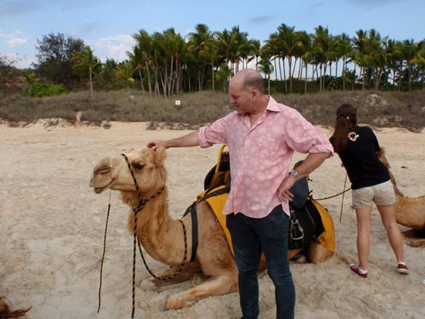
Stephen Carleton
courtesy the writer
Stephen Carleton
Bio
I began writing (and reviewing) for the theatre during student days at La Trobe University, Melbourne and was part of a queer political theatre collective called Gudrun’s Stockings that did work at La Mama, Midsumma and elsewhere. I formed Knock-em-Down Theatre in Darwin in 1997 with Gail Evans (we have since been joined by Mary Anne Butler) and have been writing professionally for the stage in Queensland, the NT and indeed nationally ever since. Career highlights include winning the Patrick White Playwrights’ Award in 2005 for my play Constance Drinkwater and the Final Days of Somerset and the New York New Dramatists Fellowship in 2006. These days I am based in Brisbane where I am currently head of Drama at UQ and teach across our broad historical program. Areas of research in my writing for the stage, my critical reviewing and my scholarly work include cultural geography, Australian theatre studies, Gothic theatre studies and postcolonial theatre.
Exposé
I’m describing myself first and foremost as a cultural geographer these days. This is a result, perhaps, of growing up in regional Australia (Far North Queensland and Darwin), where there was absolutely no literature, theatre, visual art, film or TV on the school curriculum that depicted the part of the country that I grew up in. Ray Lawler’s cane fields and Nicolas Roeg’s screen outback were the closest I ever got to a recognisable Australia during my early education. I resolved at a relatively early age—as a teenager, I reckon—to be part of the solution and to dedicate myself to ‘mapping’ my North Australia through critical and creative praxis.
It’s a genuine passion and lifelong commitment for me to see North Australian creative and cultural content build and take its place in the national conversation, whether my role in that process be as playwright, theatre critic, academic researcher or dramaturg of other writers’ practice. I am deeply interested in writers and performance makers who interrogate the geographical and political context in which they are generating work. This connectivity with audiences, location and the polity at large seems so much more vital to me than solipsistic and esoteric self-reflection or the communication of nothing to no one. That potentially sounds like a mundane statement of the self-evident, but I guess what I’m saying is that my passion is for live performance that seeks out an audience for an intelligent, adult conversation about the world from which it has been germinated. I’m also happy for comedy, satire and wit to be part of that interrogation.
Recent articles
Mercenary or hero?
Stephen Carleton: QTC, Mother Courage and Her Children
RealTime issue #116 Aug-Sept 2013 p44
Embracing the world
Stephen Carleton: Brisbane Powerhouse, World Theatre Festival
RealTime issue #114 April-May 2013 p45
Staging the really virtual
Stephen Carleton: A Hoax, La Boite; Making The Green One Red, QUT
RealTime issue #109 June-July 2012 p30
Reviews of Stephen Carleton’s Constance Drinkwater and the Final Days of Somerset
Regenerative inversions
Douglas Leonard
RealTime issue #75 Oct-Nov 2006 p8
NT’s festive season
Suzanne Spunner, 2007 Darwin Festival
RealTime issue #81 Oct-Nov 2007 p6
Six artists, each in a room in the Grong Grong Motor Inn in the Riverina for a week in August, created works you can sample in a video about the project.
Video produced, edited and shot by Darrin Baker
You can also see more detail about works by
Scott Howie
Sarah McEwan
Darrin Baker
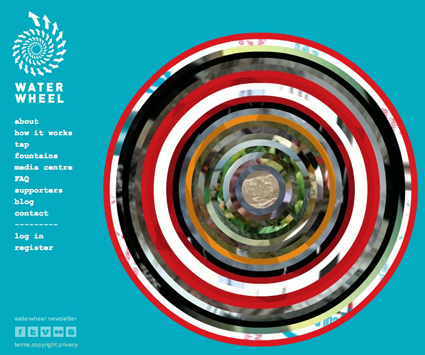
Waterwheel
Waterwheel Symposium Call for Participation
Waterwheel is an online platform for interdisciplinary discussions, performance and interaction around the subject of water (see our interview with founder Suzon Fuks). Waterwheel is currently calling for proposals from artists, scientists and thinkers to present artworks, performances and papers at the next symposium in March 2014 focusing on the theme “Water Views—Caring and Daring.” Proposals are also invited from young people (under 18 years) to take part in their Voice of the Future Youth Day.
Proposals for Symposium due 22 Nov; proposals for Voice of the Future Youth Day, 31 Dec; http://water-wheel.net/
Editor, Un Magazine
Un Projects, producer of the very neat and informative Melbourne-based art magazine, is seeking an editor for their two issues in 2014. Editions are published June & Nov and there is a fee of $3000 per edition.
Applications due 25 November 2013; http://unprojects.org.au/magazine/contribute/
Courthouse Arts Visual Arts Program
Courthouse Arts in Geelong is seeking expressions of interest from individuals or artist collectives aged 12-26 who are interested in curating the venue’s 2014 visual arts program.
EOIs due 15 Nov; http://courthouse.org.au/on-now/searching-for-a-young-curator-for-2014/
CCP Salon 2013
Now in its 21st year the CCP Salon (presented by Leica and Ilford ) is Austalia’s largest open-entry, photo-media exhibition and competition. There’s $20,000 in prize money up for grabs across 23 categories and the entry deadline has been extended.
Deadline 8 Nov; http://www.ccp.org.au/salon_2013.php
Still in the loop
AEAF—emerging + experimental curators
Applications due 8 Nov
www.eaf.org
Renew Sydney: Leichhardt
Proposals due 8 Nov
http://www.renewaustralia.org/2013/10/renew-australia-comes-to-sydney-with-renew-leichhardt/
First Draft Directors 2014-2015
Deadline 8 Nov
http://firstdraftgallery.com/get_involved/firstdraftwantsyou
Selected Australia Council Grant Deadlines
(for full list go to http://www.australiacouncil.gov.au/grants
Music: Presentation and Promotion – 18 November 2013
http://www.australiacouncil.gov.au/grants/2013/music-presentation-and-promotion-18-november
Music: New Work – Writing and Recording – 18 November 2013
http://www.australiacouncil.gov.au/grants/2013/music-new-work-writing-and-recording-18-november
Aboriginal and Torres Strait Islander: Skills and Arts Development –
19 November 2013
http://www.australiacouncil.gov.au/grants/2013/aboriginal-and-torres-strait-islander-arts-skills-and-arts-development-19-november
Aboriginal and Torres Strait Islander: Presentation and Promotion-
19 November 2013
http://www.australiacouncil.gov.au/grants/2013/aboriginal-and-torres-strait-islander-arts-presentation-and-promotion-1-april
Aboriginal and Torres Strait Islander: The Dreaming Award –
19 November 2013
http://www.australiacouncil.gov.au/grants/2013/dreaming-award
Aboriginal and Torres Strait Islander: Fellowships –
19 November 2013
http://www.australiacouncil.gov.au/grants/2013/aboriginal-and-torres-strait-islander-arts-fellowships
Aboriginal and Torres Strait Islander: The Red Ochre Award –
19 November 2013
http://www.australiacouncil.gov.au/grants/2013/red-ochre-award
Aboriginal and Torres Strait Islander: New Work –
19 November 2013
http://www.australiacouncil.gov.au/grants/2013/aboriginal-and-torres-strait-islander-arts-new-work-19-november
Visual Arts Travel Fund – 25 November 2013
http://www.australiacouncil.gov.au/grants/2013/Visual-Arts-Travel-Fund
Contemporary Music Touring Program – 25 November 2013
http://www.australiacouncil.gov.au/grants/2013/contemporary-music-touring-program-25-november
RealTime issue #117 Oct-Nov 2013 pg. web
© RealTime ; for permission to reproduce apply to realtime@realtimearts.net
![1) 7bit Hero; 2) Sha Sarwari, Asylum Seeker; Vidhi Shah and Jeniffer Heng, Flow[er]; 2high Festival](https://www.realtime.org.au/wp-content/uploads/art/70/7091_2high.gif)
1) 7bit Hero; 2) Sha Sarwari, Asylum Seeker; Vidhi Shah and Jeniffer Heng, Flow[er]; 2high Festival
courtesy the artists
1) 7bit Hero; 2) Sha Sarwari, Asylum Seeker; Vidhi Shah and Jeniffer Heng, Flow[er]; 2high Festival
2high Festival, Brisbane Powerhouse
Curated by young and emerging producers under the watchful eye of Backbone Arts the 2high Festival is a one-day explosion of music, visual arts and performance that will take over the Brisbane Powerhouse complex. Highlights look to be the part pop concert, part video game experience of 7bit Hero (http://7bithero.com/) where the audience can use their phones as joysticks to participate in the game that plays behind the live band. Afghani refugee Sha Sarwari will exhibit his three-metre boat made entirely from newspapers and Vidhi Shah and Jeniffer Heng have created a flower from recycled electrical materials which blossoms in your presence. There are also back-to-back dance and theatre performances from emerging makers such as Matt O’Neill, Robert Millet, Dead Owl Factory, Courtney Scheu & Mariana Paraizo.
Backbone Arts: 2high Festival, Brisbane Powerhouse, 2 Nov, http://2highfestival.com.au/
Carnival of the Bold, Changemakers Festival
The Changemakers Festival is an umbrella structure (run by Social Innovation Xchange) linking a plethora of activities around Australia seeking social change and the building of better communities. One of these events, Carnival of the Bold at the New Theatre, Newtown, brings together “artists and other leaders who drive important issues of our time—to create deeper engagement around social causes” (website). The event will feature talks and performances by political satirist Simon Hunt aka Pauline Pantsdown, Indigenous artist and activist Adam Hill aka Blak Douglas, social change photographer Mikey Leung and children’s book author Melanie Lee in an evening hosted by that cultural chameleon Paul Capsis.
Changemakers Festival, national 1-10 Nov; http://changemakersfestival.org/; Carnival of the Bold, New Theatre, Newtown, 9 Nov; http://changemakersfestival.org/event/carnival-of-the-bold/
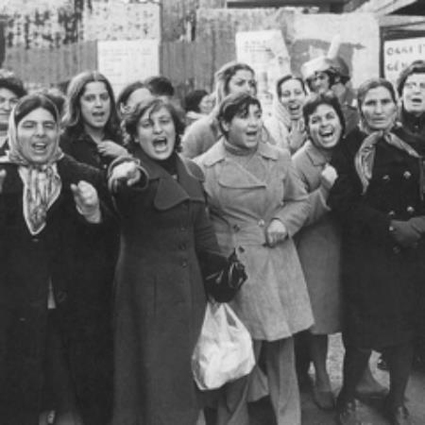
My Avant-Garde Is Bigger Than Yours, Kings ARI
courtesy the gallery
My Avant-Garde Is Bigger Than Yours, Kings ARI
My Avant-Garde Is Bigger Than Yours, Kings ARI
At the now decade-old Kings ARI, My Avant-Garde Is Bigger Than Yours, curated by Nik Papas, investigates humour, sarcasm, irony and parody using as a starting point Sigmund Freud’s Jokes and their Relation to the Unconscious (1905). Delivering a barrel of art laughs will be Boe-Lin Bastian, Damiano Bertoli, Jessie Bullivant, Cheryl Conway, DAMP, Sue Dodd, Marco Fusinato, Tamsin Green, Raafat Ishak, Danius Kesminas, Yvette King, Lucas Maddock and Madé Spencer-Castle.
My Avant-Garde Is Bigger Than Yours, Kings ARI, 1-23 Nov 2013; http://www.kingsartistrun.com.au/
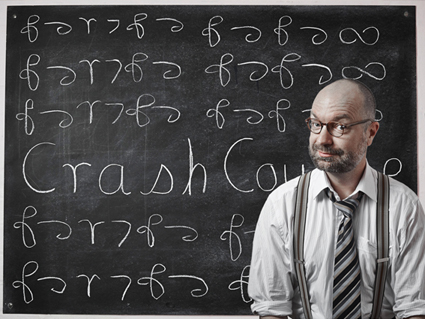
James Berlyn, Crash Course
Crash Course, James Berlyn
Following the success of last week’s Proximity Festival which he co-founded, James Berlyn is about to present his own intimate, participatory theatre piece (see the forthcoming review in RT118). Based on his experience as an English teacher and utilising his own fictional language, Winfein, Berlyn’s Crash Course takes 24 audience members on a performative language learning expedition.
Crash Course, creator/performer James Berlyn, director Nikki Heywood, producer Performing Lines WA, PICA, 14-30 Nov; http://www.pica.org.au/view/Crash+Course/1745/
![Asiga, [CTRL][P] Objects on Demand](https://www.realtime.org.au/wp-content/uploads/art/70/7096_loop_object.jpg)
Asiga, [CTRL][P] Objects on Demand
courtesy of the Artist (COTA)
Asiga, [CTRL][P] Objects on Demand
[CTRL][P] Objects on Demand, Object Gallery
Once a near-future speculation, 3D printing is rapidly become part of our now. While we don’t yet all have our own personal 3D fabricator, it probably won’t be long. While you’re waiting for them to appear in Officeworks, you can pop into Object Gallery which, with the help of Courtesy the Artist (COTA), has been transformed into a 3D printing hub. Designers-in-residence Cinnamon Lee, Angus Deveson, Mitchell Bailey and Cesar Cueva will be creating objects, manufactured on demand, to be exhibited and sold in a pop-up shop. There will also be workshops where professional designers and the general public can try out the technology.
[CTRL][P] Objects on Demand, Object Gallery 15 Oct 2013 – 25 Jan 2014; http://www.object.com.au/exhibitions-events/entry/ctrl_p_objects_on_demand/; http://ctrlp.com.au/
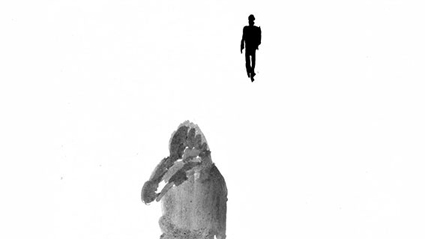
Lorraine Heller-Nicholas, Love Story
Lorraine Heller-Nicholas, Love Story, Videobrasil
Melbourne-based animator Lorraine Heller-Nicholas is one of two Australian artists invited to exhibit as part of Videobrasil’s Southern Panoramas program (the other is Paris-based Bridget Walker). Heller-Nicholas’ 13-minute animation using ink drawing, with sound by Alice Hui-Sheng Chang, explores the cycle of love and heartbreak with a poignancy that comes from simplicity and repetition. You can view it and more of the artist’s work here.
Southern Panoramas, 6 Nov-2 Feb; http://site.videobrasil.org.br/festival/arquivo/festival/programa/1589140
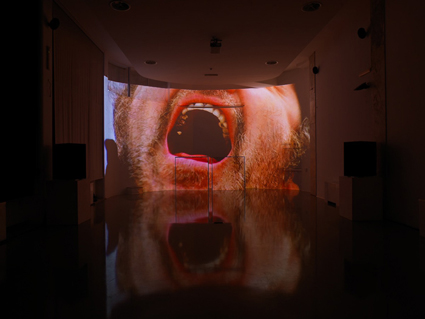
Daniele Puppi, CINEMA RIANIMATO N.3, 2012, audio-visual installation, images from The Shout–a film by Jerzy Skolimowski
courtesy the artist and Magazzino Gallery, Rome
Daniele Puppi, CINEMA RIANIMATO N.3, 2012, audio-visual installation, images from The Shout–a film by Jerzy Skolimowski
Daniele Puppi 432 Hertz, Cinema Rianimato e Dintorni, AEAF
Rome-based artist Daniele Puppi is currently in residence at Adelaide’s AEAF presenting his first major solo show in Australia. His large-scale audiovisual installations “envelop the viewer with their physicality and stage mundane, everyday actions as profound” (website). Information is hard to find on this elusive artist so we suggest attending his artist talk, Nov 1.
Daniele Puppi 432 Hertz, AEAF, 1 Nov-7 Dec; http://www.aeaf.org.au/exhibitions/danielepuppi.html
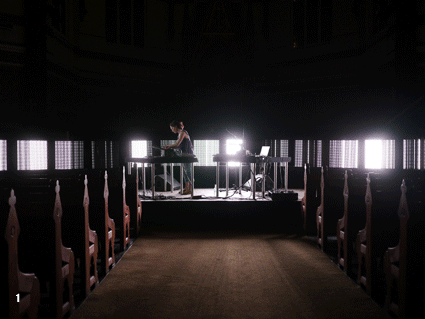
1) Voice, Maja Solveig Kjelstrup Ratkje, photo HC Gilje; 2) Yannis Kyriakides, The Buffer Zone, photo Peter Kiers; 3) Michaela Davies, Compositions for Involuntary Strings, courtesy the artist; Sonica 2013
Sonica, Glasgow
For those in the UK, the second installment of Sonica looks very impressive. Produced by Cryptic, the festival presents a weekend of “sonic art for the visually minded” (press release) including the UK premier of the audio-visual duet by Maja Solveig Kjelstrup Ratkje and light designer HC Gilje (Norway) and a multimedia opera by Yannis Kyriakides, The Buffer Zone, using field recordings from Cyprus of UN soldiers, nature and military technology combined with piano and cello. French artists Robin Meir and Ali Momeni will harness the mating behaviour of live mosquitoes in their interactive installation Truce: Strategies for Post-Apocalyptic Computation. Sonica also features an artist-in-residence and the curators seem to like Australians. Last year it was Robin Fox and this year it’s Michaela Davies who will be presenting her Compositions for Involuntary Orchestra. See our recent In Profile article for more.
Cryptic: Sonica, curators Cathie Boyd, Graham McKenzie and Patrick Dickie; 31 Oct-3 Nov; http://www.sonic-a.co.uk/
Still in the loop
Simple Forces, Joyce Hinterding
BreenSpace
25 Oct-23 Nov
http://www.breenspace.com/
Reinventing the Wheel: the Readymade Century
MUMA
3 Oct-14 Dec
http://www.monash.edu.au/muma/exhibitions/upcoming/readymade.html
The Double World, tranSTURM
Newington Armory, Sydney Olympic Park
19 Oct-10 Nov
http://www.sydneyolympicpark.com.au/whats_on/arts_and_culture_events/exhibition_the_double_world_spr13
http://cargocollective.com/transturm/the-double-world
Bogong ELECTRIC
Bogong Village, North East Victoria
1 Nov-1 Dec
http://bogongsound.com.au/
RealTime issue #117 Oct-Nov 2013 pg. web
© RealTime ; for permission to reproduce apply to realtime@realtimearts.net
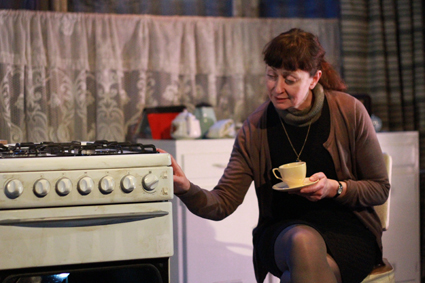
Caroline Lee, A Kind of Fabulous Hatred
photo Daisy Noyes
Caroline Lee, A Kind of Fabulous Hatred
In staging Barry Dickins’ fantastical script about Sylvia Plath’s suicide, director Laurence Strangio, contracts the expansive 45 Downstairs warehouse space into an intimate pocket; one situated before a foreboding barred window. Imaginatively transposed to London, England, February 11, 1963, the audience is further seduced by an attention to detail that often characterises Strangio’s directorial efforts.
Mattea Davies’ design is a microcosm of Sylvia Plath’s mental duress: punitive order set amongst emotional chaos, and accentuated by a Shakespearean storm that, apparently, was the worst ever recorded at that time in England. Thankfully, centre-stage is not consistently occupied by a self-gratifying human presence; instead there is a gas oven inside which a luminous pilot light reminds the audience that this appliance is both heater and exterminator. Plath was arguably of Jewish descent and, as in history, her grasp on life is as tenuous as the arbitrary decision that underpinned the Holocaust. Sylvia Plath will die tonight: this will be the celebrated poet’s last night on earth.
But before Plath dies she targets with vituperative animosity those, and those things, that she believes have contributed to, if not caused, her incandescent unhappiness. Here, Dickins’ florid script enters remarkable territory. But not before Caroline Lee as Sylvia Plath hurls bolts of disdain at writing and poetry, poets and writers, the banality of motherhood, publishers, miserable London winters, her miserable self and, by extension, British poet laureate, academic and adulterous husband, Ted Hughes. Dickins’ phantasmagoria of Plath’s demise proffers a Jungian framework for understanding her predicament. Alone in her London flat while Hughes is apparently out porking one of his literature students, Plath’s absent husband becomes the dominant subject of a diatribe against her inability to reconcile a very personal hatred of her own masculine persona. Hughes is simply the transparent figure in the mirror, behind which lurks Sylvia Plath’s divided and irreconcilable self.
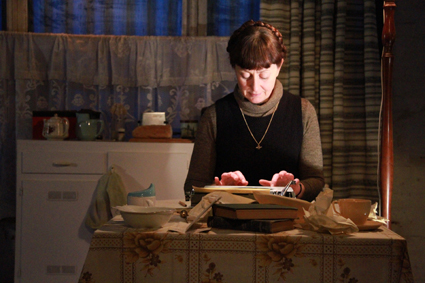
Caroline Lee, A Kind of Fabulous Hatred
photo Daisy Noyes
Caroline Lee, A Kind of Fabulous Hatred
Quite possibly, self-loathing kills more people than Jack the Dancer. Dickins understand this, and by concentrating Plath’s hatred for others upon herself, his decision to write an embellished, interior monologue, irrespective of the difficulties associated with performing such, is, in retrospect, both insightful and accurate. Form should reflect content.
But a difficult night in the theatre is one not easily justified. Sometimes, though, an audience should be prepared to sacrifice cosy entertainment for the demands of understanding the pathology of one of the 20th century’s more controversial poets and a prominent literary figure. Dickins, too, has made sacrifices. A Kind of Fabulous Hatred is a serious work from an Australian writer who is sometimes perceived as a nostalgic humourist. I don’t necessarily agree with this view. There is, I believe, more to Dickins’ writing than meets the ‘I.’ The usual Dickins’ idiosyncrasies are few here. A Kind of Fabulous Hatred is a provocative play that grapples with, and illuminates, clinical depression; a mental health condition that, for reasons prejudicial and economic, remains a lingering taboo in the 21st century.
A Kind of Fabulous Hatred, writer Barry Dickins, director Laurence Strangio, performer Caroline Lee, design Mattea Davies, lighting Bronwyn Pringle, sound Anita Hustas, 45 Downstairs, Melbourne, 12-22 Sept; http://www.fortyfivedownstairs.com/
RealTime issue #117 Oct-Nov 2013 pg. web
© Tony Reck; for permission to reproduce apply to realtime@realtimearts.net
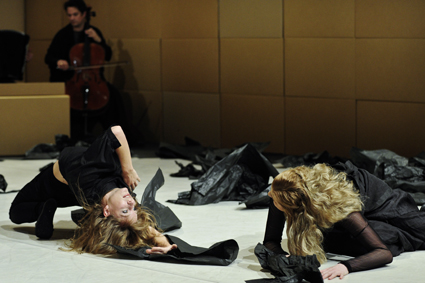
Abandon, Opera Queensland & Dancenorth
photo Bottlebrush Studios
Abandon, Opera Queensland & Dancenorth
The very title, Abandon, suggests the necessity to forsake any expectation of a cohesive narrative in Opera Queensland and Dancenorth’s recent collaboration in Townsville. The sensual elements of music, song, movement, lighting, costume and set conspired to take the viewer somewhere ancient and otherworldly; to ply them with a sequence of potent, if inexplicable, experiences; to risk whatever response might be incurred by such an open offering. Few were unmoved. My companion was in tears.
Abandon, though it courts an internal, emotional storm in its absence of narrative structure, has a finely honed aesthetic nonetheless. Dancenorth artistic director Raewyn Hill’s trademark richness-by-understatement was further enhanced by the deceptive plainness of the box-walled set, papered floor and restrained lighting—all orderly at the outset. The exquisite Baroque symmetry of the score, comprising arias by George Frideric Händel, provided an ordered aural underpinning to the movement, even as it lifted and dropped the audience’s collective heart rate. Fleeting references to mythical scenes during Abandon were distilled from the characters of the operas Tolomeo, Alcina, Orlando and Hercules and the cantata Acis, Galatea e Polifemo.
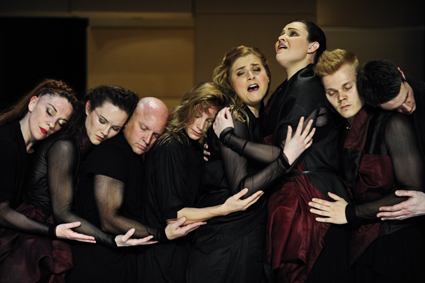
Abandon, Opera Queensland & Dancenorth
photo Bottlebrush Studios
Abandon, Opera Queensland & Dancenorth
All of the cast, including the two musicians (classical accordion, cello) wore black and wine-coloured goth-clerical garments by Alistair Trung. Like other elements of this production, the apparent austerity later gave way to some unexpectedly lush transformations. The integration of dancers and singers in the first wall to wall dance movements, disturbing the paper floor and adding a layer of rushing sound, was testament to Hill’s choreographic range, in that the four (previously non-dancing) singers were initially indistinguishable from the five dancers.
The musicians also moved around the set, becoming involved in the action at various points, most notably when accordionist James Crabb faced off, stamping counter rhythms while continuously playing, against Bradley Chatfield’s belligerent pugilist. Chatfield’s angry, feisty boxer, trying to corrall the rest of the cast, provided a comic contrast to Alice Hinde’s earlier heartrending solo; France Herve’s remarkable partnering with her own cascade of hair, as if it were another dancer; Erynne Mulholland’s fearful and imperious ten foot tall harpy; and Andrew Searle forcing the female cast into gaps which appeared in the box walls, as though playing a human Tetrus game.
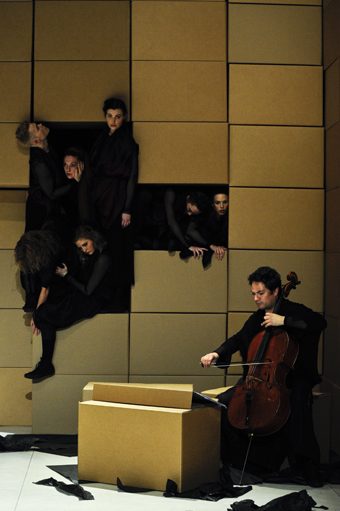
Abandon, Opera Queensland & Dancenorth
photo Bottlebrush Studios
Abandon, Opera Queensland & Dancenorth
The creators’ own description of Abandon notes that, “Unlike most baroque operas which travel from chaos to order, our trajectory seems to travel in the opposite direction.” Indeed, the emotional extremes were reflected in the gradual disintegration of the physical set, as high apertures and low drains opened up in the walls; the paper was flung, piled in corners, used for burial and dispersed again; and costumes were undone, let out, ballooned, removed and reassumed.
The lighting supported the changing sense of internal and external space perfectly, sometimes replicating the dramatic chiaroscuro of a Flemish painting in rare moments of relative physical and musical repose.
A journey sometimes defies explication, cannot always be recounted sequentially or logically, especially when much of it involves ephemeral sensations rapidly displacing one another, and intense connections made and lost. As if to emphasise this, in the final moments the walls are dismantled and rebuilt downstage to separate cast from audience, and we are abandoned to make of it what we will.
Abandon will be performed at the Brisbane Powerhouse, 21-23 February, 2014
Opera Queensland & Dancenorth, Abandon, co creators James Crabb, Raewyn Hill, Lindy Hume, music director James Crab, design Bruce McKinven, lighting Bosco Shaw, costumes Alistair Trung, School of Arts Theatre, Townsville, 24 July-1 Aug
RealTime issue #117 Oct-Nov 2013 pg. web
© Bernadette Ashley; for permission to reproduce apply to realtime@realtimearts.net
Prick up your ears for this in the loop which offers a burst of sonic happenings across the country, plus some dance and theatre to balance the mix.
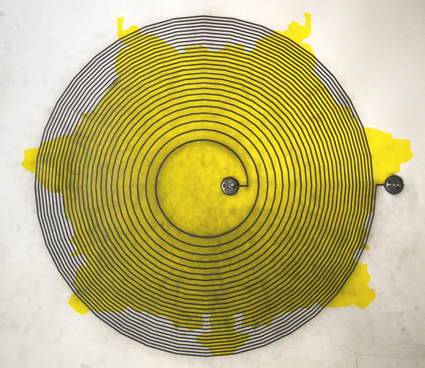
Joyce Hinterding, Fields and loops: series 4, 2010, ink and graphite on paper
courtesy the artist and BreenSpace
Joyce Hinterding, Fields and loops: series 4, 2010, ink and graphite on paper
Simple Forces, Joyce Hinterding, BreenSpace
Marrying “deep science” and elegant aesthetics, Joyce Hinterding’s upcoming solo exhibition at BreenSpace, Simple Forces, seeks to transform “matter into ideas, and ideas into matter” (website). Using forms and symbols drawn from algorithmic structures, the graphite shapes also create circuits which, when amplified, make invisible atmospheric forces audible.
Joyce Hinterding, Simple Forces, BreenSpace, 25 Oct-23 Nov; http://www.breenspace.com/
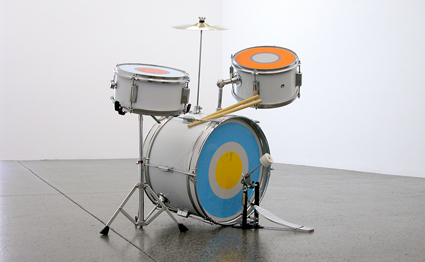
Reinventing the Wheel: The Readymade Century – Julian Dashper, ‘Untitled (The warriors)’ 1998
Reinventing the Wheel: the Readymade Century, MUMA
Now showing at MUMA, Reinventing the Wheel celebrates Marcel Duchamp’s liberating declaration that the any object, in the right context, can become art. It follows the momentum of this idea through the 20th century and into the 21st, featuring the work of over 50 artists ranging from international historic figures, including Carl Andre, Andy Warhol and Gilbert & George, to Australian contemporary artists John Nixon, Ricky Swallow, James Lynch, Agatha Gothe-Snape and others. Accompanying the exhibition, a series of music events, Found Sound, explores John Cage’s celebration of the aural readymade. The final installment (Oct 26) will feature Joyce Hinterding and Lawrence English.
Reinventing the Wheel: the Readymade Century, MUMA, 3 Oct-14 Dec; http://www.monash.edu.au/muma/exhibitions/upcoming/readymade.html
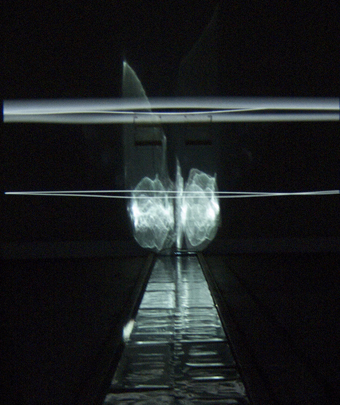
Chamber 1 (Order), Chris Bowman, Michael Day, Rachael Priddel, Colin Black, The Double World, transTURM collective
courtesy the artists
Chamber 1 (Order), Chris Bowman, Michael Day, Rachael Priddel, Colin Black, The Double World, transTURM collective
The Double World, tranSTURM, Newington Armory
Taking over one of the cavernous spaces of the Armory at Olympic Park, the UTS-supported tranSTURM collective has created a “double world” of light, sound and animation. Drawing inspiration from Rainer Maria Rilke’s poetic exploration of the Orpheus myth the installation has been created by a collective of Australian and international designers, architects and media artists under the creative directorship of Chris Bowman. The installation also features a soundtrack by Colin Black and choreography (displayed as mapped video) by Meryl Tankard.
The Double World, tranSTURM, Newington Armory, Sydney Olympic Park, 19 Oct-10 Nov; http://www.sydneyolympicpark.com.au/whats_on/arts_and_culture_events/exhibition_the_double_world_spr13; http://cargocollective.com/transturm/the-double-world
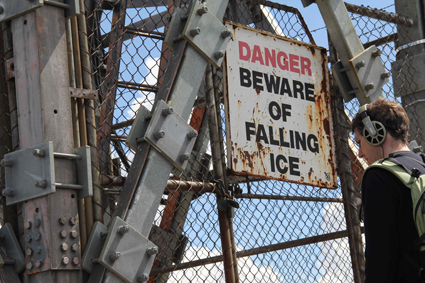
Christophe Charles, Bogong ELECTRIC
Bogong ELECTRIC
Following the success of the Bogong AIR festival in 2011 (see review), Philip Samartzis and Madelynne Cornish have been establishing a permanent home for sonic exploration in the village of Bogong in the north-eastern alps of Victoria. Now settled in the restored schoolhouse, the Bogong Centre for Sound Culture (BCSC) will soon present Bogong ELECTRIC, a month of performance and installations using the Kiewa Hydroelectric scheme as the starting point for investigations around natural and built environments. Guest artists include Michael Vorfeld (Germany) using the inherent noises of electric devices like light bulbs and switches to produce audio performances; Christophe Charles (Tokyo) creating an underwater soundscape to be listened to while on the lake; Geoff Robinson (Melbourne) transposing a sonic map from one area to another; and David Burrows (Melbourne) experimenting with stereographic imaging. The BCSC will also be offering a range of educational opportunities and registrations are now open for a masterclass with Samartzis in Feb 2014.
Bogong ELECTRIC, Bogong Village, North East Victoria; 1 Nov-1 Dec; http://bogongsound.com.au/
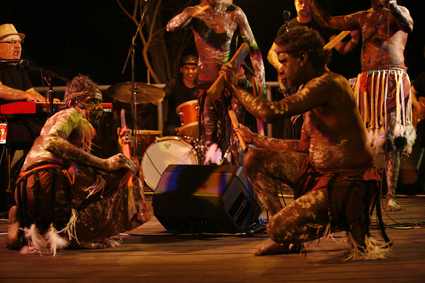
AAO & Wagilak songmen, Crossing Roper Bar
Crossing Roper Bar, AAO
RT Managing editors Keith Gallasch and Virginia Baxter were lucky enough to see an early manifestation of Crossing Roper Bar at the Darwin Festival in 2008 (see review). This unique collaboration between the Australian Art Orchestra and the Wagilak songmen from Ngukurr in East Arnhem Land has continued to evolve, now featuring Broome singer/songwriter Stephen Pigram (replacing the late Ruby Hunter). This very special concert has been touring West Australia and there are few shows left to catch in Karatha, Exmouth and Perth.
Tura New Music & Australian Art Orchestra: Crossing Roper Bar, AAOO with the Wagilak songmen and Stephen Pigram; Karratha, 25 Oct, Exmouth, 27 Oct, Perth, 29 Oct: http://crbtour13.tura.com.au
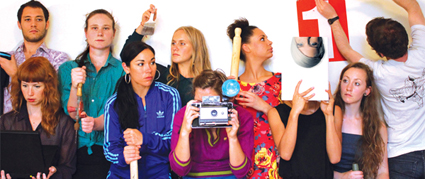
Dance Makers Collective, Carl Sciberras, Anya Mckee, Leeke Griffin, Marnie Palomares, Katina Olsen, Miranda Wheen, Sophia Ndaba, Jenni Large, Rosslyn Wythes, Matt Cornell
photo Anya Mckee & Dance Makers Collective
Dance Makers Collective, Carl Sciberras, Anya Mckee, Leeke Griffin, Marnie Palomares, Katina Olsen, Miranda Wheen, Sophia Ndaba, Jenni Large, Rosslyn Wythes, Matt Cornell
Big Dance in Small Chunks, Form Dance Projects
This premier performance for the Dance Makers Collective brings together 10 emerging dancers and choreographers to collaborate with each other as well as filmmakers, musicians, visual artists and designers (including Erth Visual and Physical Theatre) to present nine ambitious new pieces. We’re particularly curious about the performance described by Miranda Wheen (connecting Eddie Obeid with his pelvis) in her recent RT Profile.
Form Dance Projects: Big Dance in Small Chunks, Dance Makers Collective (Matt Cornell, Jenni Large, Anya Mckee, Sophia Ndaba, Melanie Palomares, Katina Olsen, Marnie Palomares, Carl Sciberras, Miranda Wheen and Rosslyn Wythes); Lennox Theatre, Riverside 23 – 26 Oct; http://form.org.au/2013/01/dance-makers-collective/
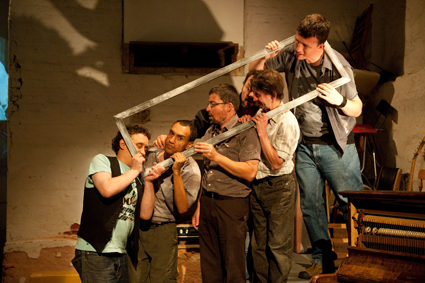
Sons & Mothers, No Strings Attached Theatre of Disability
courtesy the company
Sons & Mothers, No Strings Attached Theatre of Disability
Sons and Mothers, No Strings Attached Theatre of Disability
Following its highly successful premier season at the Adelaide Fringe in 2012 No Strings Attached’s production Sons & Mothers is currently enjoying a full season at the Space Theatre. The group-devised work presents the stories of six men with disabilities and their relationship with their mothers. A feature documentary on the process of developing the show has also just screened as part of the Adelaide Film Festival. See the review of both film and stage production in RT118.
Adelaide Festival Centre and Windmill Theatre: Sons and Mothers, No Strings Attached Theatre of Disability, writer, devisor and director Alirio Zavarce, with and for the Men’s Ensemble of No Strings Attached; Space Theatre, Adelaide Festival Centre; 17-26 Oct; http://www.nostringsattached.org.au/sons-and-mothers-2013.html
RealTime issue #117 Oct-Nov 2013 pg. web
© RealTime ; for permission to reproduce apply to realtime@realtimearts.net
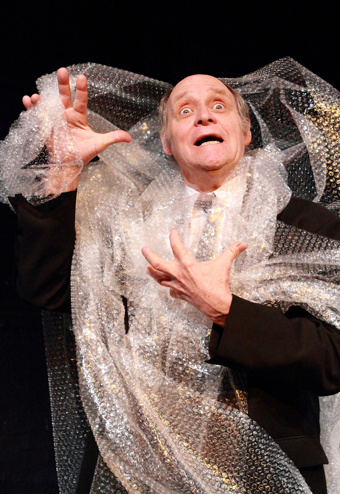
Jim Daly, John Gabriel Borkman
If the road to perdition is paved with treacherous ice then a pathway into director, Peter King's scathing interpretation of Henrik Ibsen's John Gabriel Borkman sometimes glitters with gold.
As if electrified, male performer Cory Corbett as Borkman’s maniacal wife Gunhild rips away a sheet from 'her' body and the play begins. Upstairs, pacing back and forth for the last decade or so, resides the disgraced title character of this play, John Gabriel Borkman: estranged husband of Gunhild, former lover of her twin sister Ella, hated father of his son Erhart and, above all, a man guilty of embezzlement who has not only destroyed his family's reputation but after spending time in jail, has quietly gone mad in response to a self-imposed exile from what he, Borkman, perceives as a cruel and heartless world. Ibsen's script immediately ensnares its audience in a penultimate endgame. It remains to be seen just who will survive this winter's night, one comprising loneliness and deception, alienation and hatred, insanity and mortifying despair.
King's direction utilises expressionist acting techniques rarely seen in Australian theatre. Jim Daly as Borkman and Russell Walsh as his emotionally deformed acolyte, Vilhelm Fodal, extract from King's direction much humour (some cartoon inspired) and a wistful evocation of the emotional wilderness that characterises most, if not all, the characters in this play. As Borkman is persuaded by his sister-in-law and former lover, Ella, to descend the stairwell of his self-imposed cell and challenge his psychotic wife Gunhild for custody of Erhart, the audience becomes witness to a remarkable display of physical endurance, technical concentration and ensemble acting.
During a four act performance without interval, extending across 100 minutes, the actors form themselves into grotesque physical images, spit out Ibsen's caustic familial vision with cobra-like accuracy and ultimately give expression to the playwright's view of a Christian theology that rages against the dying of its own light. Outside, the universe is cold and uninviting. Borkman's eventual death is not an ascent to heaven but instead, a descent into a symbolic mire. He will die in the snow with a “metal hand” wrenching life from his breast and, perhaps for the first time, God is pronounced dead in a theological wilderness suspended above a bottomless fjord, one carved from granite and ice rather than wrought from any supercilious religious force.
Mounting this production has been director Peter King's obsession, perhaps for some time. His directorial strategies are metaphorical and often abstract. But it remains clear that King himself is precise when considering how he interprets Ibsen's confrontation with the divine, and how he wishes to express this interpretation. That said, and within a bubble-wrapped set designed by Peter Corrigan and succinctly lit by Greg Carroll, the protective walls we erect in our delusional lives are no match for the seething hatreds that drive the thanatological personality. Unrestrained, it will drive each of us into that which Thanatos most desires—an abyss void of God and organised religion, one characterised by secular annihilation and the interminable passing of time.
John Gabriel Borkman, writer Henrik Ibsen, translation Peter Archer, director Peter King, performers Jim Daly, Cory Corbett, Ezuk Doruk, Will Freeman, Russell Walsh, designer Peter Corrigan, lighting Greg Carroll, La Mama, Melbourne, 18-29 Sept
See also Jana Perkovic's account of a 12hour version of John Gabriel Borkman at Theatretreffen, Berlin, 2012
RealTime issue #117 Oct-Nov 2013 pg. web
© Tony Reck; for permission to reproduce apply to realtime@realtimearts.net
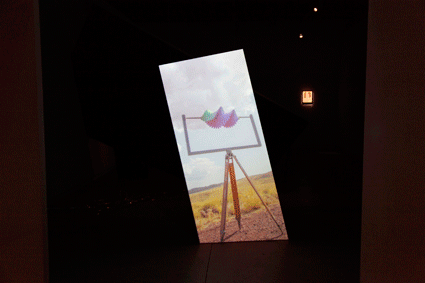
Benjamin Ducroz, cumulo, installation
photos Eugenia Lim
Benjamin Ducroz, cumulo, installation
For an ‘inaugural’ artist-led festival based around a relatively young art form, the Channels video art festival was weighty: a packed four-day program including close to 100 artists, curators and speakers; a level of curatorial and critical engagement that significantly amplified the impact of the work itself; and not least, a substantial printed catalogue that ably focused ideas, themes and relationships across the program.
Encompassing gallery-based installation, projections, online broadcast, a voluminous screening program and public talks, Channels’ central question was, say co-directors Rachel Feery, Eugenia Lim and Jessie Scott, “What is video art now?” Sounds simple, even simplistic—but one of the many impressive things about Channels was its genuine consideration of the question: its showcasing of contemporary video work with reference to the history of the form and a conscious engagement with the ubiquitous ‘now’ of mass-media video immersion.
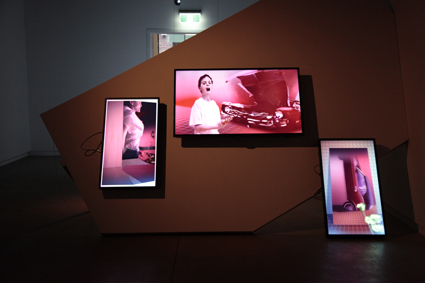
Ms&Mr, Amputee of the Neurotic Future 1988/2012, installation
photo Eugenia Lim
Ms&Mr, Amputee of the Neurotic Future 1988/2012, installation
Installed
Transformer, at Screen Space, was the exhibition for Channels, featuring works commissioned from Ms&Mr (aka Australian-Canadian duo Stephanie and Richard nova Milne) and Melbourne-based Benjamin Ducroz. In Ducroz’ cumulo, piles of roiling Pilbara storm clouds dissolve into the incremental movements of a hand-cranked, helical kinetic sculpture. Both phenomena are filmed in stop motion, in the landscape; but while the sped-up movement of the clouds is familiar thanks to its TV-doco ubiquity, the brightly coloured sculpture, stark in the middle of the desert, is surreal, seeming almost to be superimposed. Shifting between romanticism and deconstructivism, cumulo is projected onto a tall, trapezoidal screen at the gallery entrance accompanied by a soundtrack of ambient, insecty, subtle, sometimes ominous tones. The sublime vision of clouds—creamy, silver-lined or darkly grey—prefigured the misty pines and crumbling glaciers of some of the more meditative works in Channels’ Video Visions screening program. At the same time, the stepped structure and block colours of the moving model insist on time’s breakdown into increments, dancing with the origins of time-based photography. If it weren’t for Ducroz’ process work in the nearby foyer, where the sculpture is seen ‘on set’ in the desert, the quasi-scientific, twirling helix could easily be read as a 3D animation. In a sense, romantic ‘truth’ meets disbelief in cumulo.
A warping, monotonal drone is the backdrop for Ms&Mr’s three-channel work, Amputee of the Neurotic Future 1988/2012, part of their ongoing Videodromes for the Alone series. A distressed and silently howling prepubescent boy is protagonist in a fractured world of film and 3D animation, surrounded by symbolic props—a crashed and sinking car, a hospital gown apparently animated from within, a CAD-drawn checkered floor, an uncannily defocused bunch of flowers. With references to both J G Ballard and David Cronenberg, the mood is dystopian, painful and alienated, but washed out by blood-red monochrome into a kind of emotionless absence: an escape from horrifying realities that itself becomes horrifying.
Screened
The main screening program, Video Visions, provided an astonishingly broad survey of current video art from Australian and international artists over two intensive sessions on one night. Loosely themed into four sections—Sensory Drive, Media Mash-Ups, Constructed Worlds and Bodies Collide—Video Visions included dozens of short works; the choice to include an interval in each session created just the right breathing space.
There’s not enough room here to describe the breadth of works in the Video Visions program but some overall themes were evidenced, both in the overarching session titles and more subtly. The Media Mash-Ups and Bodies Collide sessions were the most tightly focused and, interestingly, the most reliant on humour, as though both the onslaught of mass culture and our visceral, physical reality can only be confronted with a grimace or an outright laugh. Sensory Drive crossed from virtuosic, psychedelic experiments with CGI ‘super-natures’ to formalistic explorations of colour, line or natural phenomena. Narrative seemed to emerge most strongly in Constructed Worlds, as though a ‘world’—even a fictitious or abstract one most requires a story. Noticeably weaving throughout the program were frequent evocations of mysticism and suggestions of what seemed like ‘earth-nostalgia:’ conflations of human/nature; eerie, hollow and ominous soundtracks; and the sense of worlds lost.
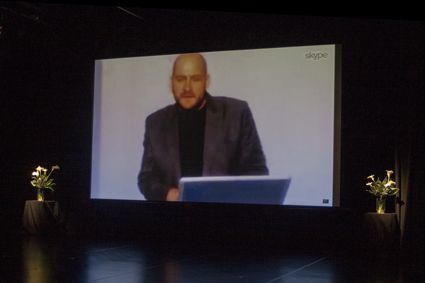
Emile Zile, Random Name Generator Memorial Roll Call, Memory Screens
photo Danielle Hakim
Emile Zile, Random Name Generator Memorial Roll Call, Memory Screens
Performed
The intersection between video and performance art, past and present, was the inspired starting point for the Memory Screens program in which artists Salote Tawale, Hannah Raisin and Emile Zile each presented newly commissioned works paying homage to selected iconic works by video and performance “elders.” As well as live performances of the three new works, excerpts were screened both from the artists’ previous output and from the chosen ‘source’ works.
Emile Zile, whose work to date humorously interrogates and replays conventions and tropes of cinema, television and the web, chose as inspiration Ant Farm’s 1975 Media Burn in which a Cadillac smashes through a pile of burning TV sets. In the most oblique response of the three artists, his new performance (via Skype), Random Name Generator Memorial Roll Call, comprised a tongue-in-cheek, funerary video roll call of randomly generated, unborn internet users, accompanied by vases of white lilies.
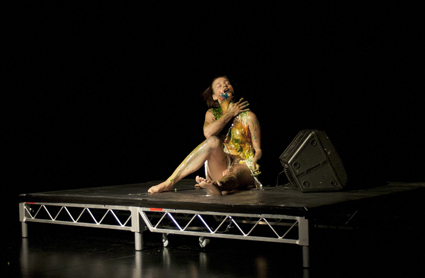
Hannah Raisin, Dear Carolee, Love Cindy, Love Hannah, Memory Screens
photo Danielle Hakim
Hannah Raisin, Dear Carolee, Love Cindy, Love Hannah, Memory Screens
Hannah Raisin, responding to Carolee Schneeman’s Interior Scroll, chose Cyndi Lauper’s “Girls Just Wanna Have Fun” as soundtrack to her absurd and confronting consumption of raw eggs injected with coloured dyes. Echoing Schneeman, whose 1975 performance consisted of extracting a long scroll from her vagina, in Dear Carolee, Love Cindy, Love Hannah, Raisin provided the music via an audio cable drawn from her vagina (presumably attached to an inserted MP3 player) and plugged into a stage monitor. The effect blurred feminist statement and monstrous-feminine, hinted at porn and vigorously challenged the gaze.
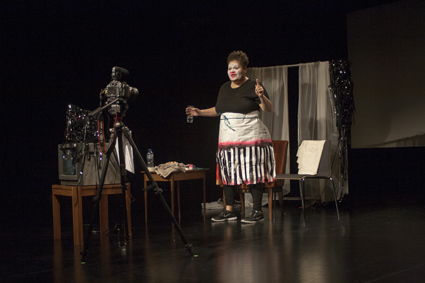
Salote Tawale, Dressing Up, Memory Screens
photo Danielle Hakim
Salote Tawale, Dressing Up, Memory Screens
Most directly referential was Salote Tawale’s response to Susan Mogul’s 1973 video, Dressing Up. As she slowly gets dressed, Mogul delivers a monologue on the clothes her mother made her wear as a child while periodically stuffing her mouth with snack food. Tawale recreated Dressing Up, delivering her own story of childhood female oppression, inextricably woven with the threads of her Pacific Islander heritage. It was a powerful end to a session that exemplified the strengths of Channels overall: its engagement across a broad thematic range, critical depth through discussion, and the commissioning of new work; and the imaginative contextualising of contemporary practice through the lens of history.
Channels: The Australian Video Art Festival, various venues, Melbourne, 18–21 Sept; http://www.channelsfestival.net.au/
This article first appeared in RT’s online e-dition 23 Oct, 2013
RealTime issue #118 Dec-Jan 2013 pg. web
© Urszula Dawkins; for permission to reproduce apply to realtime@realtimearts.net
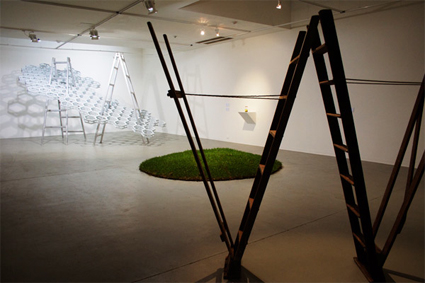
B l o o m—S p a c e, (Installation view) 2013.
Background Roy Ananda; middle ground Carla Liesch; foreground Will French; curated by Adelé Sliuzas
photo Alex Lofting
B l o o m—S p a c e, (Installation view) 2013.
Background Roy Ananda; middle ground Carla Liesch; foreground Will French; curated by Adelé Sliuzas
AEAF—emerging + experimental curators
The Adelaide-based Australian Experimental Art Foundation is calling for proposals from emerging curators to present exhibitions in the second half of 2014. (Read our review of emerging curator Adelé Sliuzas’ bloom, a highly successful exhibition as part of the 2013 series.)
Applications due 8 Nov; www.eaf.org
Renew Sydney: Leichhardt
Colluding with Leichhardt Council in Sydney’s inner west, The Renew Australia team are happy to announce the launch of the first Sydney Renew program. This will see a number of unoccupied retail properties become available for creative commercial and artistic enterprises. They are currently seeking people interested in setting up small creative retail spaces.
Proposals due 8 Nov; http://www.renewaustralia.org/2013/10/renew-australia-comes-to-sydney-with-renew-leichhardt/
107 Projects Applications for 2014
You’ve just enough time to put in an application for the 2014 gallery program at the pumping artist-run space 107 Projects in Redfern. Exhibitions can range from one week to three with just about all artforms welcome.
Applications due 25 Oct; http://www.107projects.org/
First Draft Directors 2014-2015
One of Australia’s oldest artist-run initiatives, First Draft in Sydney is looking for people passionate about the emerging arts and with skills in collaborative arts management to join the team of directors for the next two years.
Deadline 8 Nov; http://firstdraftgallery.com/get_involved/firstdraftwantsyou
Selected Australia Council Grant Deadlines
(for full list go to http://www.australiacouncil.gov.au/grants
Music: Presentation and Promotion – 18 November 2013
http://www.australiacouncil.gov.au/grants/2013/music-presentation-and-promotion-18-november
Music: New Work – Writing and Recording – 18 November 2013
http://www.australiacouncil.gov.au/grants/2013/music-new-work-writing-and-recording-18-november
Aboriginal and Torres Strait Islander: Skills and Arts Development –
19 November 2013
http://www.australiacouncil.gov.au/grants/2013/aboriginal-and-torres-strait-islander-arts-skills-and-arts-development-19-november
Aboriginal and Torres Strait Islander: Presentation and Promotion-
19 November 2013
http://www.australiacouncil.gov.au/grants/2013/aboriginal-and-torres-strait-islander-arts-presentation-and-promotion-1-april
Aboriginal and Torres Strait Islander: The Dreaming Award –
19 November 2013
http://www.australiacouncil.gov.au/grants/2013/dreaming-award
Aboriginal and Torres Strait Islander: Fellowships –
19 November 2013
http://www.australiacouncil.gov.au/grants/2013/aboriginal-and-torres-strait-islander-arts-fellowships
Aboriginal and Torres Strait Islander: The Red Ochre Award –
19 November 2013
http://www.australiacouncil.gov.au/grants/2013/red-ochre-award
Aboriginal and Torres Strait Islander: New Work –
19 November 2013
http://www.australiacouncil.gov.au/grants/2013/aboriginal-and-torres-strait-islander-arts-new-work-19-november
Visual Arts Travel Fund – 25 November 2013
http://www.australiacouncil.gov.au/grants/2013/Visual-Arts-Travel-Fund
Contemporary Music Touring Program – 25 November 2013
http://www.australiacouncil.gov.au/grants/2013/contemporary-music-touring-program-25-november
RealTime issue #117 Oct-Nov 2013 pg. web
© RealTime ; for permission to reproduce apply to realtime@realtimearts.net
Video footage: Sam James, Editing: Gail Priest
* * *
Coleambally is just over 600kms south west of Sydney in the Riverina region. It’s a very young town, founded in 1968 and currently has a population of just over 600 residents. One third of them attended A Night of Wonder, at the Coleambally SunRice Mill.
Vic McEwan from the Cad Factory in Narrandera brokered a unique partnership with the SunRice corporation to have access to their mill site in Coleambally and their workers (on company time) in order to develop an evening of site specific performance and installation. Only just re-opened after drought closure in 2007, the vast factory complex incorporates facilities managed by Australian Grain Storage. Following the path that rice processing takes, A Night of Wonder led its audience to 10 sites in the mill and storage facilities,
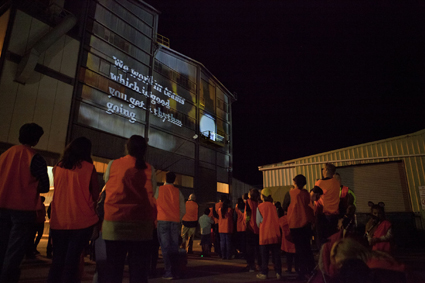
Site 9 – Opera, A Night of Wonder, Coleambally SunRice Mill, The Cad Factory
photo Mayu Kanamori
Site 9 – Opera, A Night of Wonder, Coleambally SunRice Mill, The Cad Factory
McEwan invited artists Mayu Kanamori (Sydney) and Shigeaki Iwai (Tokyo) to collaborate with each other and the Coleambally community. McEwan and Kanamori undertook a one-week residency early in the year, at the beginning of harvest time. Subsequently they were joined by Iwai for a three week residency in Spring: planting time. The Japanese artists brought with them a very different relationship to rice from our own. Theirs is an ancient connection associated with tradition and ritual, while, as McEwan suggest in the realtime tv documentary on A Night of Wonder, in Australia rice is just rice. Of course for the community of Coleambally rice has become much more than that.
The main performance in the cavernous storage barn saw several community members—a local Aboriginal elder, a farmer, a farmer’s wife, a miller, the factory manager—have a conversation with ‘rice,’ each speaking at a microphone to a circular projection of falling rice grains. For Stan Grant, the Wiradjuri elder, it’s a conflicted relationship: rice is not native to the area, but now it helps support his people. To the farmer it’s a co-dependent relationship; to a farmer’s wife it’s one of sharing her husband with the crop he loves. The final performer is Kanamori, speaking as a bird (complete with avian headdress) about how rice fits into birds lives. (Coleambally is an Aboriginal word describing a swift in flight.) As the projected image mutates into rice fields being burnt back for a new planting, a curtain of actual rice showers down, the metaphors of fire and water and earth co-mingling. McEwan, accompanying the performance with sound produced on laptop, also plays clarinet and miked-up fixtures of the building. Placed in the centre of the journey, the performance allowed the roving audience to settle and contemplate, though the ritualistic and reverent tone felt, at times, a little too ponderous.
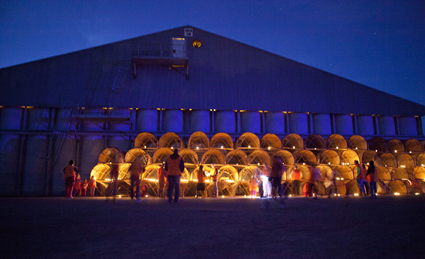
Site 3 – Ceremony for Planting, A Night of Wonder, Coleambally SunRice Mill, The Cad Factory
photo Mayu Kanamori
Site 3 – Ceremony for Planting, A Night of Wonder, Coleambally SunRice Mill, The Cad Factory
Ritual had been introduced with a lighter touch earlier on in the evening at the third site—a large stack of semi-circular airing baskets. Audience members were invited to ignite tea-light candles, place them in the baskets and make wishes for the new planting season. The resulting installation of hundreds of delicate flickering lights amid worn metal machinery was simply magical.
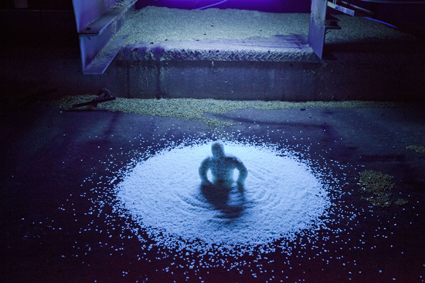
Site 5 – Of Rice & Men, A Night of Wonder, Coleambally SunRice Mill, The Cad Factory
photo Mayu Kanamori
Site 5 – Of Rice & Men, A Night of Wonder, Coleambally SunRice Mill, The Cad Factory
Shigeaki Iwai declared he was liberated by the absence of deep cultural significance in Australia around rice, his main artwork embracing instead a sense of play. In site five, an alleyway between two large warehouses, he installed a series of knee-high figures—people and animals made entirely of molded rice. These were placed in relation to old pieces of machinery illuminated with ultraviolet light. Not only did this provide a spectral glow to the figures, casting the audience’s hi-viz orange vests in terrifying contrast, but it also drew attention to the role of ultraviolet light in the rice growing process and, perhaps, the detrimental effect of too much of it given the potential for a greater hole in the ozone layer.
Mayu Kanamori got to the heart of the matter creating an installation about love. When they first arrived in Coleambally the artists held a dinner party, treating a number of community members to a 10-course rice banquet. After some sake tasting, Kanamori convinced the diners to write short poems about rice and love. These stories formed the basis of an installation featuring Kanamori’s photographs, audio recordings and small handwritten texts displayed amidst piles of golden rice husks, forming both a visual, sonic and tactile environment.
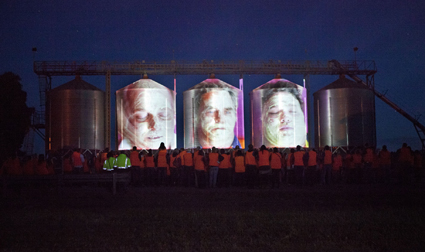
Site 4 – Rice Bran Facial, A Night of Wonder, Coleambally SunRice Mill, The Cad Factory
photo Mayu Kanamori
Site 4 – Rice Bran Facial, A Night of Wonder, Coleambally SunRice Mill, The Cad Factory
Industrial sites just beg for large-scale projections and A Night of Wonder did not disappoint. Onto three large grain storage silos a projected video showed several hardened millworkers in close-up being given facials made from rice bran, a traditional Japanese beauty therapy. Their faces loomed two storeys tall while we listened to recordings of their wives discussing how beautiful the refreshed skin felt, and how it had really made the men gentler and more relaxed. The workers themselves admitted that it was not too bad an activity, and as one wife says, she feels it has made her husband just that little bit more metrosexual.
The event culminated with a mini opera performed by a Narrandera local Fiona Caldarevic. Composed by McEwan, the lyrics were taken directly from interviews with workers in the mill about their daily routines. Caldarevic appeared as a diminutive figure on a landing protruding from the vast façade of the building onto which were projected scenes of pounding machinery (and wobbling jelly, the significance of which escaped me). Reminiscent of 70s British workers’ theatre it provided a suitably dramatic ending.
Interspersed among the art activities were several refreshment stations serving very tasty sushi rolls and hearty rice soup and everyone received a show bag of SunRice products. It was clear that the overall warm vibe at the conclusion of the evening came from much more than this generosity. A Night of Wonder managed to strike a perfect balance of engagement with its community. The ways in which the audience participated—being weighed in as if they were a rice crop, lighting candles, shuffling through rice husks—were subtle, non-confrontational, but meaningful. Perhaps more importantly, the ways in which community members were engaged were well pitched to be satisfying for them but also also fed into artistic outcomes. For a project juggling creative, community and, of course, business expectations, it really was wondrous.
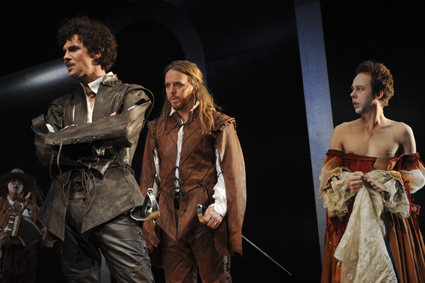
Rosencrantz and Guildenstern are Dead, STC
photo Heidrun Löhr
Rosencrantz and Guildenstern are Dead, STC
The slipperiness of identity, whether a matter of clinging to or searching for it is a commonplace in fiction and theatre, let alone in real life where it keeps many a being from a sense of wholeness. Three productions in Sydney have addressed this: the STC’s Rosencrantz and Guildenstern are Dead in which the duo’s quest for being in a world that refuses to properly identify them is dressed with a scarily surreal aura; Back to Back Theatre’s Super Discount which puts to the test a ‘disabled’ man’s identification with a super hero and its ramifications for his friends; and Moogahlin Performing Arts’ This Fella My Memory, in which three women struggle to re-achieve their sense of connection with family and country.
STC, Rosencrantz and Guildenstern are Dead
With Escher-like perceptual playfulness, Gabriela Tylesova’s design (with enabling lighting by Nick Schlieper) for the STC’s production of Tom Stoppard’s Rosencrantz and Guildenstern are Dead (1967) could have come straight out of a Polish theatre production of the 60s. Stark cloister arches on the sides of the stage angle in without meeting, yielding an ominous upstage void. The spaces immediately behind the arches at first appear to have depth but are later blackly forbidding, constituting a symbolic barrier for the play’s trapped protagonists, already confused and ineffectual victims of pure, or let’s say theatrical, contingency. If that weren’t enough, a large inverted, abstracted tree hangs above the pair, like a cipher from Beckett’s Waiting for Godot rendered by a Polish modernist.
Of course, the play is a riff on Waiting for Godot in which, instead of a landscape empty save for a tree, we have the world of Shakespeare’s Hamlet experienced as if from the sidelines by two of its doomed minor characters. The air of calculated Mittel European surrealism in the design is amplified by the pair’s naïve and increasingly desperate philosophising as well as in the costumes and grotesque demeanour of the hyperbolic figures they encounter—the actors on their cart like a circus crew from a Bergman film and Gertrude (an unrecognisable Heather Mitchell) an explosively exasperated wordless take on Elizabeth I.
Although perpetually panicked, Rosencrantz and Guildenstern themselves appear relatively normal: a couple of tolerably well-dressed gentlemen. Toby Schmitz’s intellectually posturing Guildenstern prances about, underlining thought bubbles with idiosyncratic gestures. Tim Minchin’s Rosencrantz, less alert than Guildenstern, but capable of his own flashes of illogical brilliance, hesitates and darts, stays close to the ground as the pair fill the waiting with ridiculous but sometimes alarmingly meaningful speculation. This tightly teamed, flawless duo is superb, as is Ewen Leslie’s ebullient leader of the actors.
An aura of pathos forms as the play ends, two likeable innocents, despite all their naïve attempts at understanding their condition, surrender to the ultimate blackness threatened throughout by the stage design of the provisional world they inhabit and the inadequacies of language—“words, they’re all we have to go on.”
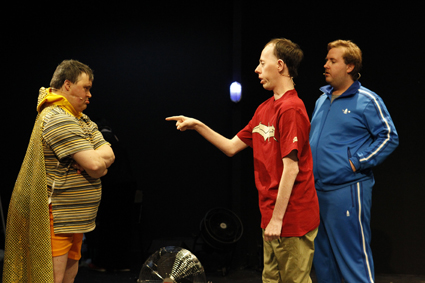
Mark Deans, Simon Laherty and Brian Tilley, Super Discount, Back to Back Theatre
photo Jeff Busby
Mark Deans, Simon Laherty and Brian Tilley, Super Discount, Back to Back Theatre
Back to Back Theatre, Super Discount
Like Stoppard’s Rosencrantz and Guildenstern are Dead, Back to Back Theatre’s Super Discount (for Sydney Theatre Company and Malthouse) is another gripping account of existential angst within a theatrical framework. This time a group of performers with intellectual disabilities in a rehearsal room decide to perform a work about the superheroes beloved by one of their number, Mark Deans. However, believing that he’s not capable of playing a super hero, they instead audition each other and a cocky ‘able’ actor (David Woods), squabble (some very funny, quick-witted exchanges between Brian Tilley and the others), tear into patronising audiences and slip into superhero costumes. But then they falter as the inauthenticity of the process dawns on the director, Simon Laherty. He suspects Mark should be playing the superhero. The outcome is funny, spectacular (lighting Andrew Livingston) and telling—that sometimes simple solutions are best.
The ambiguities constellating around persons with disabilities being represented as superheroes, save it seems for top-ranking sports people, are many. Back to Back avoids any easy affirmation of the underrated capacities of the ‘disabled.’ Instead they face the complexities—degrees of ability, prejudices among the ‘disabled’ themselves and the theatrical demands of casting—that have made the creation of a work, initially as a tribute to Mark, so troublesome.
Another complicating factor is the presence of the ‘able’ actor, disgruntled because disadvantaged in not having a disability—he’s never praised by audiences. Not surprisingly, he is cast by his fellows as the bad superhero. His angst is best displayed by Woods in dialogue, less well when it becomes a monologue leaving the other performers inert and the momentum of an otherwise brisk production stilled.
The audition routines, debates, role playing (Laherty in a wig as a super hero’s girlfriend), super hero dancing (Woods and Tilley choreographed by Antony Hamilton), Scott Price’s obstreperous interventions, nice touches like Sarah Mainwaring’s battle to mount a microphone on a stand, witty scripting and a strong focus on trust—will the group do the right thing by Mark?—all add up, delivering a satisfyingly complex and richly entertaining experience.
Moogahlin Performing Arts, This Fella My Memory
A large cloth screen, timber walkways and an open space to the front of the stage facilitate the presentation of various encounters and locations, urban and rural, and a very active spirit world in This Fella My Memory. The writing, the plot and characterisations are straightforward, but the actors deliver nuanced performances that suggest more complex personalities. Vast projections of night skies, rippling water and glittering traffic flows in a distant city amplify a sense of people in narrow circumstances looking for bigger lives.
Dolly (Lily Shearer)—a middle-aged Indigenous alcoholic who is hit by a car and loses her place in a hostel for homeless women—fears she is dying and yearns to visit her country. A grumpy cousin, Toots (Elaine Crombie), begrudgingly agrees to take her, but has to be coerced to also deal with Colleen (Linden Wilkinson), a white woman friend in the hostel who doubtless gave Dolly the grog that got her into trouble. While tension on the road between Colleen and an unforgiving Toots (who meanwhile indulges in a fantasy of returning to a singing career she ruined) doesn’t let up, Dolly begins to improve, if haunted by the ghosts of two girls from her country’s past.
From here on the plot grows more complicated as the unwelcome trio encounter Toots and Dolly’s relatives, enabling the play to take in issues of juvenile crime, rape and murder (hence the presence of the two ghost girls), return to ceremony and a young middle class woman’s discovery that she is Aboriginal. As well, Colleen reveals her past and its Indigenous connection and Toots finally acknowledges that she has no singing contract. It’s almost too much, veering into soap opera territory as crises mount and are too easily resolved, but director Frederick Copperwaite’s careful pacing and the intensity of the playing compensate somewhat for misgivings. Certainly the collectively composed writing, which oscillates between sharply observed and pedestrian, could be improved should the play have another life.
As “the first Aboriginal theatre production created, developed and produced by an Aboriginal company in Redfern in almost 40 years” (press release), This Fella My Memory is a welcome indication of the potential of Moogahlin Performing Arts to bring new perspectives on Australian life to the stage, in this case with a focus on the challenges for disadvantaged middle-aged women to recover their sense of agency and identity.
Sydney Theatre Company, Rosencrantz and Guildenstern are Dead, writer Tom Stoppard, director Simon Phillips, Sydney Theatre, 28 Aug-14 Sept; STC, Malthouse, Back to Back Theatre, Super Discount, director, devisor with the performers Bruce Gladwin, Wharf 1, 20 Sept-19 Oct; Moogahlin Performing Arts, This Fella My Memory, director Frederick Copperwaite, created & devised by Moogahlin Performing Arts & Linden Wilkinson, Carriageworks, Sydney, 4-7 Sept
RealTime issue #117 Oct-Nov 2013 pg. 34
© Keith Gallasch; for permission to reproduce apply to realtime@realtimearts.net
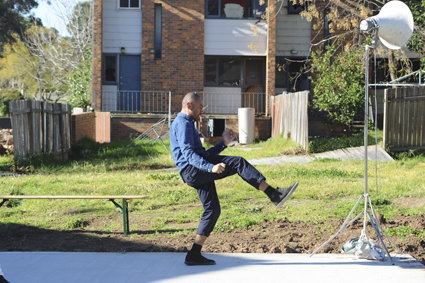
Brian Fuata, Privilege (House), Temporary Democracies
photo Heidrun Löhr
Brian Fuata, Privilege (House), Temporary Democracies
Can a neighbourhood sausage sizzle qualify as art? What about a table tennis competition in a local clubhouse? When it comes to socially engaged community art projects, it can often be near impossible to demarcate the boundary between ‘art’ and ‘life’. This is certainly true of the works that make up Temporary Democracies, a series of site-specific art and performance installations located in the South Western Sydney suburb of Airds.
Currently home to thousands of individuals and families who rely on public housing, 70% of Airds will be redeveloped over the next 15 to 20 years with a large proportion of its population to be relocated elsewhere. Demolition is already underway, leaving vacant a number of houses and empty blocks of land. For Temporary Democracies, an initiative of Campbelltown Arts Centre supported by the NSW Land and Housing Corporation, curator Paul Gazzola has invited 13 artists to develop projects over the next two years that engage with the urban conditions of the area and reflect on the changes affecting this community. The first instalment this year saw a handful of Australian artists consulting and interacting with local residents as they developed works onsite over five days in August, using vacant homes and empty land as inspiration for their installations.
The scene I encounter on a bright Saturday afternoon initially feels more like a friendly neighbourhood street party than a contemporary art project. A small crowd is milling around a food trailer, chatting casually, hotdogs in hand. This is artist Robert Guth’s Mobile Cooking Hearth, a van that has been constructed by Guth together with members of the Airds/Bradbury Men’s Shed group using the remains of kitchens from demolished houses.
Cooking as art has been done before—most famously by Rirkrit Tiravanija who offered gallery visitors homemade curry and pad thai meals at his New York shows during the 1990s. But Guth has taken the extra step of moving out of a gallery setting and placing his work directly onto the street by creating a mobile cooking facility that will remain a permanent part of the Airds community. If sharing food is the ultimate communal act, Guth’s project shifts the meaning of art from aesthetic to social. It may appear decidedly lo-tech and anti-aesthetic, but as the afternoon wears on and my new friends and I pass around the tray of freshly baked lemon cookies that the artist has produced from the trailer’s oven, I experience firsthand the potential of this project to foster human relationships.
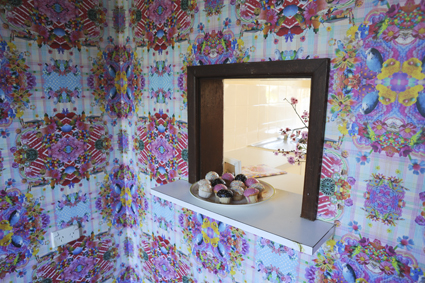
Tanya Schultz, Dreamers who seek treasure, Temporary Democracies
photo Heidrun Löhr
Tanya Schultz, Dreamers who seek treasure, Temporary Democracies
Across the street, Elizabeth Woods has transformed the interior of a newly vacated house into a table tennis drop-in centre which she has called The Academy—What’s Your Game? It’s decorated with trophies and memorabilia, including photographic portraits of smiling Airds residents, and Woods is on hand to keep score for children playing enthusiastically. Meanwhile, the property next door has had its walls covered floor to ceiling by Tanya Schultz’s Dreamers who seek treasure, a multicolour wallpaper collage created using photographs of items that have been donated, lent and constructed by residents. Schultz tells me she set up an art and craft table in the Airds village shopping centre and that her wallpaper features images of the objects made by children who stopped by, as well as photographs of neighbourhood pets including Phil’s budgie and Pumpkin the dog who lives next door. It is unashamedly kitsch and playful, and the burst of colour it brings is eerily juxtaposed with the stillness of the empty house that we know will soon be torn down.
Brian Fuata’s Privilege (House) is the most artistically ambitious project of the bunch. The artist sits outside on a rectangular concrete slab that has been laid on a vacant block of land. His program notes state that he aims to “sonically reconstruct a recently demolished house.” His voice is projected from four speakers that face out towards the benches on which we are invited to sit around him. At one point he recites strings of seemingly random letters, before reading definitions of words that appear to be related to themes of place and location. His lone presence and echoing voice create a compelling visual and sonic image that feels somewhat like a poetic rendering of a Rachel Whiteread work: whereas the UK artist’s concrete casts make physically present the interiors of negative spaces we do not usually see, Fuata evokes a now-absent physical structure through abstract and ephemeral sounds.
Complementing these installations is Rebecca Conroy’s artist blog which can be accessed at www.temporarydemocracies.com. As more material is added online in the months ahead, it looks to be a useful resource in framing the onsite events within a wider social, political and artistic context. By creating collaborative art with a community in transition, the legacy of Temporary Democracies may well persist far into the future.
–
Read “Live art from demolition,” an interview with Paul Gazzola and CAC director Michael Dagostino about Temporary Democracies in RT116.
Campbelltown Arts Centre, Temporary Democracies, curator Paul Gazzola, Heathfield Place, Airds, 13-17 Aug; www.temporarydemocracies.com
RealTime issue #117 Oct-Nov 2013 pg. 32
© Ilana Cohn; for permission to reproduce apply to realtime@realtimearts.net
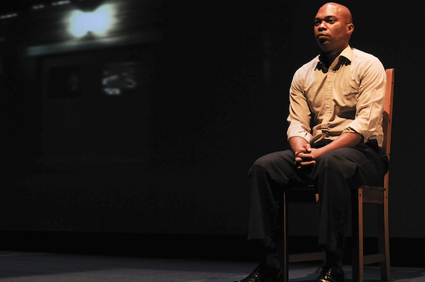
Irving Gregory, The Disappearances Project
photo Heidrun Löhr
Irving Gregory, The Disappearances Project
After several years of ‘emergence,’ version 1.0 erupted into prominence at Performance Space in 2001 with The second Last Supper featuring a mix of the not-so ‘old guard’ from the contemporary performance community and the new, along with nightly consumption throughout the season of an enormous volume of red wine in an outrageously surreal, promiscuously wide-ranging taboo-busting epic.
Moving resolutely on to tackle political issues still largely unaddressed by Australian theatre, version 1.0 has rarely lost that sense of fun, even when tackling the darkest of subjects. Material taken from public and parliamentary records about the Children Overboard saga (CMI, A Certain Maritime Incident, 2004), Government media manipulation about the Iraq War (The Wages of Spin, 2005), Australian Wheat Board corruption in Iraq (Deeply Offensive and Utterly Untrue, 2007) and local government corruption (The Table of Knowledge, 2011-12) has been ironically reframed, physically, vocally, spatially and technologically, without resorting to satire or mimicry.
These works are still enormously relevant. Version 1.0 has also tackled masculine violence, the suffering of people whose relatives have disappeared—in The Disappearances Project—and “place, tourism and atrocity” in Kym Vercoe’s seven kilometres north-east (which has become a film, Jasmila Zbanic’s For Those Who Can Tell No Tales, featured in the 2013 Toronto Film Festival), and a history of the maltreatment of the people of Palm Island, Beautiful One Day, produced as a collaboration with Ilbijerri Theatre. For Canberra 100 the company recently created the much praised The Major Minor Party, about the ACT-based Australian Sex Party and its impact on Australian political culture.
Hot on the heels of The Major Minor Party comes The Vehicle Failed to Stop. In 2007, a 49-year-old taxi-driver Marou Awanis and her friend Jeneva Jalal were shot by private security contractors working for the Australian-owned company Unity Resources Group, “an integrated risk mitigation solutions provider for clients in complex, challenging and fragile environments, globally headquartered in Dubai.” Apparently the car got too close to a security vehicle albeit in a safe part of Baghdad. Coming after similar deaths, the killings resulted in widespread protest. The Iraqi Government attempted to ban the American security firm Blackwater from the country. A legal team working on behalf of the women’s families filed a suit in Washington. However, the American Government claimed to bear no responsibility for overseeing outsourced security operations, therefore the families have had to sue URG. RT spoke with Irving Gregory, a current member of version 1.0, about himself as a performer and the issues focused on in The Vehicle Failed to Stop.
Tell us a little bit about your background as a performer.
Basically I came out of New York University’s Experimental Theatre Wing in the Tisch School of the Arts undergraduate drama program. Very lucky there to have worked with people like Anne Bogart among other people in the mid-80s before she came up with her Viewpoints concept. I worked the downtown dance and performance scene in New York in the 80s. Then I travelled to Germany, worked in the free scene in Munich and other cities. Travelled around there. Came back to the States in the 90s, tried to do movies for a while and got back into theatre in the late 90s when I joined the Collective Unconscious in New York.
While at the Collective Unconscious—which we ran as a collective and put shows on there to pay the rent basically—we developed a performance called Charlie Victor Romeo which won two Drama Desk Awards, travelled all over the US, was co-produced in Japan, came here to the Perth International Arts Festival, was filmed by the Air Force for training, picked up by the medical community…It had a long and storied history and was made into a film last year, which premiered at Sundance Film Festival this year.
The text is the transcripts of six actual airline emergencies—black box transcripts which we dramatised, live onstage with an award-winning sound design. In 2004 Time magazine named it as one of the best plays of the year. I’m in the film and also credited as one of the screenwriters as I’m one of the creators of the play.
What drew you to Australia?
Well, I got married. I met my wife in Perth when I was here in 2002. We stayed in touch and got married in 2008. I then talked to people at version 1.0. They got back to me in 2011 for The Disappearances Project. That’s when I joined the company.
What’s the attraction of working with version 1.0?
Well it’s always the people and the work. From Charlie Victor Romeo, I had an interest in this type of theatre—theatre documentary style and/or verbatim style. I’d done elements of that kind of work since the late 80s actually. I did a piece with [performer, dancer, painter] Fred Holland, basically as a sound operator. He had an interview in the piece, which was about the fight career of Jack Johnson, the great boxer, and the interview with him was about when he had to surrender the title—because the Feds were going to prosecute him under the Mann Act [a law against ‘white slavery’ but used to criminalise consensual sexual behaviour between blacks and whites. EDs]. I worked with this piece to re-integrate it a bit more and discovered the power of an interview—real words—and how that can work dramatically. I worked subsequently in Germany with an interview-based piece called Packing and Shipping. Learning version 1.0 did that kind of work I became interested in them. The Disappearances Project was the first work I did with the company and The Major Minor Party, which we premiered in June, is the second.
The Vehicle Failed to Stop, is predicated on a terrible incident in Iraq, when two women were killed by security contractors.
The initial development at the Sydney Theatre Company in 2012 was by David Williams, Kym Vercoe and Jane Phegan. I worked on the development of the idea in March of this year. In working with verbatim and/or interview and/or transcriptional sources there’s a lot of editing that has to be done, a lot of focus on what is important and what needs to be conveyed. What we brought out in this latest development was not only the fact that extra-judicial killing had occurred in an environment where a lot of this kind of thing had taken place through the use of contractors, but a focus on the whole nature of privatisation. And this extended to the entire administration of Iraq during and after the invasion. Paul Bremer [Administrator of the Coalition Provisional Authority of Iraq after the 2003 invasion], through one of his notorious orders, basically opened up the country to exploitation by any and all private industry because that was a part of the strategy.
Based on the neo-liberal assumption that this would solve everything.
Exactly, but then you have it taken to the extreme, being imposed upon an entire country at one time. It’s about the broadest sort of utilisation of that economic theory possible. You invade a country, you knock out the government, you fire everyone and you just say, ‘well, it’s open season for any and all entrepreneurial ideas to come in here internationally with no accountability to anyone.’ What are the consequences of this? One we found directly related to the incident with the two women is that you have a lot of security people on the roads operating beyond anyone’s law with the only consequence of their actions that they may be fired and sent out of the country. There’s no jurisdiction.
What kind of verbatim material are you using?
Documents derived from books and articles about Erik Prince, the head of Blackwater Security Consulting, and about the case itself as it was attempted to be adjudicated in the US and abroad. Then there are the pronouncements of and articles about the Bremer administration and also transcribed documentary footage about other elements of the privatisation and the experience of private contractors in Iraq. Another thing is that these companies—Halliburton, Kellogg Brown & Root, Blackwater, which reaped billions of dollars in profits, out of this wide-open, almost Wild West, boomtown environment—were not necessarily protective of their employees. They just send them to a country that has been supposedly ‘secured’ and what happens is people who aren’t security contractors, but truck drivers, are killed. Because the companies want to maximise profits, because they have a bottom line to meet, these men find themselves being shot at in gasoline trucks. What is that?
One of the companies involved is the ex-military Australian-owned URG.
Yes, they were the contractors involved in the incident with the two women being killed. In Afghanistan right now there are more contractors than troops. People may not know that. Of course, when the troops leave next year there’ll be opportunities for private contractors to continue security and other sorts of missions there. So this is a new element of international relations—how governments deal with international crisis points. Because when you don’t have to use your national army, when you can use private companies, then you’re not really accountable to anyone.
It goes nicely in tandem with the roboticisation of war in the form of drones and so on.
Well, it’s the 21st century we’re looking at. This is the way things are going, the way that war is now being prosecuted, or small wars—that’s all we have any more, isn’t it?—a changing environment in modern conflict, an environment without accountability or responsibility.
Carriageworks, version 1.0, The Vehicle Failed to Stop, Carriageworks, Sydney, 15-26 Oct
RealTime issue #117 Oct-Nov 2013 pg. 35
© Keith Gallasch; for permission to reproduce apply to realtime@realtimearts.net
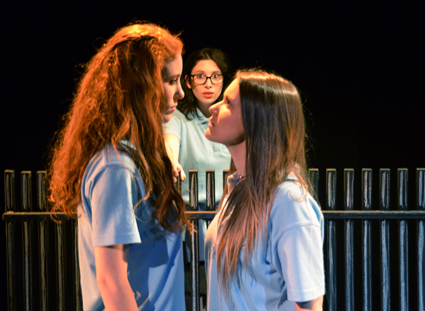
(lr) Danielle Baynes, Nicole Dimitriadis, Kate Englefield, Tough Beauty
photo Claudia Chidiac
(lr) Danielle Baynes, Nicole Dimitriadis, Kate Englefield, Tough Beauty
Projected onto a versatile, mobile stage flat, Karina Gonzalez greets us with with a sophomoric sneer. She is the alluring husky voiced TK, lyrically and graphically inviting us to relive or even abet a violent event in which she leads her gang into baiting and subsequently knifing an unsuspecting, unnamed victim.
Aided by a supporting cast of witnesses who provide verbal testimony in fragmented drip-feed, the work strives to highlight the authoritative claim to authenticity of video documentation, begging the question: if there was no one to film it, did it really happen?
Written by Finegan Kruckmeyer and directed by Claudia Chidiac, the development of Tough Beauty is the first in-house work facilitated by Casula Powerhouse Arts Centre, itself a concrete paean to arrested brutalist vision in the heart of the Moorebank Parklands. It aptly points to the inspiration for the work’s concoction: a rash of YouTube videos actually depicting suburban teenage girls beating each other up, the art of hazing and contemporary schoolyard politics refracted through the self-promotional lingua of social media.
The first onstage characters we meet, Rana (Danielle Baynes) and Nat (Nicole Dimitriadis), dive straight into reviewing their place in the schoolyard pecking order in dialogue that is deft and light-hearted. The stability of this alliance seems to be threatened by the hovering Mika (Rebecca Hitch), the resident bully whose ties to TK are suggested. Rana’s meditation on the dormant bloodlust that rules the schoolyard forces us to share Kruckmeyer’s self-confessed awe at what he has heard over months of research.
However, it is when New Girl emerges that the pot is stirred for real. By far the most intriguing character onstage, Kate Englefield capably embodies her with a pronounced skulk, alluding to a troubled past cited as the reason for the transfer. When we see her cornered at the toilet block backdrop, the New Girl’s mask of survival endures a verbal assault, confidently delivered by Mika in slam-meter and supported by Shauntelle Benjamin’s silent and agile sidekick. The stage combat that accompanies this is swift and fluid but nothing prepares us for the New Girl’s Hulk-like explosion heard from behind the toilet door.
Drawing on conversations with students, educators, researchers and artists, Chidiac and Kruckmeyer, assisted by a tense and haunting soundtrack (Gail Priest), stitch together a portrait of narcissism that also defers to a technological hall of mirrors populated by psychopathic impulses.
Tough Beauty sits well as a conjectural response to last year’s The Tender Age (version 1.0, ATYP) and Lachlan Philpott’s Truck Stop (Q Theatre), the creative team drawing from a rich thematic and solid research methodology. While the work is effectively founded on the theatrical adage that the hidden can be more powerful than the seen, it nonetheless leaves room for development, namely greater clarity about the New Girl whose story drives the work.
Casula Powerhouse, whose home is threatened by development of a transport hub, deserves to live on as is, continuing to seed stories that need to be told.
Casula Powerhouse Arts Centre Productions, Tough Beauty, writer Finegan Kruckemeyer, director Claudia Chidiac, video design Elias Nohra, design Arthur Koutoulas, costumes Ruby Langton-Batty, Powerhouse Arts Centre, Casula, NSW, 15-17 Aug
RealTime issue #117 Oct-Nov 2013 pg. 38
© Teik-Kim Pok; for permission to reproduce apply to realtime@realtimearts.net
This year’s Junction Festival was an invitation to listen: carefully, intimately, deeply and playfully. Whether via the beats and breath of the city’s artists in the walking experience of Enroute or the iPod-directed audio-virtual reality in the physical theatre performance Blindscape, deep listening in this festival was rewarded with unexpected shared intimacies of place, body and mind.
Even the listening (and grooving) at the raucous Junc Room, a big top tent at the heart of this much anticipated winter’s-end event, invited a shambolic kind of intimacy among the multi generations and tribes who call Northern Tasmania home. Now in its fourth year, Junction wears its contemporary arts/community ‘glocal’ cred very well indeed.
And so it was a little disheartening that one of the headline international acts in ‘the art of sonic culture’ for this festival wasn’t all it might have been. Dogs and Boats and Airplanes Children’s Choir was a world premiere collaborative artwork performed by a children’s choir of 100 voices. Conceived by Toronto conceptual artist, Bill Burns (see interview RT116) with artistic partner and cultural researcher Krys Verrall (under the name Big Pond Small Fish), the central intent—to capture a “radical banality” where ordinary things tell extraordinary stories through sound—had much going for it, especially given the delicious potential for rupture and irony in the cultural and literal frame of Launceston’s majestic proscenium arch Princess Theatre. Dogs and Boats was billed as provocative, edgy, ‘is this art?’ kind of stuff. And what better collaborators to imagine playing at such edges than 8 to 12 year olds who know all about dogs, boats and airplanes—if not in reality then in rich fantasy lives.
To devise such a large-scale multi-participant, multi-layered work with over one hundred children in just six weeks was logistically a feat in itself. And for that, Burns and Verrall with the students of four Launceston schools, choral director Amanda Hodder and choreographer Emma Porteous are to be applauded. The participants engaged in drawing and writing their own stories as a precursor to creating the libretto in that time. Themes of absence and loss co-mingled with adventuresome snapshot narratives of dogs and clotheslines and happy fishing trips. In performance, small clusters of students conveyed these snapshots in spoken word with the rest of the choir—traditionally positioned in a bank on stage—dedicating their choral voices to reverberating these stories in sonic play.
But in a country renowned for producing internationally leading works for and by young people, Dogs and Boats served to remind us of the crucial value of time in generating genuine artistic collaboration with young people. For while we were presented with insights into children’s lives in Dogs and Boats there was little sense of a collective energy having developed among the performers on stage. While the sounds of dogs barking and mechanical engine whining communicated well enough as a quirky and abstracted focus for a choir, the novelty soon wore off when we realized there was very little way in for us as audience to share in the listening. Except near the end, when we were invited to throw paper airplanes toward the stage.
The choir and audience erupted and for a split second the frames of performance were distorted in interesting ways. Was this the edgy bit promised? This production is the result of a curious and brave artistic turn for Burns whose internationally renowned gallery work has focused on animals and civil life. Burns’ recent studio-recorded sound art on the same theme of dogs/boats/planes in Toronto was a sharp pairing of kid voices and their curated soundscapes that conveyed some exquisite conceptual play between profound and not-so-profound domesticity. So perhaps the performative meeting of sonic and visual cultures in this piece—Burns’ next step with his artistic work—was not quite as brave or committed enough? Like the “scream when you see the villain” style of children’s theatre of old, my young companions and I couldn’t help but feel the paper airplanes thing was a little too token in a project that held such promise. Then again, isn’t that exactly what festivals are about? The space in which to take risks? We’re glad Burns chose to do so here.
Junction Arts Festival 2013, Bill Burns and Big Pond Small Fish, Dogs and Boats and Airplanes Children’s Choir, The Princess Theatre, Launceston, 6 Sept
RealTime issue #117 Oct-Nov 2013 pg. 38
© Mary Ann Hunter; for permission to reproduce apply to realtime@realtimearts.net
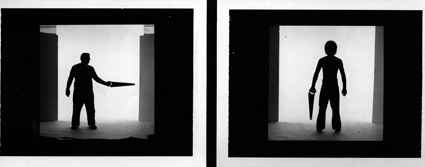
Andrew Livingston, Ben Cobham, courtesy Bluebottle
Melbourne’s Bluebottle is a company that has wrought lighting wonders for artists and civic and commercial enterprises for whom it has transformed theatre and other spaces (museums, galleries, parks, a zoo, 2013 New Year’s Eve celebrations in Melbourne) as well as creating portable buildings for artistic purposes.
The latter include ANAM Quartetthaus, for string quartets in the 2011 Melbourne Festival, and the Hub for the 2013 festival (part of a three-year contract), a pop-up venue housing much of the live music program, DJs and bars, with room for 300-500 people. In Sydney recently, their work was seen in Byron Perry’s Double Think and Back to Back’s Super Discount.
There’s a characteristic luminescence to Bluebottle’s lighting—colours rendered curiously intense or oddly foreign, colour planes that float, boundaries that become indiscernable and darkness that evokes the abyss. Above all, Bluebottle’s lighting often creates much of the overall design for a work, generating spaces. In Helen Herbertson and Ben Cobham’s Sunstruck (2008) the audience is seated in a circle around which tracks a huge light enveloping the performance area.
I’ve seen a lot of Bluebottle’s work over the years, but first came Ben Cobham at Antistatic Dance Festival in 1999, squatting on the floor with a slide projector between the audience and dancer Helen Herbertson on the old Performance Space stage. As Cobham ‘simply’ manipulated objects in front of the projector the three-dimensionality of Herbertson’s world was flattened, her presence made ghostly and intermittently glimpsed. Out of this work, Strike 1, came Delirium, the beginning of a long collaboration with Herbertson, (see the realtimedance entry on the choreographer at realtimearts.net), with their works acknowledged as co-creations.
Just over a decade later I saw Jenny Kemp’s wonderful Madeleine (RT99); this time much of the power of Bluebottle’s design was felt on the horizontal plane, as if the characters were suspended in the mythical space of its mentally distressed heroine’s making. In talking about that design, Cobham reminds me that Herbertson has been a collaborator and performer in Kemp’s work prior to Madeleine: “from a design sense Jenny’s work has often been quite complex, with trains and gardens and a sort of surreal realism. To a degree with Madeleine, Herbertson and I worked with Jenny to simplify the form, to let the writing come out more.”
Bluebottle’s recent work has included Tim Darbyshire’s perceptually challenging More or Less Concrete at Dance Massive earlier this year (RT114), with hauntingly low lighting by Ben Shaw who, although having left the company to pursue his own career, is working on Paul Kelly’s Conversations with Ghosts for Bluebottle. Blackout magic was central to Tamara Saulwick’s Pin Drop (RT111; 2010) and extreme diffusion of light helped make Back to Back’s Food Court (RT92) one of the most disturbing shows I’ve seen in recent years. Livingston says, “You forget when you’ve seen it a few times but I was pretty unnerved by it at the first script read.”
Sharing the light
Bluebottle has also had a long association with dance, including one of my favourites, Lucy Guerin’s Structure and Sadness (2006; RT76). I wonder how important a sense of collaboration is for the pair as opposed to simply providing a service. Livingston recalls how much they liked working on Structure and Sadness: “We were discussing it the other day. We haven’t got to do as many of those long-form collaborations lately. Ultimately, collaboration is everything really.” Cobham adds, “It’s probably our best asset and our biggest problem. Over time our practice has become very specific, like all things this works for some and not others.” Livingston adds, “But it’s reflective of how we work here as well. Bluebottle is actually a big, collaborative group—not a collective as such but it is certainly a very collaboratively based process.”
I ask how Livingston and Cobham came to work together and why their work moved beyond theatre. Cobham recalls, “Andy and I met at St Martin’s Youth Arts Centre. I’d finished university; Andy had finished high school. The day I started he was the first person to walk in the door. We did Jack and the Beanstalk together. That was our first gig. Andy was the beanstalk operator and I did follow-spot. So over time we started doing lighting designs together, which people thought was a bit weird but we felt we were getting better results as a pair so we just carried on, doing shows at Anthill, Danceworks and St Martins Youth Arts Centre.”
The pair’s entry into commercial work came when Cobham’s brother Geoff (the renowned Adelaide-based lighting designer) “started getting some museum work and we supported him with the installation. Architectural firms would come to see our shows and they’d say, we’d love you to come and work on a project with us. So five or six years after we met, we started to get offers: Melbourne Museum was one in 1999 followed by the South Australian Museum. It was all very organic.”
I note that Bluebottle lays claim to “innovation in light and form” on its website. I wonder how much research and risk is involved in their work. Cobham responds, “I think we’ve sort of weirdly learned organically. When we were younger we were around a lot of people who were big risk takers—people like Helen Herbertson and Simon Barley, people who really worked very much outside the box and we really loved that. We were always there for them going: ‘Yeah, come on, let’s do that!’ I think that probably helped set the tone for us.” Livingston agrees, “It didn’t seem unusual to take a risk. Where we were working, it was expected that some things would work and others wouldn’t. You’d have a go.”
The distinctiveness of Bluebottle’s lighting suggests great technical proficiency, leaving me wondering how they achieve their peculiar brand of magic. Surprisingly, Livingston declares, “neither of us is very super-technical. There are certainly a lot of people around who are much more au fait with high-end computer technologies. The idea is always the place to start and then work backwards on how to realise that rather than finding the technology and then forcing it into an idea. The research is driven by wanting to get the idea out into the world or onto the stage. We keep asking questions until we work out how to make an idea real.”
Cobham makes a significant point about communication in their work: “One of the big things we’ve discovered is you think you’re doing lighting, set design or working in theatre, but at the end of the day, a lot of it is actually about communication. To some degree just trying to make a lot of different people understand a common thing. It’s funny—we all think we know what the colour red is but we don’t really know that we see it the same way. A lot of what we do is about testing and demonstrating, which invites everybody to look and understand as they see it.”
Lab Bluebottle
I’ve always assumed that Bluebottle must have had a laboratory space in which to trial their innovative lighting ideas before moving into the theatre. “We do now,” says Andy, “Just in the past 12 months. Our building here in North Melbourne is a kind of warehouse/office. We just realised we didn’t really have a space, so we made one. For the first time we have a proper dark space we can black out, where we can do technical development. This was made possible with assistance from a Sidney Myer Creative Fellowship that Ben was awarded.”
Significantly, Bluebottle is making this space available to artists when it’s not in use. Ben explains, “We want to encourage other people to experiment technically. We lease it for not very much if they’ve got a good, honest cause. We don’t let people use it for rehearsals unless they’ve got something technical they’re trying to sort out. We allow them to use any equipment we have here—they’re odds and sods but they’re unusual odds and sods. The idea is that hopefully they inspire us and we give them a little bit of our time if they want it and, if they don’t, we just stay out of their way. Secretly we hope that the concept of the lab is something that perhaps some of the bigger companies will take on and set up their own labs in their own buildings.”
I’m curious that given their art is realised by and large in collaboration, whether Livingston and Cobham have ambitions to create their own stand-alone works? Cobham says, “There are a few little things that Andrew and I are cooking up. When we do get to talk it’s usually in the driveway late at night. We are talking about it which means it is going to happen eventually.” Whatever the venture, Cobham and Livingston will doubtless continue to exercise their wizardry collaboratively with adventurous artists and amaze us all.
See www.bb3.net.au for numerous images of Bluebottle’s work.
RealTime issue #117 Oct-Nov 2013 pg. 39
© Keith Gallasch; for permission to reproduce apply to realtime@realtimearts.net
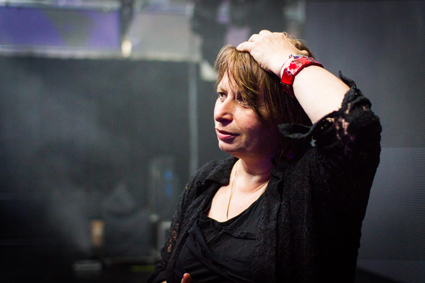
Jo Truman
photo Alia Grinvalds
Jo Truman
Jo Truman’s remarkable voice exceeds three octaves, from dark mezzo to high soprano, improvising flights of song, birdcalls and didjeridu cries, resonant with microtonal complexities and haunting overtones. The artist’s express focus is on “the voice and its ultimate potentials,” realised over some 30 years in live performance and an extensive catalogue of radio appearances and radiophonic works.
Most recently Truman (voice, piano, looping) appeared at the 2013 Mona Foma music festival in Hobart in two dramatically mercurial improvisations with Len Marks on guitar, Daniel Grinvalds on electronics and sampling, and joined by 12-year-old Alia Grinvalds on violin in the second performance. In 2012, Truman produced and performed a radio work, Bridge to Otherness, about Sydney’s Blue Mountains, where she lives, for WDR3 Koln, Germany and has been commissioned to provide libretto and electronics for a 30-minute chamber opera to be created in collaboration with Icelandic composer Hildigunnur Rúnarsdóttir for performance in 2014. The opera, for one voice, oboe, string quartet, clarinet and electronic media, is supported by a grant from the Icelandic State Broadcasting Corporation, Rikisutvarpid.
Despite a recent illness the artist is currently undertaking a Master of Fine Arts degree at CoFA (she completed a Master of Music in Composition at the Sydney Conservatorium of Music in 2008), exhibits her drawings from time to time and sings jazz at a Blue Mountains pub as well as writing and composing. I met Truman at the RealTime office to discuss the motivations for and connections between her practices.
Where motivates you to sing?
I was always prone to mimicry when I was young. I thought the crows were boys in the district yelling out to us, so I’d yell back in ‘crow language’ [LAUGHS], and would mimic my squeaky rubber toys. I think I was encouraged by my family’s amusement: it was a tense family and my mimicry broke the ice so I learned my mimetic talent had a certain power. I used to imitate opera singers too. My father was a pretty good musician who although he was a businessman had songs published in the 40s. He had an amazing ear for picking up anything on the piano and he had unusual tastes for the time—I heard Schoenberg’s Pierrot Lunaire when I was nine, and Poulenc.
It was all play for me, although I had classical piano training to a fairly high level from the age of three. In my teens I heard Meredith Monk and that was very liberating, but I was more an appreciator rather than a practitioner. Then things went wrong in my family in my teens; there was the tragedy of my closest sister dying—she committed suicide. I left school, catapulted out into the world at the age of 16. I was driven to be a visual artist—I did an arts certificate and then started on a diploma of fine arts. At the Alexander Mackie College of Fine Arts [now the National Art School] I would go from drawing into the Cell Block Theatre to sing. I was still traumatised by my sister’s death.
What kind of singing and to what end?
I think what was happening was that I was something of a disembodied young person and I felt empowered and embodied by singing. I could hear the voice coming back and defining me in space. I met Jon Rose and got involved with the Relative Band and Jim Denley. In the Cell Block Theatre by myself I had started connecting improvising with singing with fantasy and flying and to see how far I could stretch the voice. I wasn’t singing songs; my body was a physical score and I could draw feelings and landscape out of it, unimpeded by words and it was transformative. It was like making a line, with a pencil, a gesture, a choreographic sound.
How did the singing grow in complexity and technique?
I fell in love with Cathy Berberian’s singing. She had a classical background that I could relate to, but what she was doing was removed from the classical institution—it was very experimental for the time. That freed me. And from an early age I got fixated on breath moving through different nasal cavities, exploring a kind of atonality. Then there was birdsong. [Truman unselfconsciously breaks into a beautiful high-pitched, fluttering bird cry.] The notes are not semi-tonal, they’re more quarter tonal. While in the Cell Block I started exploring bird sounds and integrating them with bel canto and some jazz styles.
I know now it’s a bit taboo for a woman but I also studied the didjeridu, traditionally the yedaki, in my early 20s. I spent an amazing year, 1983, in the Northern Territory and was taught by master players and makers George Djungawanga and David Blanasi. George taught me how to make my own didjeridu. There’s microtonality in didjeridu playing, so I also started mimicking as well as playing it, producing the overtones vocally because it’s a similar principle, using the tongue.
How did your performing career commence?
I did some concerts with Jim Denley, a very positive musician with strong convictions. I performed with Jon Rose and Henry Kaiser at The Basement and in the Cell Block Series with the Relative Band. Then in 1985, with a grant from the Australia Council’s Music Board I continued my study in England with improvisers such as Phil Minton, studied jazz and counterpoint in Holland, and worked with an amazing French-Vietnamese ethnomusicologist and performer Tran Quang Hai who taught harmonics in overtone singing. Mongolian performers generally refer to it as “throat singing.” I was in Europe for eight years, returned to Australia in 1992, received a live-in stipend from the Akademis Schloss Solitude in Stuttgart for 15 months and then came back here in 1994 to complete my arts degree.
You performed extensively in Europe with a like-minded community of artists.
I thought they’d be a family. [LAUGHS] They weren’t really, but there were great experiences. I threw myself in the deep end and performed in Lithuania with Tony Buck and a lot of improvisers. There was a sense of family. One of the highlights was Songs from a Prison Diary by Phil Minton and Veryan Weston commissioned for the Le Mans Jazz Festival and Strasbourg’s Musica Festival composed around the beautiful poems of Ho Chi Minh. I was the opening improviser on that. I was thinking back to the Cell Block and the dream of flying and escaping—a lot of his poetry works with those images.
In 1991 I composed and recorded Sdreamings, a 30-minute radio play inspired by my time in the Northern Territory. It was produced by Klaus Schoning in the WDR3 studios, then appeared on a Staalplaat CD and in 1999 as a privately produced CD. It was about coming to grips with my own sense of loss and that associated with the apartheid between Australian cities and the land—not denying it, but embracing and transforming it vocally and with birdsong, improvising over recordings.
What drew you to composing for radio and to radiophonic works with a documentary dimension?
There’s less work in that area now, but extended listening is important. I thought radio could open more sonic dimensions for the voice and instruments, and narrative. I was interested in the changing nature of the perception of time as things have sped up. I wanted to create three imaginary Australian soundscapes: pre-colonial, colonial and contemporary. How are we impacted by changing sonic environments? I got a commission to produce Cell Songs with The Listening Room’s Andrew McClennan as executive producer. For part of it I went to the Northern Territory to talk with [the late Kakadu man and writer] Bill Neidjie, whom I met with twice and was honoured to interview. We could do well to heed Bill’s message about what we stand to lose in Australia. WDR3 translated it for broadcast in Germany.
Let’s jump to your recent radio work.
The Bridge to Otherness was a commission from WDR3. It’s about the Blue Mountains, where I live, asking what is wilderness, how do we relate to otherness—people different from ourselves, and nature—and trying to find an empathic answer, a sense of connectedness because I feel that rampant colonialism is still very active and we’re destroying everything at the rate of knots. So, having lived in the mountains for six years, I was looking at the so-called celebrations for the Blaxland, Lawson and Wentworth crossing of the mountains in 1813 and what that meant.
Many people who have felt disenfranchised by the mainstream, or have had particularly difficult lives, come to the mountains to find niches and a sense of community. The bird sound of the area interests me and the strangeness of a suburban corridor which runs up and over an escarpment surrounded by wilderness, and the intense contrasts this creates—the “schizophonia” of it all.
Where did you produce it—a home studio?
Home studio? [LAUGHS] I just use my computer. Thomas Knox, who worked on the Bridge to Otherness, will work with me at his studio on recording my voice and the electronic part of the Icelandic collaboration. I hope to go to Iceland next year.
As well as performing, composing, recording and producing, you continue to draw and study.
Drawing comes and goes. I’m doing a Master of Fine Arts at CoFA. I’ll create an Installation looking at the corridor through the mountains.
I know it’s flavour of the month, but I’m very interested in synaesthesia in my work. I believe I am a synaesthete. I could never make a hard and fast distinction between the experience of the little space before the realisation of a sound or making a mark or a composition forming itself. There’s a place in which all these perceptions come together. I think we’re living in an over-categorised state generally in our culture; this is why I think I branched off into all these different areas because they didn’t feel different. The way I was experiencing them or visualising a piece, I could see that piece coming to me in a shape or a form.
As for live performance, it’s not always comfortable. I’m naturally introverted. Mona Foma was pretty confronting; the first gig was in a huge wharf space. One of my colleagues was saying, “Fill up the space, Jo.” Anyway, it was on radio too—good enough to broadcast I suppose.” [LAUGHS]
RealTime issue #117 Oct-Nov 2013 pg. 40
© Keith Gallasch; for permission to reproduce apply to realtime@realtimearts.net
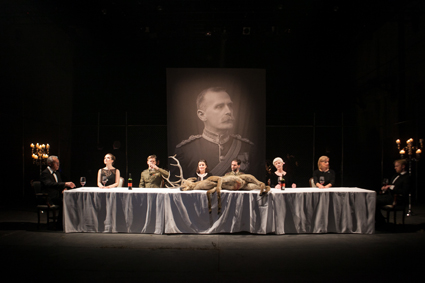
Owen Wingrave, Sydney Chamber Opera
photo Louis Dillon-Savage
Owen Wingrave, Sydney Chamber Opera
Sydney Chamber Opera have successfully resuscitated Benjamin Britten’s TV opera Owen Wingrave (1971) by transposing it to the stage for an Australian audience.
For an opera with a radical message, the original (endure it if you can on YouTube) was sluggish and conservatively realised. Conductor Jack Symond’s pacing of David Matthew’s 2007 adroit chamber orchestration is brisk, intensely dramatic and lyrical where needs be, and all the performances are strong—including a schoolboy choir and a male movement ensemble whose numbers increase our sense of the scale of the issues the opera debates.
Director Imara Savage deftly exploits Karen Woods’ spacious wire-fenced stage, literally an army barracks—replete with a troop of vigorously exercising soldiers (movement director Johanna Puglisi)—and symbolically a psychological prison for the conscientious objector son of a high caste military family. Baritone Morgan Pearse conveys Owen’s moral steadfastness with power and subtlety as he withstands his family’s rejection but finally and fatally weakens in the onslaught from his fiancé Kate—mezzo-soprano Emily Edmonds in a finely articulated, passionate performance.
Staging and direction avoid plain realism—the singing is often direct to the audience, solos are sometimes spotlit, a dead stag (a visual borrow from Benedict Andrew’s AO production of Figaro?) lies across a banquet table, a lamenting boys choir clings to the fence, peering at a fraught adult world, and the flown-in portrait of Owen’s forbear is dauntingly huge and mistily framed. Above all there is a sense of man up against a tyrannically choreographed world, right down to the steady passage across the stage of the ghost of the bloodied child whose death long ago triggered Owen’s rejection of violence.
Britten’s music is more accessible than expected while Myfanwy Piper’s spare libretto is tautly dramatic, although its Edwardian diction rubs awkwardly against the semi-contemporary grain of the production. That aside, Sydney Chamber Opera’s Owen Wingrave was an engrossing and enlightening experience. Director Imara Savage corralled large forces while securing nuanced performances from individual singers, Jack Symonds, as ever, conducted incisively and responsively and the company once again excelled at bringing contemporary chamber opera to a welcoming audience.
Another Sydney-based opera company is Harbour City Opera, whose production of Puccini’s Suor Angelica was engagingly sung if too often one-dimensionally acted (easy to do in this work above others). The uncluttered staging heightened and extended the Paddington Uniting Church altar space out into the audience (seated on three sides) creating an intimate ambience for powerful singing from Sarah Walker (Suor Angelica), Eva Kong (Suor Genevieve) and Sarah Sweeting (The Monitor) in particular. Although the piano score (finely played by Sharolyn Kimmorley) could not do justice to Puccini’s long-lined orchestral plangency, the enveloping flow of the choral performance was memorable. A theatrical highlight came in the form of a statue of the Virgin, high above us, slowly turning her back on Suor Angelica for attempting suicide. The ending that followed was however as sweetly and fancifully redemptive as you’d expect. Next to Owen Wingrave, Suor Angelica is morally slight, and compared with Sydney Chamber Opera’s bold choices and approach, Harbour City Opera is clearly cautious. However, the opportunities it gave its all-female cast were many and deserved.
Sydney Chamber Opera, Owen Wingrave, composer Benjamin Britten, director Imara Savage, conductor Jack Symonds, Carriageworks, Sydney, 3, 5, 7, 9, 10 Aug; Harbour City Opera, Suor Angelica, composer Giacomo Puccini, director Andy Morton, musical director Sharolyn Kimmorley, design Adrienn Lord, Paddington Uniting Church, Sydney, 25, 26 Sept
RealTime issue #117 Oct-Nov 2013 pg. 41
© Keith Gallasch; for permission to reproduce apply to realtime@realtimearts.net
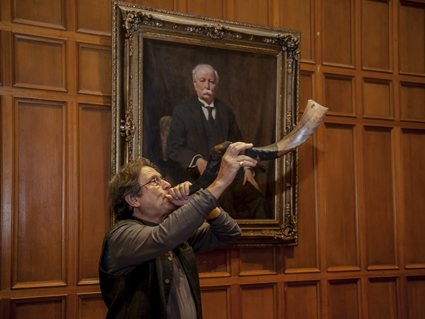
Alvin Curran
photo Marjorie Rose Butler
Alvin Curran
Alvin Curran’s music flits about like an overactive, laterally-thinking mind, jumping from one idea to another, taking the listener on a journey of dramatic musical contrasts. Born in the USA in 1937, and composer-in-residence with Soundstream Collective and the Elder Conservatorium, University of Adelaide, in August, Curran’s work spans half a century of musical evolution.
His Oh Man Oh Mankind Oh Yeah (2009) for choir and ensemble combines conventional and graphic notation with improvisation. Curran appears concerned with the sound of speech—vocalisation as music—and the nature of human communication. The score commences by instructing the singers to emit “deep low grunts,” then to “press tongue lightly on roof of mouth, exhale in long breaths producing airy whistling sound while moving mouth lips pursed!,” and then to bombilate (make buzzing sounds) ad lib and so on. The choir then splits into subgroups as if in conversation and the text includes monosyllabic words from John Cage’s 1989 Norton Lectures. In an uplifting climax, Curran plays the Hebrew shofar, or ram’s horn, a traditional instrument used in Jewish rites, its earthy, primal voice acting like a call to prayer.
In a separate concert, Curran performed his Fake Book (undated) for piano and midi keyboard, beginning by prodding at an upright piano, autobiographically recalling childhood lessons, before sitting at a grand piano and the midi. Fake Book is a humorous but insightful melange of fragments of his own and others’ music and sampled sounds, collected over decades and performed apparently at random, a virtuosic improvisation built from excerpts rather than phrases. The work unfolds as a series of piano episodes jarringly punctuated by recorded voices and sampled and synthesised sounds, evoking a mental picture of the modern sound world—alternately organised and chaotic. Strikingly musical and compelling, Fake Book is a sharply observed account of contemporary music and the composer’s own evolution within it, and it’s a lesson to composers on the musical legacy of the generation of Curran’s youth.
Preceding his Fake Book performance, a chamber ensemble ably led by pianist Marianna Grynchuk gave us Curran’s Rose of Beans II (1997), which opens with a mechanical toy emitting a childish ditty, following which a powerful piano drone develops, overlayed with gestural motifs and melodic lines from the other instruments. The work seems a programmatic summation of compositional development, investigating musical ideas and languages. The title, which sounds like ‘rows of beans,’ plays with the relationship between the sound of words and their meaning. The ensemble performs well but they must play from his score — the difference when Curran performs Fake Book is startling, for he plays intuitively, effortlessly characterising his musical memory.
In a third concert, Gabriella Smart gave a five-hour performance of selections from Curran’s Inner Cities (1991–present), a monumental and still-growing solo piano cycle, in the grand, neo-gothic Bonython Hall as part of Soundstream’s music and architecture project Great Music in Great Spaces. I attended only a preview of Inner Cities at Smart’s studio but found it to be an extraordinary exploration of compositional form and style, which, in extended performance, should amply demonstrate music’s mystical potential. Listening for five hours would be a mesmerising experience. Curran’s invitation to such inner contemplation recalls John Cage’s keyboard cycle In a Landscape and, in his accompanying stream-of-consciousness program note that identifies significant moments throughout his life, he acknowledges Cage’s ideas. In rendering his own lifetime as composition, Alvin Curran shows how composition is inevitably an extension and exploration of personal experience.
Alvin Curran, Oh Man Oh Mankind Oh Yeah, conductor Jesse Budel, Bonython Hall, University of Adelaide, 23 Aug; Alvin Curran and Soundstream Collective, Madeley Performance Space, University of Adelaide, 23 Aug; Alvin Curran, Inner Cities, piano Gabriella Smart, Bonython Hall, 24 Aug
RealTime issue #117 Oct-Nov 2013 pg. web
© Chris Reid; for permission to reproduce apply to realtime@realtimearts.net
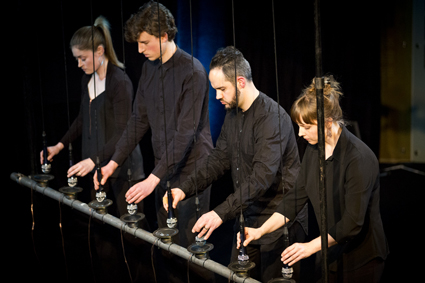
Transducer, Speak Perecussion, THNMF2013
photo Brad Serls
Transducer, Speak Perecussion, THNMF2013
While the title Totally Huge New Music Festival at first sounds like hyperbole, it is in fact classic Australian understatement. The title doesn’t indicate the festival’s ambitious vision for contemporary music in Australia and the exceptional quality of the local and international acts on offer. If that were not enough, this year the festival incorporated the first ever International Computer Music Conference south of the equator.
The result was a staggering range of performances combined with thoughtful reflections on the conference theme “International Developments in ElectroAcoustics” (IDEA) in the heart of the Perth Cultural Centre. The conference’s keynote speakers Agostino di Scipio, Alvin Curran, David Toop, Warren Burt and Haco provided valuable perspectives on their works performed throughout the festival, nuancing the conference theme into reflections on our troubled relationship with music technology.
Alvin Curran
In Way Out Back, commissioned for the festival by Perth’s Decibel Ensemble, Curran draws a map of postwar American art music. Decibel were expert guides through the intertwining paths of minimalist rhythmic phasing, composed heterophony, aleatorism, popular music, timbral collage and live signal processing. After this stylistic pastiche the ensemble explodes into screaming and instrumental noise only to have their protest played back to them, filtered, over the loudspeakers. The piece ends with a funeral chorale, raising the question of whether Curran is signalling the end of art music, the music of his own generation, or could the chorale be saying, “so you don’t want screaming? Fine, have another chorale.” Either way, the piece reflected the existential angst of Curran’s keynote address that narrated, in the finest beat prose, the glorious and disastrous legacy of his generation.
Festival-goers were treated to a taste of this emancipatory legacy when Curran performed Maritime Rites and BEAMS at B-Shed in Fremantle. Though he had to make do with a keyboard reduction of the marching bands and flotillas of foghorns previously used to perform this piece, the cacophony of Maritime Rites filled Fremantle with a bustling and sometimes overpowering sense of abandon. A greater feeling of collective creation was felt in BEAMS, which engaged 50 student musicians from WAAPA and UWA in a series of mass improvisations.
With such commitment in BEAMS and Maritime Rites, why such irony in Way Out Back? As Curran explained in his keynote, every invention of his generation has been commercialised, thus depleting them of any radical potential they may have had. The spirit of ‘happenings’ like Maritime Rites and BEAMS may now be found in flashmob commercials. The hard work of the avant-garde in radiophonic workshops has led to a surplus of bland, overproduced popular music and an immutable (and un-mutable) Western Art Music canon that drowns out the work of living composers. The festival found Curran in a bind that haunts many composers today: too ironic and you might as well not compose at all; too sincere and you remain blind to the social realities of your art.
Agostino di Scipio
Italian composer and installation artist Di Scipio privileges small-scale progress over revolutionary spectacle and dire prognoses. For Di Scipio there is a genuine question to be asked about how we might compose with the dynamic relationships between computers, performers and their acoustic environments. Texture/Residue, performed by Decibel at the THNMF, explores the paradigm Di Scipio calls “Audible Ecosystemics” where sound from the performer or from the performance space itself alters the way a computer modifies live or synthesised sound. The process becomes recursive as the computer’s output is diffused back into the space or modifies what the performer plays. The process is both an instantiation and a criticism of technological determinism, encouraging a practical knowledge of the agencies of the different components of a hybrid performance.
Warren Burt
Standing in stark contrast to the usual Macbook-Pro-and-sound-card electroacoustic setup, Warren Burt’s rigs of old notebooks and first generation tablets can leave one perplexed. But if the possibilities of these machines appear almost saturated to Curran and self-generating to Di Scipio, then they are sources of inspiration to Burt. In Without Glue, Burt tests the improvisatory skills of pianist Stuart Little and saxophonist Sean Little by sending them harmonic and gestural directions via laptops on their music stands. The resulting smooth jazz is fairly conventional, except for the filters, reverberation and glitches introduced by Burt. Improvising on the instrumentalists’ improvisations, Burt demonstrated a different sort of virtuosity, accentuating the saxophone’s changing register with ‘squelching’ delay effects and ornamenting their mellow tones with bursts of sound like science-fiction laser beams.
Haco
An unusual musical use of the ubiquitous Macbook Pro forms the basis of Haco’s keynote performance Stereobugscope. Haco listens to the complex and changing magnetic field of her laptop with a pair of small guitar pickups. The crackling, humming interference varies from task to task, beginning with an explosion of oscillations of different frequencies when the laptop is turned on. The intended effect is a new appreciation of—possibly even sentimental attachment to—the technology around us. In this way Haco reverses her usual creative process, which is to take everyday objects and make them strange to us again.
David Toop
UK-based sound artist, composer and author David Toop poetically explores the relationships between the micro- and macro-levels of his compositions with help from his mentor John Latham’s concept of Flat Time. Flat Time is immediately attractive to the musician because the “roller-blind” metaphor Latham uses to illustrate the concept resembles a musical score, with the left hand side of the blind representing short events (such as light traversing the field of an electron), the right representing the entire time span of the universe and the roller serving as the unfolding present. Toop’s composition FLAT TIME/ Sounding, performed by himself and Decibel, requires the players to interpret descriptions of events, like (though not precisely) “a flake of rust falling into a flooded room,” “a difficult book shut suddenly” or “involuntary humming.” Decibel realised Toop’s composition with poetry and imagination, deftly sculpting each image with clarinet key taps, bowed cymbals and vibraphone, finger-clicking, plucked piano strings and single nylon-string guitar notes.
Michael Kieran Harvey
Tura New Music’s commitment to ambitious programming gave rise to two new large-scale works that deserve to enter into regular performance throughout Australia and the world. Resonating with Toop’s literary style more than the technological theme of the conference, Elliott Gyger’s hour-long INFERNO for solo piano (after Dante) is composed in, as pianist Michael Kieran Harvey puts it, an “unfashionably uncompromising” language. While such music can also express positive affects (including the sparse beauty of INFERNO’s final movement “Stars”), Gyger shows how the techniques of Messiaen, Carter, Ligeti, Birtwistle and other post-war avant-garde composers are particularly well suited to depicting the nine circles of Hell with their tortured bodies and rivers of water, boiling blood and ice.
Transducer by Robin Fox and Eugene Ughetti explores the line between percussionist and microphonist, between the competing agencies of the performer and the instrument. At the beginning of Transducer Ughetti walks onstage and picks up a speaker tied to a cardioid microphone, a device certain to release a squeal of ear-splitting feedback as the sound received from the microphone is played back to the microphone through the speaker. Swinging the device around his head, Ughetti lengthens the cables until the microphone-speaker describes a circle almost as wide as the stage. Four microphones at the corners of the stage are diffused through eight speakers, placing the audience in the centre of a roaring, spinning, pealing vortex.
The piece progresses through the steady addition, transformation and subtraction of sound sources, giving the performance the air of a geometrical demonstration. The rest of Speak Percussion enter and hold up speaker cones to the circle described by Ughetti, modifying a rhythm of feedback by fanning around the perimeter. The ensemble’s geometrical choreography throughout the performance is dictated by the physics of oscillation in sound, electricity and the swinging of the pendulum.
Instruments and electronics
As well as the standalone THNMF concerts and the ICMC keynotes, nightly concerts provided forums for exploring the articulation of electronics with live instruments. While many of the compositions honed a dominant style of “series of extended techniques + digital signal processing + spatial diffusion,” some unexpected effects were produced using alternative speaker systems and non-processing-based electronics. Dan Van Hassel’s Fzzl for solo snare and electronics begins with Louise Devenish playing a simple rhythm on the drum. As the groove continues, the reverberation of the snare seems to expand. One loud strike of the drum releases an impossibly long peal from the snare, at which point the ruse is up: there is a transducer on the bottom of the drum feeding vibrations into the drum skin. From this point on the piece becomes a fast-paced duet between the percussionist striking the top of the drum and the transducer controlled by Van Hassel.
By couching the ICMC within a broader festival, Tura New Music opened the issue of “international developments in electroacoustics” up to a broader range of musical stimuli. Beyond the computer music staples of patches, algorithms and hardware, the conference engaged with art music, popular music and noise. Conversely, having the conference at the heart of the festival allowed for greater reflection upon the works and the festival as a whole. This depth and diversity was represented in the square outside the West Australian Museum after the instrument and electronics concerts. Amid the clubbers on their way to James Street, conference delegates discussed dinner plans in pink lanyards, musicians slung cases over their shoulders, bearded computer music veterans bought ice cream from vans, sound designers with incredible eyewear sipped wine at the PICA bar and noise fans drank from BYOs beneath a giant screen beaming squawking, humming audiovisual works.
RealTime issue #117 Oct-Nov 2013 pg. 42-43
© Matthew Lorenzon; for permission to reproduce apply to realtime@realtimearts.net
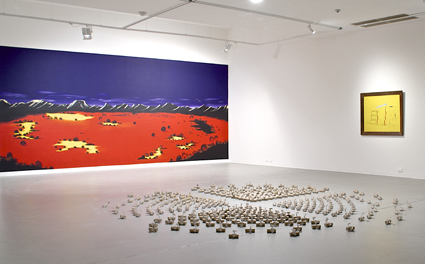
Blender, installation view of artworks by Allen Sparrow, Dagny Strand and Lorry Humphreys, Australian Experimental Art Foundation, 2013
photo Alex Lofting
Blender, installation view of artworks by Allen Sparrow, Dagny Strand and Lorry Humphreys, Australian Experimental Art Foundation, 2013
Since Harald Szeemann reinvented the role of the curator in the 1970s, thematic exhibitions, in which each artwork forms an element in a coherent whole, have become well established. The creative partnership of artists and curators is frequently a primary strategy for developing new art and igniting its appreciation.
In Flinders University Art Museum’s magnificently crafted Crystal Palace exhibition, curator Lisa Harms traces exhibitionary practice back to London’s Great Exhibition of 1851. Harms invited seven high-profile artists including a poet to make works responding to items in the collections of Flinders University’s Art Museum, the University Library, the South Australian Museum and the Museum of Economic Botany, the final form of the exhibition developing collaboratively from this initial concept. She erected a large room inside the FUAM gallery, exhibiting the works within and around this room and in niches in its walls, creating a walk-in cabinet of curiosities, recalling the Victorian approach to collecting and displaying exotic specimens. With around 100 exhibits in total, including Joseph Nash’s 1852 illustrations recording the Great Exhibition, Harms’s Crystal Palace evokes the Great Exhibition’s sensibility and legacy of collecting.
The participating artists responded to selected museum items by making new work or enacting performances. Siamak Fallah, whose delightful illustrations adorn a wall, is himself an exhibit, working at a computer in an office within the installation, furnished with antiques from the Flinders collection to which he responds. Domenico De Clario, reflecting on an Albert Namatjira landscape, performs live and in video playing a spinet, an early form of piano that might have been used by 19th century collectors and colonists, and including a visual record of his recent camping-trip occupation of the university’s grounds. Lee Salomone, a long-time collector and exhibitor of domestic objects, shows works made from these, including saucepan lids mounted with bronze castings of fallen leaves, in response to the Museum of Economic Botany’s collection. Morgan Allender’s oversize still-life painting responds in a painterly manner to botanical illustrations, and Julie Henderson’s complex array of objects, including automated mechanical devices, is inspired by the consideration of the relationship between people, space and functional objects.
Contrasting with Crystal Palace is the AEAF’s Blender exhibition, for which AEAF director Christine Morrow assembled work by six artists from regional South Australia. Morrow looked for artists who could benefit from the opportunity to expand their work and experiment. She sees the AEAF’s role as catalysing experimental and developmental art throughout SA and the Northern Territory, stating, “Blender shapes and informs the dialogue between centres and peripheries in contemporary practice” (catalogue). Port Pirie Indigenous artist Allen Sparrow’s depiction of the Flinders Ranges in red, yellow and black (under a deep blue sky) rather than in natural landscape colours is a work of emblematic power that reappropriates the space through the use of the mural form instead of portable canvas or board. Penola artist Dagny Strand’s work, occupying half the floor, comprises hundreds of toilet roll tubes each cut to form the silhouette of a tree, referencing South-East SA’s forestry industry. Pamela Kouwenhoven makes articulate use of discarded materials in her tableau of car-battery cases mounted on the wall and, standing on the floor, a forest of charred paper rolls retrieved from a paper mill following a fire.
In a parallel AEAF exhibit, James Dodd and NT artist Franck Gohier collaborated in making The Hole in the Wall Gang, an animated video of an imagined dialogue in which Gohier relates a characteristically NT anecdote.
Within the annual SA Living Artists Festival, involving thousands of artists across the State, these contrasting exhibitions demonstrate the diversity of SA art and the balancing act involved in curating it. Blender is a small but significant cross-section of regional art that addresses to city audiences these artists’ particular concerns. In Crystal Palace, however, the art object becomes subsidiary to its re-contextualisation, pushing the curatorial role to its logical conclusion. The artists demonstrate how we might interact with and recreate our own histories and cultures, but Crystal Palace acts as a single work comprising multiple elements — the artworks, the specimens, the texts and the exhibition space itself. The necessity for viewers to approach each work both in isolation and in its curatorial context is especially evident in Crystal Palace.
Crystal Palace also interrogates the Great Exhibition as a symbol of transnational capitalism, modernity and colonisation and the effect of “hot-housing” industrial development and cultural cross-fertilisation. Harms says, “Crystal Palace sets out to encourage post-colonial readings of these ongoing, resonant reflections — both beautiful and troubling — against a contemporary climate of increasingly heated and conflicting attitudes towards protection, preservation and exploitation” (catalogue). The works from the museums have gathered significance and meaning since they were made and, through juxtaposition, we’re prompted to reinterpret them and weigh their historical value.
The cultural enquiry that inevitably underpins curating propagates cultural re-evaluation and development. Flinders Collections Manager Nic Brown says in her catalogue essay, “By inviting contemporary artists and curators to respond to its collections, Flinders University Art Museum takes the opportunity to be reinterpreted itself.” We thus reconsider museology generally. Morrow’s Blender establishes a temporary museum of SA regional culture, testing our idea of regional art and the perception of the artist as regional while, importantly, amplifying each artist’s voice. By inviting artists to respond to our subjective, cumulative pictures of history, these curators extend the culture of artistic creation that parallels and informs our ongoing self-historicisation.
Blender, curator Christine Morrow; The Hole in the Wall Gang, curator André Lloyd Lawrence, Australian Experimental Art Foundation, 26 July-17 Aug; Crystal Palace, curator Lisa Harms, Flinders University Art Museum, 27 July-29 Sept
Chris Reid is an administrative staff member of Flinders University but is not connected with the Flinders University Art Museum.
RealTime issue #117 Oct-Nov 2013 pg. 46
© Chris Reid; for permission to reproduce apply to realtime@realtimearts.net
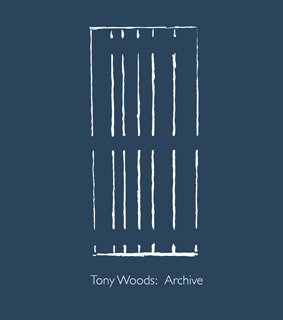
Book & DVD: Tony Woods: Archive
This large format book features excellent reproductions of this leading Melbourne artist’s works along with a DVD of his films and a documentary about the artist and their making. In her review of the book, Danni Zuvela writes:
“We are drawn into this complex and talented artist’s world, given access to his creative inspiration and evolution at a deeper level than other modes of artist biography that might sacrifice depth for gloss. Invited to muse on the aesthetic and conceptual relations between the artist’s practice across canvas, celluloid, pixels and audio tape, we start to develop insights into how the dialectic of representation and abstraction powers an artist like Tony Woods, finding varied expression across forms, materials and decades… Tony Woods: Archive, with its detailed understanding of an artist whose work should be more widely known, is a rare and worthwhile addition to the annals of Australian art history.”
1 copy of Tony Woods: Archive, courtesy of publisher www.artinfo.com.au and distributor Australian Scholarly Publishing ASP.
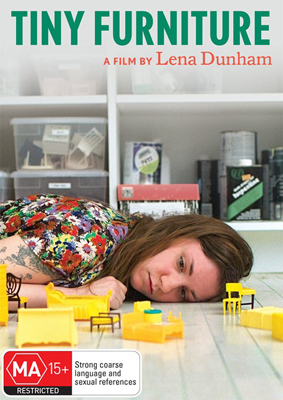
DVD: Lena Dunham, Tiny Furniture
We first heard of Lena Dunham’s film Tiny Furniture a couple of years ago from one of those succinct reviews at the front of The New Yorker. Now the film is finally available in Australia, no doubt due to the fact that since 2010 when she made the film, Dunham has created the wickedly funny and brutally frank hit TV series Girls.
In Tiny Furniture you not only see the emergence of the 20-something preoccupations and anxieties that govern Girls, you’ll also meet Dunham’s mother—the artist/photographer Laurie Simmons—and sister who play themselves. If you’re a fan of Girls you won’t want to miss this low key but fascinating precursor.
5 copies courtesy of Transmission Films
Please note you can nominate for ONLY ONE GIVEAWAY.
Email us at giveaways@realtimearts.net with your name, postal address and phone number.
Include ‘Giveaway’ and the name of the item in the subject line.
RealTime issue #117 Oct-Nov 2013 pg. 48
© RealTime ; for permission to reproduce apply to realtime@realtimearts.net
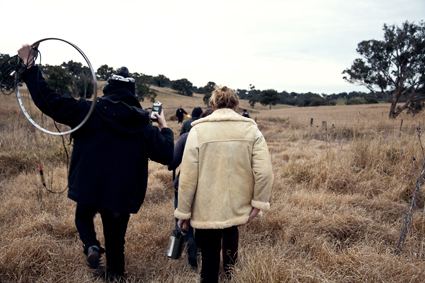
Participants in the field with their bike loop antennas during the Haines & Hinterding Fields of Frequency workshop, Wired Lab, July 2011,
photo Sofie Muceniekas, Shoot at Everyone Imaging
Participants in the field with their bike loop antennas during the Haines & Hinterding Fields of Frequency workshop, Wired Lab, July 2011,
Situated on a property 30kms from Cootamundra in New South Wales’ Eastern Riverina District, Wired Lab is a space for interdisciplinary sound and art explorations. It’s also a functioning farm and familial home of the founder Sarah Last and her partner David Burraston.
Last was a member of the Wagga Space Program Collective, producer of the unsound festivals (2000-2006). She took over the reins in 2003, curating ambitious site-specific events such as Mutable Landscapes (2004), a residency program bringing national and local artists together to work on site-based artworks, and Locomotivus (2006), a performative train journey (a format Last has continued to explore). The Wired Lab can be seen as the logical extension of these activities. Last and Burraston met during Locomotivus; the year after he made the move to the country. Originally from the UK, Burraston is an artist, scientist and composer with extensive knowledge in generative systems and what he terms “creativity and complexity.”
On-site and wired up
Last started Wired Lab in 2008 with one of the inaugural ArtLab grants from the Australia Council. To bring a curatorial focus to the early projects the lab focused on the creation of long wire instruments pioneered by West Australian artist Alan Lamb, also involving guest artists such as David Burraston, Oren Ambarchi, Robin Fox and Garry Bradbury. Last explains, “the seed funding was oriented around the wire instruments and a desire to construct some of those and work with a team of artists to investigate them. That area of work was really connecting with what I’d already been doing in terms of landscape-scale practice and working outside of institutional constructs in the open field. While a lot of the early work was aligned around wire instruments, the project itself is broader than that, exploring old and new media and interdisciplinary experimentations…Essentially I want Wired Lab to be a platform of activity for contemporary art research and practice in a regional context. I’m also interested in exploring different models of operation for artist-run collectives.”
A particular focus of the Wired Lab is on skills and development. Across the year, it offers intensive masterclasses and workshops for both local and national artists in various areas of sound creation and arts production. Often these are led by visiting international artists undertaking residencies at the lab, such as renowned field recordists Chris Watson (UK), Jez Riley-French (UK) and Douglas Quinn (US). Last explains, “In terms of the artists we work with there’s got to be a reciprocal interest—and the conversation really goes from there. For skills development it’s about providing access to the best possible teachers that we can get. That’s not to say that those skill sets aren’t in Australia but it’s important to hear and learn from people who are working and practising in an international context. From a regional perspective, it has often historically been the case that we’d get pretty second rate programs offered to us. It’s been one of my long-term commitments to prove that from a regional basis you can provide access to and generate high quality activities.”
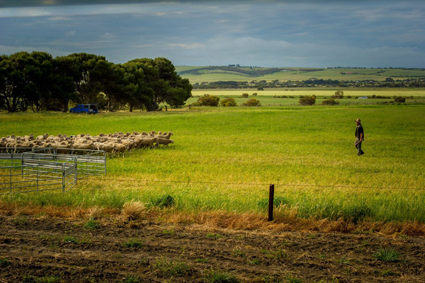
Sheep Muster, Southern Encounter, Wired Lab
photo Chris Herzfeld
Sheep Muster, Southern Encounter, Wired Lab
Off-site and on the rails
While Wired Lab offers an ongoing environment for site-specific explorations, Last is also interested in activities beyond their premises, particularly in other regional sites around the country. One of these projects was Southern Encounter, commissioned for Kumuwuki (Big Wave), the National Regional Arts Conference and Festival held in Goolwa, South Australia last year. (Southern Encounter recently won in the categories of Excellence in a Regional Area and Excellence in Experimental Music at the 2013 Art Music Awards.) Building on her earlier rail-based projects, Locomotivus (RT76) and Rolling Stock (2011, RT101), Southern Encounter involved a four-hour rail journey between Victor Harbor and Strathalbyn with six “happenings” along the way created by Tristan Louth-Robins, Luke Harrald, Matthew Timmis, Public Assembly (Lynda Roberts, Ceri Hann) with Jesse Cox and Eddie Roberts. (The project was then “storified” by Fee Plumley.)
Last and Burraston contributed two of these performances. In Sheep Muster, the train pulled up in a paddock so the audience could watch the sheep being herded, the sounds of which were captured via microphones around the paddock, mixed live and broadcast throughout the train. In the second performance, Piano Drag, Last and Burraston secured a piano to the back of the train and amplified its glorious demise. “We got a hell of a lot of feedback and white noise which was great…We had a video feed going through the carriages as well so people could watch that deterioration happen. It was distressing as well as enthralling. A number of the audience weren’t particularly enamoured with the feedback coming through the speakers but you’d be pretty worried about your work if everyone liked it. You need to have that tension and polarity in the experience.” The clamour of the piano’s disintegration contrasted with a performance by the Ngarrindjeri Rritjarukar Choir singing in language. It drew attention to their physical and sociological presence in the landscape and how that landscape has changed. This was also reflected in the course the rail journey took both through pristine bush, coastal developments and cultivated agricultural land.
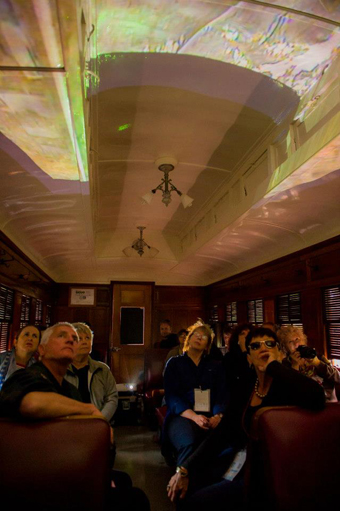
Piano Drag, Southern Encounter, Wired Lab
photo Chris Herzfeld
Piano Drag, Southern Encounter, Wired Lab
Recording country
Focusing specifically on this interrelation of Indigenous peoples and the landscape is the Box Gum Grassy Woodlands Acoustic Ecology project, currently in early development. It will be a multi-year activity focusing on the local habitat native to the region around Wired Lab. While it’s an acoustic ecology field recording project, the Lab will also work with members of the Wiradjuri community, the Indigenous peoples of the area, assisting in their language rejuvenation programs. Last explains, “The thing that’s really important to any language or cultural rejuvenation is connecting it to land. So we’re currently in the process of developing a project that will ultimately have a number of creative outcomes. One will be the training of Indigenous people in audiovisual documentation, which is important in the preserving of histories. Other outcomes will be a website that will connect the oral language and country element with other creative outcomes like a touring exhibition imagining what a pre-colonial rendition of this landscape might have sounded like.”
Future connections
Five years in and Sarah Last is pleased with the way the Wired Lab activities have expanded and the directions in which it’s heading. In particular she’s interested in exploring and experimenting with connections between disciplines: “pushing creative practice into arenas where perhaps it’s not been fully developed or recognised by people, for example, working in science, environmental science, agriculture and linguistics.” This year Wired Lab received seed funding from Innovation Australia to be a regional hub for Science Week activities: “it seemed an ideal fit in terms of what we were already doing. What I really liked about this regional science hub element is that it’s very focused on the area that you live in, making science accessible and relevant to the everyday.”
The next major event will be the Wired Open Day in which the public is invited to take in the site and experience a range of activities and performances across an afternoon and evening along with the (G)local Frequencies Project still in development. After several of these events contending with wilful spring weather and the harvest season, Last has moved this activity to Autumn (May 2014). So stay tuned to the wires early next year to find out more about it.
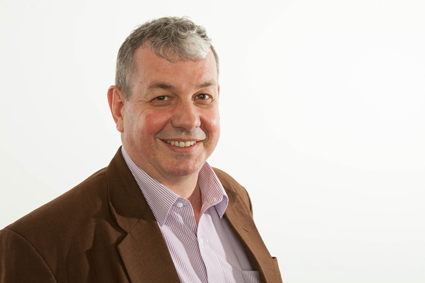
Andrew Donovan
image courtesy Australia Council
Andrew Donovan
Andrew Donovan’s benign manner goes hand in hand with his gentle enthusiasm and quiet determination to encourage adventurous Australian artists through his role as Director of the Australia Council’s Emerging and Experimental Arts section, formerly the Inter Arts Office. I met with Donovan at the Council offices to discuss the change in terminology to “experimental” and its ramifications for the Council, artists and audiences. Will it be business as usual but with more meaningful nomenclature engendering greater opportunities to support innovation?
Over the last 30 years at least, interactions between art practices and disciplines have proliferated, yielding mutations of existing forms and unexpected crossovers as well as terms aimed at explanation or containment. These include ‘cross artform,’ ‘multimedia,’ ‘interdisciplinary,’ ‘intercultural’ and ‘transdisciplinary’ as well as ‘new media arts’ and post modernism itself.
In the last decade ‘hybrid arts,’ has been widely deployed, but as exchanges between practices and disciplines flow into mainstream arts and become the norm, it is no longer useful as a descriptor for innovation—a word itself that has unfortunately become tied to Western notions of endless progress. To rephrase Paul Virilio’s dictum on technologies and accidents, for every innovation there’s a likely exploitation.
For Andrew Donovan the choice of ‘experimental’ is about communication within the Australia Council itself, with artists and the public: “There’s the arts community that knows what we do, what we fund and the sort of work we mean when we talk about hybrid or interdisciplinary practice or media arts practice. Then there’s the other side, the broader community that tends to glaze over when they hear those terms. There came a point when we felt it was important to be able to communicate much more succinctly to the Australia Council, to the governing board of the Council, to the broader community and also to politicians and people who really don’t know much about the sort of work we’re funding—to try to find a short-hand way of letting them in.
“The full name of the section is Emerging and Experimental Arts. ‘Emerging’ refers to emerging art forms and practices, not the emerging artist. The shorthand version is Experimental Arts. Since we’ve made the change I’ve certainly found in my interactions with people who really don’t know anything about what we do, they understand what ‘experiment’ is and they don’t have too much trouble putting it together with ‘arts.’ They immediately have a sense that it’s something that is pushing boundaries, trying stuff out without necessarily needing to succeed or having a predictable outcome.”
Donovan believes “the governing board and the Council have really embraced this notion and are very supportive of Australia having a strong reputation in that space. I think that’s where people see the really cutting edge of innovation happening, in the crossover between the arts and the broader culture—programs like Synapse that sit within experimental arts but also things we’ve done over the past few years that see artists working in non-arts settings, whether it’s in business or the food sector or universities or whatever. ‘Experimental arts’ is a lovely umbrella term for everything we’ve funded over 40 years in this space. So the change doesn’t say we’ll not be funding any of the stuff we’ve funded in the past.”
I wondered how we know when a work is experimental and how it can be assessed for funding. Often it’s a sensory response; the work plays with perception, sometimes disorienting us, putting us in unusual situations, as in many a Live Art work. It’s not necessarily your intelligence that identifies a work as experimental. Donovan recalls that at the Emerging and Experimental Art forum held at Carriageworks, 5-6 May this year, “there were wonderful terms people were using to talk about the work, such as ‘anti-aesthetic’ or ‘problem-finding’ rather than ‘problem-solving.’ Those sorts of concepts are quite abstract but I think when you see the elements put together in an application, the assessment panel recognises that’s the kind of thing we’re looking for.”
Given that ‘experimental’ can suggest a scientific model I wonder if loose notions like risk-taking and uncertain outcomes might be usurped by a strict expectation of definite outcomes. Donovan is adamant: “Certainly the way we’ve set up the funding criteria, it’s not like the artists are making an application to the Australian Research Council! This is the Australia Council. There was, however, a very strong response from the panel that looked at the first round of Experimental Arts grants this year to say, ‘Look, you need to be very clear about what the experiment is.’ I don’t think we’re going down the road of asking, ‘What’s your research question?’ But we are certainly saying, ‘Be very clear about what you’re investigating and what ideas you’re wanting to push through a project.’ I think in some of the applications in the first round there was an assumption that ‘Oh, well, you know what we do; we’ve always done this so just fund this application.’ There was a strong response from our assessment panels to say that people need to be very clear what they’re experimenting with and where it sits in the continuum of the historical context of their practice.”
However, an aesthetic response can be hard to quantify compared with the outcomes demanded of scientific experiment. Again, Donovan is firm, “The people we have around the table are not scientists; they’re artists. They’re looking for that aesthetic angle within a project as much as they’re looking at the experiment. We’ve left it quite deliberately open. We don’t want to prescribe what we think an experiment model is. We want people working out there to tell us why they think what they’re doing is experimental and we’ll put together a group of people to assess those ideas.” Presumably, given the technologically and scientifically advanced nature of some artworks nowadays (for example, the works of Efterpi Soropos and George Khut detailed in our Art, wellness & death feature in this edition), doubtless specialists in non-arts areas (including the increasing number who have worked with artists) might need to be called on for opinions in the future.
The importance of being able to share the knowledge that comes out of experimental art-making came up at the National Experimental Arts Forum. Some worried about ‘business in confidence;’ others said, ‘my project’s so long-term I don’t want to be putting it out piecemeal; others wanted everything open-sourced and acquittals made publicly available. Donovan declares “an interest over many years in how we might unlock a lot more of the information we get through acquittals. But the people who are pointing out the barriers are quite correct. At the moment, a lot of the information we receive is covered by the Privacy Act. We’d need to adjust our systems in some way to alert artists that, if they wanted to, part of their acquittal could be made public. We need to approach it fairly carefully to make sure that artists can see that there’s a clear benefit to them doing it.
“The Australia Council also has a great interest in how we evaluate the impact of our programs. A lot of the focus has been on the granting process. That will still happen, of course, but I think you’ll see an increasing shift in some of our resources to the evaluation of the impact of those programs and the impact of the work that artists are making. It’s certainly something we’re talking about.”
The diversity of examples of work described at the forum was quite amazing, much of it highly unusual. Donovan says, “One of the pleasing things about having ISEA in Sydney this year was the very positive response to Australian work we got from the international audience. After I did a presentation on what we’re doing through Emerging and Experimental Arts, a number of people from other countries rushed up saying, ‘I wish our funding body was doing that!’ I’m very keen to focus on communicating over the next few years a very comprehensive sense of the diversity of this work.”
Donovan is already planning for the next National Experimental Arts Forum which will probably be held in early 2015. “The first one was limited by financial restrictions but the next one we’ll tender out and it’ll be a much more open process and hopefully have a lot more delegates as well as making it a really great national discussion about experimental practice.”
I ask if this indicates long term commitment to the experimental for Andrew Donovan himself, who by 2014 will have been with the Australia Council for 20 years. “Absolutely,” is the answer. “I have always approached the experimental as a kind of slow-burn field of practice. You need to build up the credibility and the reputation for it over many years. It’s the absolute excitement and wonder of the work that keeps me engaged. You see the most amazing things and watch artists working in the most amazing ways. It just constantly surprises me.”
RealTime issue #117 Oct-Nov 2013 pg. 18
© Keith Gallasch; for permission to reproduce apply to realtime@realtimearts.net
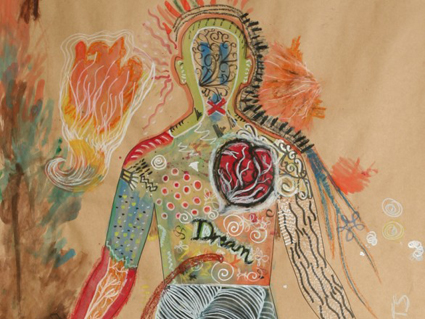
Section of experiential map contributed by participants at UTS Gallery, 2008; The Heart Library Project, George Poonkhin Khut with Caitlin Newton-Broad, David Morris-Oliveros and Greg Turner
photo Julia Charles
Section of experiential map contributed by participants at UTS Gallery, 2008; The Heart Library Project, George Poonkhin Khut with Caitlin Newton-Broad, David Morris-Oliveros and Greg Turner
Our Art, Wellness & Death feature is the first of two focusing on innovative artists—in this edition Efterpi Soropos, George Poonkhin Khut, Victoria Spence and Margaret Cameron—whose work has taken them into unexpected fields of practice to deal with illness, pain, dying and grieving. In a related interview Jo Truman reflects on how improvised song has empowered her with a sense of embodiment.
Sydney’s irreverently venerable Performance Space celebrates its 30th birthday in November with presentations from former artistic directors and performances by The opera Project, De Quincey Co, Rosalind Crisp, Brown Council and a multitude of artists spanning the organisation’s rich and often provocative history. A not-to-be-missed celebration.
Violence in art, and as art, in this edition appears in several forms: for its own sake (the action movie Death Race 3: Inferno); as re-creation, by the killers themselves, of the infamous mass murders in Indonesia in 1965 (a documentary, The Act of Killing); as a surreal take on a wave of apparently senseless murders in China (Jia Zhangke’s A Touch of Sin); or in version 1.0’s new work, The Vehicle Failed to Stop, about the murder of Iraqui citizens by armed Western contractors operating outside the law.
RealTime issue #117 Oct-Nov 2013 pg. 3
© RealTime ; for permission to reproduce apply to realtime@realtimearts.net
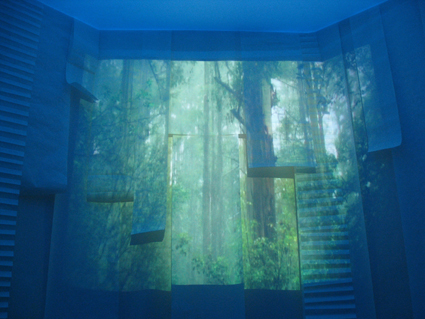
disambiguation room, Efterpi Soropos
image courtesy the artist
disambiguation room, Efterpi Soropos
Since training at NIDA in the 1980s Efterpi Soropos has created lighting designs for theatre productions around Australia, made her own installations and taught at the Western Australian Academy of Performing Arts (WAAPA). In recent years her focus has been on developing immersive artistic environments in palliative care after witnessing her mother’s distressing hospital experience when dying of cancer.
Soropos completed a Masters in Community Cultural Development, at the VCA in 2007 theorising about the alleviation of suffering in hospitals. In 2008 with an Ian Potter Cultural Trust grant she travelled to the UK and Holland for research. Out of this period came a prototype project at McCulloch House, Monash Medical Centre, titled the disambiguation room, commencing 2008 and funded by a grant from Arts Victoria, Community Partnerships.
The successful project by Soropos and her collaborators (see the artist’s website) became Human Rooms, an artistically driven commercial enterprise offering consultation, training and project development. Soropos was recently awarded a Churchill Fellowship. I spoke to her about the motivation for and the practicalities of her work and where it’s taking her next.
Where is your focus at the moment?
My focus has always come across as a bit vague, which is probably a typical way of seeing an artist’s outward persona. But I think I’ve discovered that it disguises a form of defiance and sharp analysis, which has enabled me to turn the disambiguation project into a permanent part of McCulloch House. It was always meant to be a temporary project and it’s now been re-designed and re-installed as a permanent installation. I’ve also developed a mobile version of the concept—a box that contains a selection of film images, sounds and lighting states that have been used in the original room, but now can be installed in a patient’s room.
My original intention with the project was to create a space for people to die in. And at the time, that was [seen as] just too out-there. So then I tried to find ways on a technical and practical level—how do you take that concept and put it into a space that a patient inhabits constantly, a hospital room? So I’ve been developing that concept and its commercial prospects. That artistic concept of Human Rooms can now be used by a variety of people in a number of spaces—in a home, a hospital, an aged care facility, a cancer centre, a palliative care centre.
How does the portable version work?
It’s a unit that has an immersive screen operated through wireless. I’ve developed an app so that patients, families or staff can set up the mobile version over a patient’s bed. This can be done in a shared ward where we know it’s very difficult to find peace or relax and, apart from painkillers, to reduce pain or psychologically find some way of being distracted or immersed.
What kind of images and sounds do you provide?
The basic concept of Human Rooms is built around immersion in a form of meditation with the sensory elements of image, light and sound either working in combination or as individual components. They find it engages them enough to precipitate some kind of psychological release. I’ve also used some animation based on simple, natural ideas, like cells re-forming and morphing which helps people to re-engage with, say, blood. These images can sometimes help people self-connect again if they’re feeling like they’re just a body with a disease in a hospital, or just a number and they’ve lost a sense of themselves.
What is the role of colour?
An Australia Council Inter Arts Office residency grant enabled me to work for a year with patients individually in rooms in the initial project. Sometimes women, for example, would prefer the room to be red. It made them feel like they were in a womb-like space or they were connecting with blood—maybe it’s because of our bodily function. Men might find red a colour of rage, or frustration, and they may have preferred the blue whereas women may have found blue cold. Colour is very subjective and also colour can bring up memories good and bad.
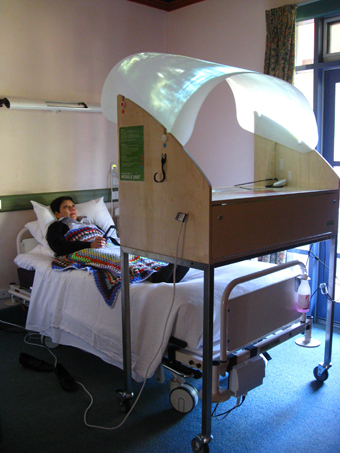
Mobile Immersion Unit, Human Rooms, Efterpi Soropos
image courtesy the artist
Mobile Immersion Unit, Human Rooms, Efterpi Soropos
So the app provides patients with choices?
Yes. When I hand these spaces over to staff and train them in how to use them, I always push the idea of creating something very soft or very subtle before bringing someone into the space. Then allow the person the opportunity to choose from the library. It’s all designed in such a way that the whole room [or the portable version] completely changes colour and the sound surrounds the listener. The rooms become…I was going to say ‘womb-like’ again but some people wouldn’t see it like that. The experience is very subjective.
Are institutions interested in buying into this?
I think it’s being viewed as another option. Medical staff are very limited in terms of what they can offer. A lot of hospitals have what they call ‘allied therapists’ these days. It’s all lumped under one category and includes everything from occupational to art therapy. Therapists can use Human Rooms for their work. I’ve trained pastoral carers, social workers and psychologists.
Have you completed this phase of your work?
I’ve probably completed it in terms of cancer care and palliative care. I’ve made these very subtle, integrated artworks. I’m now interested in developing a similar concept but at the other end of the spectrum, to create a bit of fun.
One idea is for a ‘playground’ for the elderly. In nursing homes there’s a form of multi-sensory therapy called Snoezelen, which was developed in the 70s in Holland by occupational therapists and psychologists who wanted to find a way to engage and relieve the anger and frustration experienced by people with special needs, using rooms that look like discos with the ball pits and coloured balls you see in playgrounds. They worked out that people with special needs responded to tactile and over-the-top visual stimulation. They’ve tried to move this into aged care to deal with people with dementia and Alzheimer’s. However, so that it’s safe, it’s a very one-on-one practice. I’m interested in developing a more artistic environment that engages people immersively but can be safely operated through apps and interactive panels. I also think that this would be suitable for kids with autism and Asperger’s.
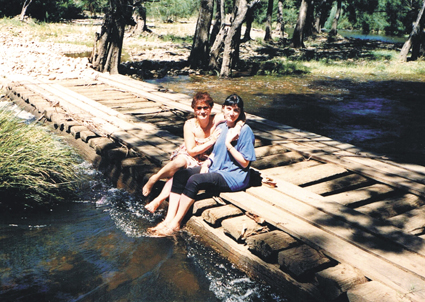
Efterpi Soropos and her late mother Evangalia Soropos, 1987
courtesy the artist
Efterpi Soropos and her late mother Evangalia Soropos, 1987
How will your Churchill Fellowship help you?
I’m going to meet a variety of artists and health practitioners who are developing what we call MSE—multi-sensory environments—in the area of dementia in particular. I’m also very interested in culturally specific material—an adult in a dementia unit may revert back to the culture they came from. I’m going to Hong Kong to meet a group of artists who make culturally specific dementia projects at St Marks Hospital. I want to focus on one culture and see how the unit addresses this area. Artist Bellini Yu and the Art in Hospital organisation in Hong Kong work with sound, shadow and memory. I’ve been developing an online relationship with her and she’s also organised a workshop that I’m going to give to a group of artists she’s working with.
Then I’m going to London, firstly to King’s College, a major teaching hospital. Their new Marjorie Warren Dementia Unit has been completely designed for sensory input. So from when you walk in through the door, the colours on the walls and the flooring, all the finishes, the lighting, everything is designed for the senses. It’s beautiful. But they don’t use film, sound and lighting interactively as I do. I’ll also meet Anke Jakob, textile/projection designer/architect and researcher into MSEs at Kingston University. An aged care facility might want its staff or carers to have an understanding of what it’s like for a person with dementia to be in a nursing home, so the unit sets up immersive rooms that provide insight into what it’s like being inside the head of that person. These virtual environments are produced in Hull by She Knows Ltd, another Churchill destination for me.
What’s the attraction of Japan?
I will go to Japan, for the first time, to see the work of some of my favourite Japanese installation artists, like Eriko Horiki whose paper and light installations look to me like extraordinary spiritual spaces. On the opposite end of the spectrum I love the work of Chiharu Shiota who makes exquisitely dark memorials to life and death, covering inanimate objects and clothing in string that looks like a form of lace or a second skin. It’s delicate and fine but also kind of forbidding.
As an expert in your field and hoping to make a living in it, do you still feel like an artist?
The idea of what an artist does has now expanded in so many different directions. Heading into something like a commercial enterprise I still feel like an artist because I’m still able to come up with new ideas and be inspired by everyday things and people’s experiences. I had an epiphany when I was working on large-scale events in the 1980s and 90s—like the Mardi Gras parties. I was struck by the fact that people would go into an over-frenetic, loud and intense space to move as energetically as possible. But then when they needed it, they’d go into a chill-out space, calming them when they were very high, agitated or drunk. I knew there was something in that for people who had no choice in the state in which they found themselves.
Efterpi Soropos, Human Rooms, Experiential Art and Design, humanrooms.com
RealTime issue #117 Oct-Nov 2013 pg. 4-5
© Keith Gallasch; for permission to reproduce apply to realtime@realtimearts.net
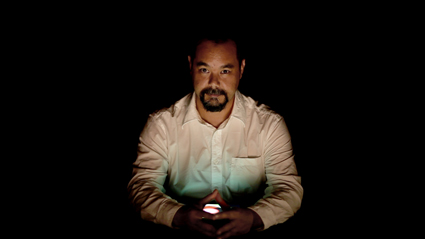
George Poonkhin Khut
photo Julia Pendrill-Charles
George Poonkhin Khut
I’ve been making body-focused artworks combining biofeedback interaction and audience participation for the past 10 years. I started working in this area, excited by the potential to create work that combined the evocative worlds of electronic art with the visceral, moment-to-moment directness of a participant’s own physiology.
I continue to be motivated by a deeply felt desire to address what many have identified as a serious disconnect in our culture between how we experience, represent, use and treat our bodies, and what we are learning about our embodiment from the disciplines of psycho-physiology, neuroscience and contemporary somaesthetic philosophy.
Inspired by fleeting glimpses into the sublime and richly embodied subjective spaces made available through meditation, Tai-chi and Feldenkrais somatic bodywork, I’ve been searching for ways to incorporate these sensibilities into seductive interactive artworks that can help make these elusive ways-of-being and knowing accessible to a wider audience that is less likely to have the patience to adopt them.
My works provide conditions and instruments for audiences to observe and experiment with how they can influence their bodies through changing breathing and stress/relaxation via real time analysis, primarily via heart rate variability, and more recently—in the ThetaLab project (see next page)—through modes of meditative focus used to modulate electronic soundscapes controlled by brainwave rhythms.
A participant’s role is to bring the work into their consciousness—as a collection of experiential reference points—making them capable of reframing subsequent experiences of self and then body-mind connection, and then in the realm of social interaction. In this way we can ‘practice’ a more holistic concept of self that acknowledges the strengths and limitations of our embodiment and circumstances.
Experimentation and research into the experiences these works produce in the participants have always been central to my work (begun as a Doctoral research project at University of Western Sydney in 2002), but since 2008 I’ve been focusing particularly on how the works can involve audiences as researchers. In doing so the work has evolved new social practices that re-frame our experience of, and attitude to, the self and its embodiment. I’m interested in art’s capacity to inspire people from a wide cross-section of society—to create shared reference points for how we can be and relate to the word around us, here and now. I’ve presented these works in art galleries, science museums and hospitals.
In 2011 I began the BrightHearts research project—a collaboration with Dr Angie Morrow, a brain-injury specialist at Kids Rehab in the Children’s Hospital at Westmead, Sydney. The aim is to research, design and evaluate the potential of my heart rate-controlled artworks for managing the pain and anxiety experienced by children undergoing painful procedures, with needles for example. With support from the James N Kirby Foundation and a residency grant from the Australian Network for Art and Technology (ANAT) I was able to research clinical practices and prototype a new tablet-based work suitable for use during clinical procedures.
A version of this work went on to receive the 2012 National New Media Art Award at the Queensland Gallery of Modern Art (GoMA). A pilot study with children at Westmead is scheduled for late 2013, to be followed by a randomised clinical trial in 2014, pending further research funding. The clinical trial will assess the efficacy of our heart rate-controlled biofeedback relaxation training ‘app’ compared with standard distraction-only tablet-based games that are increasingly used in clinics during painful or distressing procedures.
Beyond its application in pediatric clinical settings I’ve been working on a version of the work for general release, with the establishment of Sensorium Health Pty Ltd, a partnership with fellow interaction designer Jason McDermott (formerly of ARUP Urban Informatics). We’re excited about the possibility that mobile apps present for reaching new audiences with this creative relaxation training tool.
Our vision is for an interaction experience that combines electronic art, wellness coaching and social media technologies. The decision to market the work as an app for relaxation training—rather than as a creative app to be appreciated in its own right—has been taken for entirely pragmatic reasons. It’s based on a large, clearly identifiable market capable of financially supporting the development of specialised wireless sensing technologies able to provide accurate heart rate data.
The question often arises, ‘Is this art or science?’ It’s a good question in that it can help us to re-assess the range of conditions and expectations we place on both art and science: what is it that these practices need to do (or not do) for these terms to be useful? It’s essential to recognise that these works are primarily focused on mediated experiences of self—not just technology. The participant is an essential part of the compositional system, one designed to re-route neural connections, through the provision of new or unusual forms of action and sensation.
This is what drives and inspires me to continue working with interactive and participatory systems. It’s the sensual, first-person way of knowing, learning, sharing and interpreting that places this work firmly within art traditions—as we understand them in Western culture. For me these works are all deeply connected to how the arts and art-like practices have functioned across many cultures (particularly pre-scientific ones). It’s about a way of knowing and reflecting on experience—through our senses, in ways that go beyond abstract, analytical interpretations.
As a citizen and artist committed to the principles of a rational, secular society, I see art’s role as helping us to evolve shared meanings and values in relation to what we learn about the world and ourselves through scientific methods: what meaningful contributions can we offer to ‘our’ sense of what it can mean to be human in the Anthropocene age [a term from geology relating to the human impact on Earth’s ecosystems. Eds]? What are the values and ways of living and knowing that we want to bring with us into immediate and longer-term futures?
A related question, “Is it art or therapy?,” is particularly relevant for a project like the BrightHearts app. If we begin by prioritising the creation, facilitation and critique of innovations in actual, living social practice—the regulation of body-mind interactions—then a more important question is, “What is potentially lost or gained in the movement from one domain of practice to another? While it’s obviously not an either-or situation, for a work like BrightHearts the risk is that the experience of the interaction simply becomes a means to an end (lowered anxiety) and that its capacity to evoke more nuanced reflections on mediated experiences of embodiment becomes diminished with repeated use. The strong inter-subjective focus of exhibition-based works like ThetaLab and the Heart Library Project—presented in public locations as laboratory-style exhibitions where people experiment and share experiences—differentiates these works from strictly therapeutic practices. A participant’s motivation is guided by a more open-ended curiosity, in contrast to the sense of personal urgency or pain that motivates people to undertake a therapy.
This is a significant point of difference: we shouldn’t have to wait until we are unwell to justify an exploration of these connections. We need to develop practices around health and wellness that contrast with our prevailing fixation with ‘treatments.’ Conversely, the informal, more impersonal and uncommitted nature of most people’s engagement with contemporary art—and works like The Heart Library and Theta Lab—presents real barriers for the realisation of its transformative potential when compared with what can be accomplished in a more formal therapeutic context.
In this age of information overload, hyper-stimulation and proliferation of digital content, perhaps it’s not more art that is needed, but an improved capacity to pay attention in careful, deliberate and sustained ways to the situations around and within us. This is about culture more generally, not as a collection of isolated artefacts and gestures, but the ways we bring ourselves to bear on the situations we enter into.
See Urszula Dawkin’s review of ThetaLab, part of ISEA2013
You can read many reviews of George Poonkhin Khut’s work in RealTime’s Media Arts Archive.
George Poonkhin Khut graduated from the University of Tasmania Centre for Arts in 1994, holds a Doctorate of Creative Arts from the University of Western Sydney and has taught interaction and human-centred design methods at the University of Technology Sydney. Distillery: Waveforming was awarded the 2012 National New Media Art Award at the Queensland Gallery of Modern Art (GoMA). His work has been exhibited in Australia, Taiwan and the UK. georgekhut.com
RealTime issue #117 Oct-Nov 2013 pg. 6-7
© George Poonkhin Khut; for permission to reproduce apply to realtime@realtimearts.net
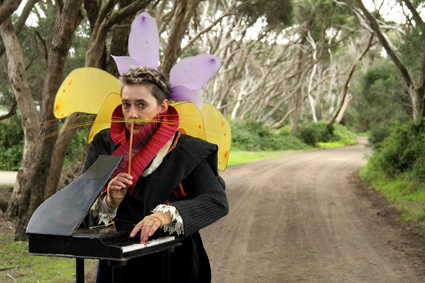
Margaret Cameron, Opera for a Small Mammal premiering at La Mama, Dec 2013
photo Daisy Noyes
Margaret Cameron, Opera for a Small Mammal premiering at La Mama, Dec 2013
A powerful and idiosyncratic writer and performer, Margaret Cameron is a key figure in Melbourne theatre. She has created riveting solo works—Things Calypso wanted to Say!, 1987; Knowledge and Melancholy, 1998; Bang! A critical fiction, 2001; The Mind’s a Marvellous Thing, 2002; and The Proscenium, 2005)—several of which toured for many years here and overseas.
Cameron has written and directed for Aphids (A Quarrelling Pair, 2004) and Chamber Made Opera (where she is resident director) as librettist and co-creator with David Young of the Minotaur Trilogy (2012). She has collaborated with American choreographer Deborah Hay, new media artist Hellen Sky (The Light Room, 2002, The Darker Edge of Night, 2008), acted as dramaturg for video artist David Rozetsky and in 2010 collaborated in Wales as writer on The Threat of Silence—a bilingual contemporary performance work with UK artist Jill Greenhalgh.
An August 1 press release from Chamber Made revealed that Cameron had been “rushed to hospital with cancer earlier this year. She [has been] undergoing a long program of precautionary chemotherapy.” Given a title as direct as Opera-therapea, RealTime approached Margaret Cameron to write about how she sees the relationship between art and therapy [Eds].
* * *
“EXTENDED, the lines of relationships intersect in the eternal You.”
Martin Buber
A new kind of opera with myself (‘the subject’), Deborah Kayser (soprano), Jane Refshauge (Alexander Technique teacher, dance movement therapist and dancer), Hellen Sky (choreographer and performer) and David Young (director), Opera-therapea will be staged in a consulting room in Fitzroy in October. Participating in different aspects of therapy, it explores the fact that Mind and Body are inseparable.
“I half wonder if my body is an opera,” says Deborah Kayser. “Through therapy we are releasing what we no longer need. We are reconnecting systems that have the potential to vibrate as one optimal body of wellness. It is our hope that those who experience this with us, may feel recognition of something they already know very deeply within them. I am expert in ignoring elemental truths and pushing them onto the back burner of my 21st century life.”
In a medical crisis, in shock and shattered by surgery, your wounded body seems no longer whole. But you know like and dislike. How grateful you are for this simplicity, for straightforward ‘likes’ and how clearly you know your ‘dislikes.’ Each is palpable to the animal in you. Communicating through the touch of breath, of sound, of skin, of silence, you are to discover that you are naturally likeable—a good animal. This comfort invites you to (re)join humanity with new understanding.
There are nurses, doctors, surgeons and specialists but there are other kinds of practitioners with a desire to share and accompany the subject with whom (in our humanity) we are one. Art comes through life and following experience, leads us toward community. “Our permeable skin is an organ between outside and inside, Self and Other and this sensational transmission operates and orchestrates thoughtfulness,” says Hellen Sky. A sick society cares not for the carer and as if the earth were a shopping mall, seeks acquisitions above all else.
How grateful you are for friends, for a knowledge sense without words, for those hands that touch, for the dimming of hard lights, the hushing of hard noise, the unhurried and natural presence of the few, who share, in the reciprocity of relation, a community of being. It is as if your soul, even in the sterile institution of hospital, were clean, humorous, fresh and bright. You are surprised and brought home—to company—like one baptised.
Austrian-born philosopher Martin Buber (1878-1965) is known for his “philosophy of dialogue,” a form of existentialism focused on ‘I and Thou’ and the ‘I and It’ relations (I and Thou, translator Walter Kaufmann, New York 1996). His philosophic works provide some leverage into ways of thinking about Opera-therapea and a cultural body in need of artful care:
“Spirit is not in the I but between I and You. It is not like the blood that circulates in you but like the air in which you breathe. Man lives in the spirit when he is able to respond to his You. He is able to do that when he enters into this relation with his whole being. It is solely by virtue of his power to relate that man is able to live in the spirit.”
Care is integral to healing. “The anthroposophic nurse begins from the premise that the spirit is always health and that an illness is not accidental, but the chance to develop the patient’s biography further” (www.aamaanthro.com/anthroposophic-medicine). Care includes spiritual, biographical and physical aspects for both the carer and the person cared for.
Jane Refshauge asks, “Can we find a universal medium and a new community of relationships that, beyond the limits of individual persons, reaches a liminal, oceanic place of transition through all the passages of life? All of one’s history and memory is encoded within one’s breath. Perhaps healing can only happen when we understand how life and death are actually the one energetic movement.”
In Opera-therapea practitioners of (an)other kind(ness) explore the felt sense of being human and how, through a midwifery of the soul, this links us to a place where life and death are connected. Complex relations of how we think, feel and act reveal holistic models and modes of co-presence that touch upon the boundaries of what we know. “Lying down on the floor in the therapy room, a light blanket resting over my body, I feel tender, vibrating tones penetrating my bones. Deep feeling comes from hot, song-filled air. I am carried by breath” (Tim Stitz, Creative Director, Chamber Made Opera, participant’s note).
Chamber Made Opera, Opera-therapea, Melbourne, 27 Oct, www.chambermadeopera.com
RealTime issue #117 Oct-Nov 2013 pg. 10
© Margaret Cameron; for permission to reproduce apply to realtime@realtimearts.net
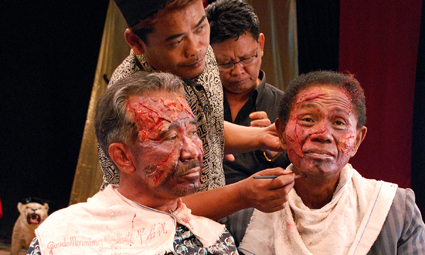
The Act of Killing
A line of dancing girls sashays from the mouth of a giant fish, the scene shot in such lurid tropical colours it appears poised on the edge of a nightmare. Welcome to the make-believe world of Indonesia’s death squads, built on the corpses of a million of their compatriots. Joshua Oppenheimer’s extraordinary new film The Act of Killing—“a documentary of the imagination”—renders this imaginary world on screen, as the killers who ushered in Indonesia’s “New Order” in 1965 enact their perspective on one of the largest massacres in history.
“I felt like I’d walked into Germany 40 years after the Holocaust only to find the Nazis still in power,” says Oppenheimer of his first encounter with one of the killers. “He immediately launched into horrific stories of murder, because killing was the basis of his career and the most important thing he had done in his life. And he told these stories in front of his granddaughter and wife. I thought in that moment, if this man’s not crazy, if this is how the killers really talk, then I knew I would have to give this situation whatever it took of my life to try and understand it.”
Oppenheimer’s commitment took him on a five-year journey that saw him interview more than 40 ageing death squad members. Their killings in 1965 were the culmination of simmering tensions between Indonesia’s Communist Party, the military and various religious groups in the first decade and a half of the young nation’s existence. Indonesia’s inaugural leader, President Sukarno, had attempted to balance these competing forces within a pluralistic political sphere, united by a commitment to Indonesia’s newly won independence and an anti-colonialist stance towards the rest of the region.
Sukarno’s balancing act came undone with the murder of six generals on 1 October 1965 in an abortive coup. Who instigated the coup remains unclear even today, but what’s not in doubt is that Suharto, one of the surviving generals, seized control of the situation and used the unrest as an excuse to launch a massive purge of communists, unionists, ethnic Chinese and anyone with leftist sympathies. When the dust settled, up to a million were dead, Sukarno had been toppled, Suharto was president, and Indonesia had unambiguously sided with the United States in the Cold War.
Oppenheimer’s interviews with various killers of the period led him to Anwar Congo, a petty criminal with a kindly face and a penchant for American gangster flicks. Anwar claims he personally tortured, bludgeoned and strangled around 1,000 people in the mid-1960s. “I lingered on Anwar because his pain was close to the surface, and offered insight into the true nature of the boasting about the killings—namely that it was defensive, it was a desperate effort to convince themselves that what they had done was right, and to intimidate the rest of society into accepting that story,” says the director.
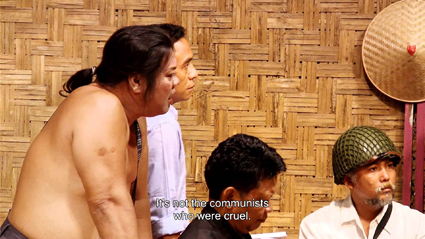
The Act of Killing
As Oppenheimer’s comment implies, The Act of Killing is as much about today’s Indonesia as the events of 40 years ago. For although we are told that Indonesia is now a democracy, Oppenheimer’s film clearly shows that the political terror, graft and gangsterism of Suharto’s “New Order” are alive and well. Throughout the film, we see interviews with present-day politicians in which they freely discuss their illegal moneymaking activities and reliance on the killers of 1965 to maintain their power. Throughout it all we constantly return to the over-lit interiors of Indonesia’s shopping malls, where the same elite figures indulge in the consumer dreams of the global capitalist system to which Suharto delivered their nation.
It was the intimate link between the terror of 1965, the contemporary political order and the lingering fears of Indonesian workers that led Oppenheimer to make The Act of Killing. “I first went there in 2001 to make a film about palm oil plantation workers,” he recalls. “The women were spraying a herbicide that was dissolving their livers. They really needed a union, but were afraid to organise because their parents and grandparents had been in a union until 1965, when they were accused of being communist sympathisers and dispatched by the army to civilian death squads.”
When his initial efforts to interview survivors of the 60s massacre were forestalled by the police and military, Oppenheimer decided to focus instead on the perpetrators. “Show me what you’ve done, in whatever way you wish” Oppenheimer told Anwar and his associates. “I’ll film the process, I’ll film your re-enactments, and we’ll combine these things to create a new form of documentary.”
Enthusiastically responding to this request, we see Anwar initially create scenes with an almost light-hearted feel, as he happily recounts the role he played in the purge. But beneath his bravado Anwar is clearly troubled, and when he tries to render the nightmares that keep him awake at night on film, The Act of Killing takes a turn that is at once laughably absurd and utterly horrific. By the time Anwar starts dissecting a teddy bear with a penknife to demonstrate what he did to the babies of communist suspects, we have descended into a very dark place indeed.
“It turned into a journey that was much bigger than genocide,” says Oppenheimer of the re-creation process. “It became a journey about how we as human beings make sense of our actions. How we understand ourselves.” He describes Anwar’s re-enactments as the killer’s attempt to “build up a kind of cinematic scar tissue,” to tame the unspeakable horror of what he did to his countrymen. And yet there is no escaping the agony Anwar inflicted, no matter what stories he uses to justify his actions.
In some of the film’s most disturbing sequences, Anwar’s fantasy world starts to unravel as he agrees to play a victim in one of his re-creations. Later, after watching the taped scenes, Anwar tells Oppenheimer that he now understands how his victims really felt. The director’s simple deconstruction of this claim—“but you were only acting, they were really dying”—leaves the killer standing naked, staring into Oppenheimer’s lens and the abyss of his own actions. For the first time, there are no stories left to hide behind.
For all the awfulness of these scenes, it’s The Act of Killing’s stripping bare of the act of history writing itself that remains the film’s most disturbing aspect. The purge of Indonesian communists has never been a secret—indeed, the manner in which these events have been framed has defined the country since 1965. The leftist political ‘other,’ Indonesia’s elites tell themselves, was a divisive force that had to be eliminated to guarantee Indonesia’s future prosperity and peaceful entry into the world economic system. It’s also this story that binds Indonesia’s elites to us in the West. For just as they have benefited from Indonesia’s prosperity, we have benefited from the submission of their workers.
Oppenheimer alludes to this point when I ask him if Herman, one of Anwar’s younger friends who acts in many of the re-created scenes, realised the extent of the slaughter upon which his society is based. The director replies, “Oh I think he realised, but he didn’t want to think about it. In the same way I realise that the shirt I’m now wearing was made in Bangladesh, and that the people who made it may now be buried under piles of rubble. Thanks to that, I can buy this shirt for six dollars. Like all of us, Herman uses fantasy and entertainment to withdraw from reality.”
After a loaded pause Oppenheimer adds, “That’s what this film is really about—how we all tell stories to escape from our most bitter and indigestible truths.”
–
The Act of Killing, director Joshua Oppenheimer, producer Signe Byrge Sørensen, Norway, Denmark, United Kingdom, 2012, distributed in Australia by Madman.
RealTime issue #117 Oct-Nov 2013 pg. 12
© Dan Edwards; for permission to reproduce apply to realtime@realtimearts.net
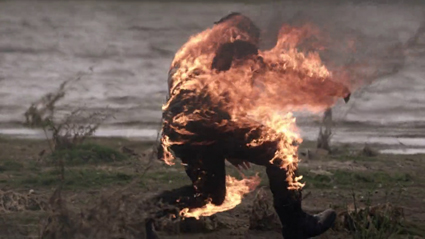
Death Race 3: Inferno
Saturation. Overload. Acceleration. Persistent 1960s concepts describing visual media as phenomenally excessive. Media sociologists and media artists for the past half-century chime in chorus how assaultive and bombastic visual media can be—debilitating for the former; liberating for the latter. Be it Jefferson Airplane’s Fillmore Ballroom lightshows or Ryoji Ikeda’s Armory Show installations, the human threshold is remarkably low for intaking sensory information. Audiences so quickly resort to registering sensorial, synaesthetic and immersive effects when presented with a few abstract flashes fired off in rapid succession.
When audio-visuality is championed for its radical potential, it has mostly been enabled by sound and/or music replicating these 60s concepts. Digital tools, processes and effects seem pre-designed to aurally simulate how visual perception grapples with abstraction, speed and density at this low threshold. While the high arts (through multi-media and audiovisual events commissioned by international arts festivals) spiral along these entropic lines, the low arts carve out a spiral equally inspired by saturation, overload and acceleration. Except the words more commonly employed are awesome, incredible, amazing.
Such are the terms audibly announced throughout Roel Reiqné’s Death Race 3: Inferno (2012, currently screening on cable TV). The central premise of Death Race 3 is how the races have now been targeted by a British media mogul for expansion. He has been buying out privatised prisons around the world to establish a global pay-for-view network for the franchising of the Death Race brand. The story centres on the first trial death race staged in Cape Town, South Africa. The action shifts equally between racing (myriad in-car and on-location camera-feeds) and the ‘behind the scenes’ operations within the broadcast studio. Additionally, the film ‘becomes’ the actual broadcast, showing what viewers see. Collectively, the franchise performs self-reflexively by increasing each film’s higher quotient of ‘sports commentary.’ This mode of oral narration signposts an audiovision unique to the generic mutation of sports and cinema.
Where Death Race 3 deviates from other models of ‘media overload’ is in how it audiovisually narrates this phenomenon, as opposed to thinking that it’s creating the phenomenon. Death Race is a fictionalisation of a live event, perversely extemporising and fragmenting the real-time dynamics of multi-camera/monitor spectacles so as to create a meta-fractured sensation of how such spectacles are produced. In a para-nouveau roman fashion, shots shift gratuitously from real-time to ultra-slomo, then into detonations of rapid fire cross-camera edits. The sensation is one of simultaneously being too slow and too fast, giving us a most prosaic interpretation of Deleuze and Guattari’s notions of cinematic time and motion. But it’s not simply the editing and camerawork conjoined which evidences this meta-fracturing: the fusion of voices, sound effects and score marks a shift from the 60s scopic-centric notions of saturation/overload/acceleration toward a coruscating and corrupting mode of audiovision. Let’s consider these soundtrack components individually.
First, dialogue. The bulk of dialogue in Death Race 3 is neither character-motivated nor character-directed: it’s responsive and self-uttered. Characters scream “awesome!”, “incredible!” and “amazing!” in fast edits framing their response to no one in particular. It’s a form of linguistic grunting, like the guttural growls and groans of televised wrestling. Even the stand-offs between racing drivers, the evil media mogul and his South African show producer become symbolic ‘power struggles’ dramatised like wrestling post-bout interviews. Most importantly, the edits are radiophonic, cut according to the vocal delivery. Unlike actual live commentary in televised spectacles, there is no fumbling, stuttering or inanely scripted homily. Here, the voice is a spurting machine-gun of banal yet explosive quips.
Next, sound. You’d have to be deaf to not acknowledge the role of sound effects in Death Race 3. A wonderful moment occurs during the opening Paramount Pictures logo with its chrome 3-D whooshing, wreath of gilded stars and Valhalla-like mountain crest. Over the last decade, this logo (similar to that of Warner Bros, 20th Century Fox and Universal) has been sono-musically re-designed like a cryptic overture to its film. Death Race 3 has a barrage of car noises (engine revving, hood slamming, chassis shuddering) skilfully timed to the logo’s movement. Semiotically, it declares the film is shaped by these sounds, sensations and events. Thus we enter a soundscape entirely located by the ear’s proximity to the noise orchestrated by a car engine. Monstrously customised engines. A bunch of them. A dizzying fatigue hovers at the perceptual threshold of the film, turning it into a numbing rumble of raging machines. It breaks the golden rule of sound design: ensure your listening audience is not ‘aurally fatigued’ by saturation, overload and acceleration. Perversely, Death Race 3 manifests an appropriately sonic equivalent of the effect so lacking in media arts’ attempts to ‘brutalise’ its listening audience.
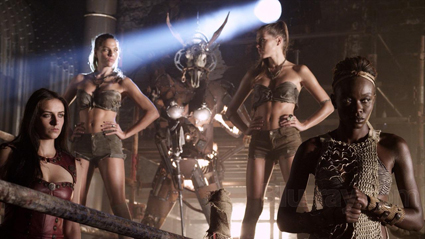
Death Race 3: Inferno
And finally, music. Death Race 3 has a score and song mix which is sublimely artless in its neurotic impulse to narrate dramatic change while flattening the very drama it seeks. Many of the songs are from Celldweller, a Detroit-based late 90s Industrial musician who progressively moved into electronic dance music—but like so many acts globally with similar CVs ends up producing purposely ‘hi-octane’ revved up music with noise affectations that has a detached ‘scorezak’ sense of narrating something without saying anything. It’s the kind of generic speed-fixated stock library music currently churned out by a billion bedroom composers providing fodder for fast-edited quasi-reality cable TV shows. Drum sample libraries, spritzy effects plug-ins, ornately pre-designed soft-synths and a real guitar put through ‘awesome’ FX boxes. It’s an amazing return to the original principles of “stimulus progression” which governed supply by the Muzak Corporation 60 years ago.
But for the last few decades, everything from rock and pop concerts to Olympics broadcasts to presidential elections to Broadway musicals to reality TV shows to viewer-voting talent shows have deployed an arsenal of broadcasting/recording devices intent on mirroring and replicating their own forms of media-encoding. The 60s notion of a NASA-style wall of monitors has become a banal de rigueur trope to insinuate that there is something momentous and monumental in the recording/broadcasting of the event that necessitates said arsenal. This constitutes the contemporary climate which self-serves media sociologists/artists who presume they are ‘reflecting society’ when they articulate/replicate this mode of self-actualising mediarisation. Death Race 3 bypasses this by rebooting Marshall McLuhan’s adage: it drives into the present while looking at itself in the rear-vision mirror. And like any good race, it goes nowhere really fast.
–
Death Race 3, BluRay/DVD, Director: Roel Reiné
RealTime issue #117 Oct-Nov 2013 pg. 13
© Philip Brophy; for permission to reproduce apply to realtime@realtimearts.net
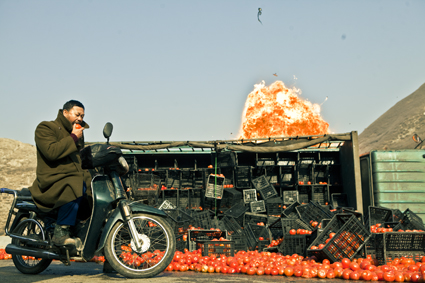
Jiang Wu, A Touch of Sin
© Xstream Pictures (Beijing)
Jiang Wu, A Touch of Sin
A Touch of Sin is absurd. Utterly absurd. Almost as absurd as the real-life Chinese events that inspired it. Adolescent prostitutes parade in titillating military uniforms, a middle-aged man shoots rich people to stop feeling bored and Communist cadres sell themselves state assets and buy Learjets with the proceeds. Underlying it all is a darkly surreal sensibility Buñuel would have been proud of. This episodic view of contemporary China from one of the nation’s most acclaimed auteurs may, at times, be grimly amusing, but it sure isn’t pretty.
“Over the past two years there has been an increasing number of violent incidents reported in China,” director Jia Zhangke explained during a recent visit to Australia to unveil his film at the Melbourne International Film Festival. “People are living under more and more pressure, but there are no proper channels through which they can solve their problems, so some people resort to violence.”
As he prepared a wuxia pian, or sword-fighting epic, set in ancient China, Jia watched the response to many of these violent contemporary events play out on Weibo (the Chinese equivalent of Twitter). Reflecting on the ancient and modern worlds, Jia began to see some resemblance between the online calls for a more just and humane society and the righteous characters of the wuxia films made by directors like King Hu (A Touch of Zen, Dragon Gate Inn) in the 1960s and 70s. It was this train of thought, he says, that led to A Touch of Sin, which subtly references King Hu’s work in several of its stories.
Whatever the film’s thematic links with ancient tales of swordsmen and women, A Touch of Sin unfolds in a country that has been utterly transformed by its headlong rush into modernity. Comparing these images with Jia’s earliest works of the late 1990s, the streets look richer and the people much better dressed. The half-finished highways we saw in films like Unknown Pleasures (2002) are now complete, facilitating movement across the country’s vast expanses as characters follow the flow of transnational money and all the pleasures and corruptions it has to offer. Everything looks so much newer than it did 20 years ago, yet the sheen is all surface deep, masking a culture that gets darker with each passing film.
“In the 15 years from my debut, Xiao Wu (1997), to A Touch of Sin, Chinese society has changed a lot,” agrees Jia. “On the one hand the country is full of limitations. The class system, for example, is very fixed. The child of a factory worker originally from the countryside is very likely to grow up to also be an internal migrant worker. On the other hand, superficially the country seems very free and full of vitality. For example, you can enjoy all kinds of sexual services in a place like Dongguan, as you see in the film. So society has lost its balance. The people with power and money have all the freedom, and even the law cannot bind them.”
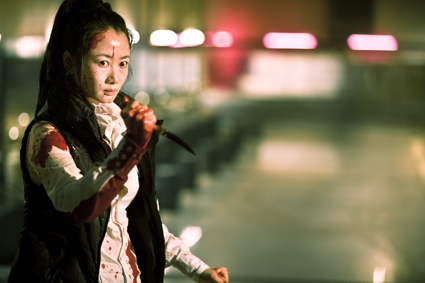
Zhao Tao, A Touch of Sin
© Xstream Pictures (Beijing)
Zhao Tao, A Touch of Sin
It’s this sense of lawlessness and a society out of control that makes A Touch of Sin such a harrowing experience. Jia has always been concerned with those lost in the slipstream of China’s breakneck speed development, but earlier characters like the pickpocket of his debut, Xiao Wu, were passive types, rendered torpid by the scale of the changes around them. In this sense, A Touch of Sin is a major change of direction. These men and women don’t just stare in incomprehension—they shoot, stab, steal and rob with abandon. Yet Jia’s new protagonists show no more understanding of the world around them than his earlier, more lovable losers like Xiao Wu. It’s as if having made the leap to action, Jia’s characters are determined to see every last urge to its conclusion, no matter how cruel or inane.
“I wanted to use cinema to talk about these violent events,” says Jia of his motivation for the uncharacteristic brutality. “Only when we understand and face violence can we avoid these things happening in daily life.”
For all its confrontational content, however, A Touch of Sin could do more to explore the roots of the discontent we see on screen. While we are made to viscerally feel the consequences of such an unbalanced society, several of the stories lack any serious attempt to explain the wider forces that have created these situations. Possibly this is the result of the central difficulty faced by every director working in China today. “In general there is a lot of space for the media to report on violent incidents,” Jia states. “So I felt that cinema should have the same kind of space. But the film system in China is very ‘special.’ I think the film should pass the censors, but on the other hand I don’t know how those people in the censorship bodies think.”
A Touch of Sin is slated for release in mainland China this November, but it remains to be seen if it experiences any last minute problems. It will also be fascinating to watch the local response. Several random attacks this year have made the film appear disturbingly prescient; the horrific story in August of a six-year-old boy having his eyes gouged out, allegedly by his aunt, makes even Jia’s explosive violence look comparatively tame.
Given the scale of the societal problems facing China, it is perhaps unsurprising A Touch of Sin offers no answers to the malaise it depicts. Like the experience of China itself, the film simultaneously conveys contradictory feelings of sensory overload, frantic activity, and the overwhelming sense of inertia that comes when events seem so out of control. In the end, Jia’s film simply leaves us reeling and, in the final few moments, gazing back into the lens to ask why.
A Touch of Sin; writer, director Jia Zhangke, producer Shozo Ichiyama, People’s Republic of China, 2013; 2013 Melbourne International Film Festival, 25 July-11 Aug
RealTime issue #117 Oct-Nov 2013 pg. 14
© Daniel Edwards; for permission to reproduce apply to realtime@realtimearts.net
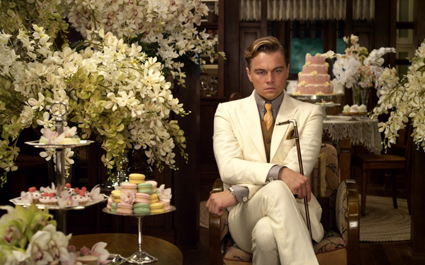
Leonardo DiCaprio, The Great Gatsby
It had been playing for weeks and I couldn’t put it off any longer. But with the wisdom of hindsight, seeing Baz Luhrmann’s The Great Gatsby was not a good idea. Many would say I should have known better. The critics had been scathing. Anthony Lane of The New Yorker suggested it was less a film than a music video made with “endless resources and a stunning absence of taste.” The respected fashion writer, Colin McDowell, condemned it: “as vacuous as the pages of most fashion magazines.”
But ever hopeful that Luhrmann and production designer Catherine Martin would repeat the visually thrilling experience of Romeo + Juliet (1996), I was willing to take my chances. Maybe my sanguine companion (a literary type) was anticipating an intelligent and nuanced adaptation of F Scott Fitzgerald’s delicate story of hope, loss and the fading American Dream. But not me. I was expecting spectacle—glitz and bling as someone else put it. I went for the costumes. I went for the fashion. The film has an excess of both. So why the disappointment?
Let’s start with the costumes. After an afternoon spent at the popular Hollywood Costume exhibition at ACMI, I didn’t need to be reminded that costume design involves the creativity and hard work of many talented individuals. In the complex process of getting a script to the screen, nothing is left to chance; everything matters. In this, The Great Gatsby is no exception, and if ACMI were to put all of the film’s spectacular costumes on show I have no doubt that they too would draw murmurs of admiration from the visiting crowds.
But if you’d read all the curator’s notes and watched all the interviews with the designers, actors and directors, you would know that the ACMI exhibition has one take-home message: the most important function of costume design is not to provide spectacle, but to transform the actor into a character we can believe in. In other words, what we are supposed to see up on the screen is not an actor dressed in a costume, but simply someone wearing clothes. If we buy this fiction, then the film can concentrate on the narrative and we can sit back and enjoy the story.
Of course, if the actor happens to be playing Elizabeth I, Marie-Antoinette or Daisy Buchanan, a certain degree of spectacle is required. But even costumes that dazzle can serve the narrative by revealing the psychological state of a character—the exterior shell of costume, if you like, is innermost feelings turned inside-out. Think for example, of those scenes where a character tries on numerous outfits in an attempt to find one that is ‘just right’—a Goldilocks-style trope that, often as not, combines fashion spectacle with a final choice that, in costume terms, is the perfect psychological ‘fit.’ When it comes to The Great Gatsby, Fitzgerald helps out by describing what his characters are wearing; the film cherry-picks these clues and then fills in the gaps.
So we get Carey Mulligan’s Daisy, America’s version of an aristocrat, wistful and romantic in pastel confections. At Gatsby’s party, wearing a Prada-designed stole that frames her delicate features in a lilac haze of fur, she is seductively vulnerable—but also trapped prey, an image that reinforces Gatsby’s vision of her as something rare and precious. Gatsby himself is appropriately obsessive about his appearance, everything is hand-finished, everything perfect. His fondness for ‘brands’ (“My man in England sends things over”), his compulsive expenditure (that extraordinary shirt scene), and his conspicuous display of wealth all betray a character that is clearly nouveau riche.
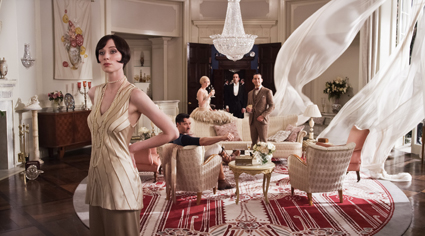
The Great Gatsby
I start to lose interest when it comes to the others. Jordan Baker—tall, athletic and “incurably dishonest”—probably makes sense as a fashion plate. Tom dressed as “the sporting hero.” Whatever. But tragic Myrtle, Tom’s low-rent mistress, dolled-up and overdrawn in reds and blacks? And Nick (conveniently played by Fitzgerald look-a-like, Tobey McGuire) in a cardigan and bow-tie? Surely there are rules against turning nuanced characters into cardboard cutouts.
The same broad brushstrokes are applied to the party scenes, those lavish spectacles that form the backdrop to much of the action. Fitzgerald coined the term “The Jazz Age” and Luhrmann’s film fills the screen with everything we have come to expect of the era, as well as adding a mass of pop culture clichés from our own. The effect is a mash-up of frenzied kineticism. “It’s not too much, is it?” asks Gatsby. Obligingly, Nick shakes his head.
But it is. I love this sort of stuff and want these scenes to work. Film is made for these moments and it’s not hard to imagine that Gatsby’s parties were designed to resemble a euphoric explosion from one of those cannon-sized bottles of Moët that keep turning up in the film. Every shimmying guest, kiss-curled dancer and spangled entertainer a gorgeous sparkling droplet, cascading across the screen in a glorious celebration of wealth, beauty and excess. Instead, the spinning dizziness is nauseating and all the intricate elements of design are lost, merging into one mass. A kaleidoscopic vomit of confetti, streamers and glitter.
Perhaps I wouldn’t have minded so much if Luhrmann had managed to make it all mean something, if he hadn’t made the mistake of confusing excess with decadence, if he hadn’t made it all look like such good, clean fun. Where are the consequences? Where are the torn dresses, the shredded hearts and the trainwrecked souls that are scattered throughout the novel? Colin McDowell is right to compare the film to a fashion magazine; youth, sex, money, image—like the glossy pages of Vogue, the film has it all. But he is right for the wrong reasons. Despite the collaboration with Prada and the commercial tie-ins with Tiffany’s, Brooks Brothers, Fogal and so on; despite costumes that could walk straight from the cineplex to the retail store, the problem with the presence of fashion in this film is not that there is too much, but that there is too little. Let me clarify.
What fashion can do, what fashion offers a film like The Great Gatsby, is an immediate entrée into a gilt-edged world. Not without reason, fashion has a reputation as obsessively preoccupied with surface and appearance; it is superficial, frivolous and fickle—all traits that play precisely into Fitzgerald’s depiction of hard, cut-glass characters, those “careless people” who casually abandon people and things. Instinctively, Luhrmann gets this. But whereas Fitzgerald knows the value of the shadow side of style to the telling of his tale, Luhrmann can’t help turning back towards the light.
Baz, it has been suggested, doesn’t ‘do’ darkness. Fashion is not so squeamish; the best fashion imagery understands that the flip side of glamour is death. In ignoring the dual nature of fashion, by keeping it one-dimensional, or at best as a cipher, Luhrmann misses the chance to corral his considerable talent for spectacle into a film that would have been worthy of Fitzgerald’s novel. If Luhrmann had got the costume, spectacle and fashion right, then perhaps he might have also got right Fitzgerald’s depiction of the Janus-faced coin of the American Dream. Where the author gives us a mirror, the filmmaker gives us… nothing.
RealTime issue #117 Oct-Nov 2013 pg. 15
© Karen de Perthuis; for permission to reproduce apply to realtime@realtimearts.net
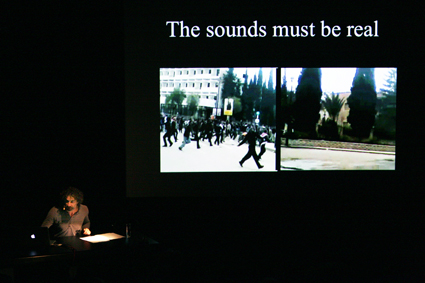
Rabih Mroué, The Pixelated Revolution
photo Judith Kaltenböck
Rabih Mroué, The Pixelated Revolution
One of the highlights of the Vienna Festwochen this year was Rabih Mroué’s The Pixelated Revolution, a highly engaging lecture/performance that focuses on how—and with what effects—mobile phones have been employed to document the Syrian revolution. The production (which was also displayed in a condensed form as an installation at Vienna’s Academy of the Arts) is a one-man show produced and performed by Mroué himself: a Lebanese artist, playwright and performer whose recent video/performance work explores themes pertaining to politics, violence and war.
The theme of the Festwochen this year was “Unrest of Form: Imagining the Political Subject.” The Pixelated Revolution reflects on the role that citizens and activists have played in capturing and distributing footage that unsettles the ‘reality’ of the conflict generated by governnment-sanctioned media sources in Syria. The lecture itself, however, is meandering and inquisitive rather than politically dogmatic in its structure. As the subtitle of the production, “A Non-Academic Lecture,” suggests, Mroué’s interest lies in stimulating thinking rather than pedagogically instructing the audience in how to read or understand the conflict at hand.
Seated at a table in front of a large screen, Mroué begins the lecture with the following statement: “The Syrian protestors are recording their own deaths.” This observation, we learn, is based on the large body of mobile phone footage that he downloaded from Facebook, samples of which (including footage of protests, soldiers, tanks and running feet) are projected behind him onscreen. When viewed together, Mroué argues that this digital archive constitutes a proclamation akin to the Dogme95 manifesto initiated by Danish filmmaker Lars von Trier which challenged filmmakers (through the imposition of a series of restrictions and constraints) to generate a realist aesthetic driven by protest.
Mimicking the “Vow of Chastity” coined by the Dogme95 group, Mroué lists a series of rules to be followed by those seeking to capture the reality of the Syrian conflict and to protect themselves and others from retribution: Shoot from behind and don’t show faces, but film faces when someone is being assaulted; don’t use tripods, don’t drop your phone and, above all, don’t credit the director.
The following section, titled “double shooting,” revolves around a disturbing piece of footage that was shot on the mobile phone of someone located on a balcony in a residential neighbourhood. Informed that guns are being fired by government forces even though there isn’t conflict taking place in the area, we view the movements of a sniper who appears, then disappears from our gaze. The phone scans the surrounding buildings in search of this blurry, ominous figure who suddenly comes into view and points his gun in the direction of the phone. The words “Eye contact” appear in red on screen, the image shifts as the phone/camera drops to the floor, and we hear a voice saying: “I’m wounded, I’m wounded, I’m wounded.’
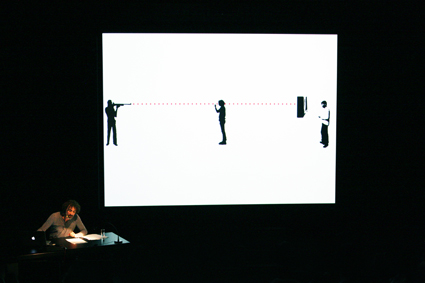
Rabih Mroué, The Pixelated Revolution
photo Judith Kaltenböck
Rabih Mroué, The Pixelated Revolution
“Optography,” Mroué informs us in a shift of direction, refers to a 19th century practice that focused on retrieving the last image viewed by someone before they died. According to the German physiologist Wilhelm Kühne, the final image could be extracted by developing the retina in a chemical solution. Mroué, however, employs a different process in an attempt to establish what may have been the last image of the mobile phone operator. He breaks down the footage and examines it frame by frame in an attempt to reveal the identity of the anonymous killer. The result is a close-up of a blurry, pixellated face circled in red but without any identifiable features: an image reminiscent of an abstract portrait of what Mroué describes as “the anonymous faces who murder for the Baath regime.”
Why, Mroué asks, doesn’t the mobile phone operator (and many others like him) sense the danger to his life and move or run? “Does the mobile phone camera desensitise him to the possibility of his own death?” And what kind of impact does this raw, shaky footage have on viewers who watch it online or as a part of the performance? Do these clips presented by Mroué work to undo the distant, anaesthetised spectatorial relationship cultivated by the polished nature of television news reports on the Syrian conflict? It is clear that, for Mroué, the significance of the footage (of protests, people and grassy landscapes captured by fallen phones) lies in the degree to which it challenges the stable, controlled image of reality generated by government-sanctioned media reports in Syria that render the “solidity of the state unquestionable.”
Rabih Mroué, The Pixellated Revolution: A Non-Academic Lecture, Mumok Kino, Museumsquartier, Vienna. 11, 12 May, Vienna Festwochen, 10 May-16 June. The work features as part of the Adelaide Film Festival at CACSA, 13 Sept-20 Oct
RealTime issue #117 Oct-Nov 2013 pg. 16
© Tara Forrest; for permission to reproduce apply to realtime@realtimearts.net
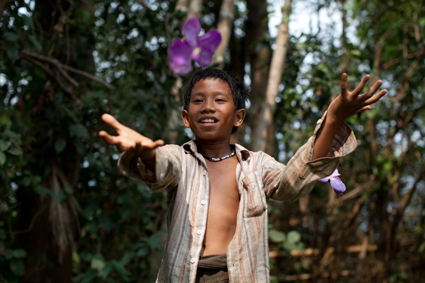
The Rocket
In 2007 director Kim Mordaunt and producer Sylvia Wilczynski released their documentary Bomb Harvest (see Dan Edwards’ review, RT80, p31). Shot in Laos, it followed Australian bomb disposal specialist Laith Stevens as he trained a local team in the business of tackling the devastating legacy of the United States’ indiscriminate, covert bombing of the country during the Vietnam War.
During the making of this documentary a sub-narrative emerged: that of the village children who make a dangerous living scavenging for bomb scrap metal to sell. These children, Mordaunt explains at a post-screening Q and A, would go on to inspire his and Wilczynski’s subsequent dramatic feature, The Rocket.
Lyrical and exquisitely observed, The Rocket is a story of cheek and determination in the face of dispossession and tragedy. Its resourceful yet accident-prone child hero, Ahlo (Sitthiphon Disamoe), forced with his family to move from their home in the mountains of Northern Laos to make way for a new dam, seeks to disprove the prevailing superstition that he is the bearer of bad luck by planning to build the largest and most explosive entry at an upcoming rocket festival. The narrative theme of the child embarking on what appears an overly ambitious quest to put things right is reassuring in its familiarity, yet Mordaunt employs it here to navigate a social and environmental situation of staggering complexity.
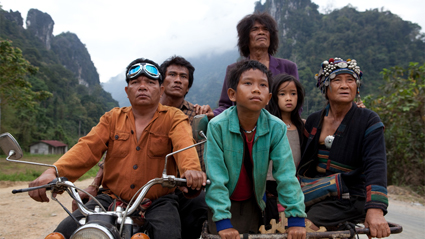
The Rocket
There are similarities between The Rocket and another Australian film released this year, Catriona McKenzie’s Satellite Boy. Both begin with eviction, charting a child’s journey through a landscape heavy with a sense of the numinous. However, while the landscape in Satellite Boy shelters the young protagonist, it is rife with danger in The Rocket—ready to maim or kill at any moment. Andrew Commis’ cinematography is instrumental in marrying the intimate playfulness of the child’s experience with the mysticism and peril of the landscape. Through vertiginous scenes—such as one where Ahlo is suspended on a rope swing above a mountainous drop, shrieking with laughter—and others which play with scale, pitting ant-like humans against majestic surroundings, Commis offers a window onto the sublime.
Commis’ vistas might stun the eye but do not dwarf the performances in this character-driven work. As they veer between joyful playfulness, stubbornness, anger and sadness, Sitthiphon Disamoe and his fellow child lead Loungnam Kaosainam (playing Ahlo’s friend Kia) convey extraordinary depth. The adult cast, most of whom have backgrounds in comedy and slapstick, were well-equipped—after an accelerated method acting course from Mordaunt—to walk the line between comedy and pathos the film required.
The world of The Rocket is one of great richness and complexity with an edge of the surreal, as embodied in the figure of Kia’s purple besuited, James Brown-impersonating alcoholic uncle (Thep Phongam). While Uncle Purple’s louche emergence strikes a humorously incongruous note, it has a darker significance. Purple is one of the CIA-backed Hmong who fought against the Lao during the country’s civil war (hence the adoption of American pop cultural references). There’s more than one reason he’s an outcast. The Rocket’s poetry is always underscored by disturbing truths.
In the breadth of its humanist vision, the film comes across as a somewhat troubled love letter to Laos from two Australian filmmakers who have lived and worked in the region (based mainly in Vietnam) and know it, perhaps, as well as any non-local can. While ‘outsiders’ telling another country’s story should always be regarded with caution, it’s surely a welcome development for Australian filmmakers to offer insight into the demanding circumstances of one of Australia’s near neighbours.
The Rocket, writer-director Kim Mordaunt, cinematography Andrew Commis, editor Nick Meyers, composer Caitlin Yeo, producer Sylvia Wilczynski; Curious Films, released 29 Aug
RealTime issue #117 Oct-Nov 2013 pg. 16
© Katerina Sakkas; for permission to reproduce apply to realtime@realtimearts.net
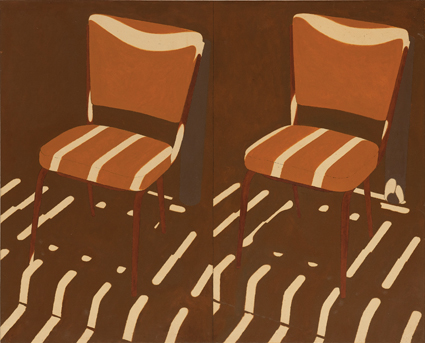
1994 same chair changed light situation, oil on canvas, Tony Woods: Archive
image courtesy the artist
1994 same chair changed light situation, oil on canvas, Tony Woods: Archive
“I rely on film and video to handle reality as my paintings become more abstract.” So says Melbourne artist Tony Woods, and as the new publication surveying his prodigious career, Tony Woods: Archive makes abundantly clear, the artist’s trajectory has indeed been a march from photorealistic figuration into increasing abstraction in paint, with a concomitant moving image practice concerned mostly with imaging “the real.” Only—perhaps typically of Woods’ mercurial style—this statement is also nimbly ambiguous.
The clue is in Woods’ use of the word “handle.” At first we may think of this in terms of its more neutral meaning, “to manage”—Woods uses the moving image, especially in later-life works, for its documentary affordances, to record daily reality. His is a warts-and-all pro-filmic aesthetic, unedited, replete with false starts, slow patches, jerky reframing: Catch as catch can. As Jake Wilson notes, in an especially lovely, perceptive essay in the book, Woods’ starting point is the home movie, and many of the films come across as simple sketches of the artist’s quotidian experience. From his second storey studio vantage point or through a hole in the back fence, Woods frames the passing parade of Fitzroy street life, human and animal, as a way of making sense of the world. This world is people, cats, bugs, flowers, sunbeams, rubbish, textures and patterns, in constant iteration. It’s not always attractive, nor is it meant to be: the alley behind the artist’s studio serves as an outdoor shooting gallery for the area’s notorious junkie population, and through Woods’ fence peephole, we witness their semi-secret abjection rites.
This wretched registry is one of many instances in which we are alerted that this is more than simple diarism at work. As we watch the films, the other meaning of Woods’ statement about using the moving image to “handle reality” begins to emerge. Co-opted into the slow-motion tragedy of street meat, or the futile spasms of a dying honeybee, we realise that this “handling” is manipulating, a sorting of the world around the artist into compositions, which, for all their apparent artlessness, are carefully constructed. This manipulation is obvious, and literal, in the suite of eye-catching films created with homemade kaleidoscopes and re-photography. However, it is just as evident in the street stories and everyday occurrences Woods captures, which disclose a much more deliberate artistic intelligence than the seemingly casual observations might at first suggest.
The chance to see these excerpts from Woods’ films, courtesy of the DVD inclusion, is one of the central joys of Tony Woods: Archive. The combination of these and the documentary, “work for the eyes to do,” provides us with a unique access to the artist’s thinking, significantly complementing the requisite biographical-interpretive essays and beautiful colour reproductions. The thoughtfully produced documentary makes the most of its high production values (great lighting, strong sound, adroit editing). It alternates interview footage of Woods with an array of other talking heads—his peers, art critics, dealers and other observers—and rich imagery of Woods’ works, spoken to by the subjects or the artist himself. Through this and the essay contributions (by Sheridan Palmer, Gary Willis, Lesley Chow, Alex Selenitsch, Phil Edwards and Jake Wilson) we learn about the artist’s early years in Tasmania (and how he still regards himself as Tasmanian, despite being seen by some as the “quintessential Melbourne painter”) and about his progression from early watercolour into acrylic techniques, his fateful New York trip at the height of Pop, return to Australia and immersion in the protean creative juices of the Yellow House. As we are inducted into the developments of the artist’s mature style, it is fascinating to learn about Woods’ parallel practices, not just in film and video but also in field recording, where the sense of the artist “handling” the world through documentation—this time sonic—surfaces again.
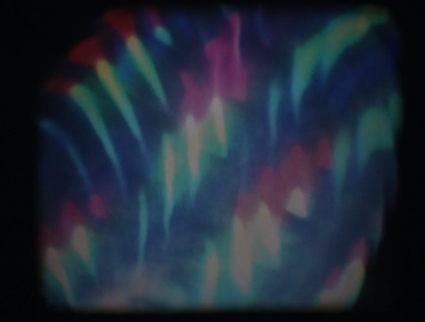
Reel Light, film, 1992, Tony Woods
Perhaps the greatest strength of the publication is the diversity of accounts and their presentation. We are drawn into this complex and talented artist’s world, given access to his creative inspiration and evolution, at a deeper level than other modes of artist biography that might sacrifice depth for gloss. Invited to muse on the aesthetic and conceptual relations between the artist’s practice across canvas, celluloid, pixels and audio tape, we start to develop insights into how the dialectic of representation and abstraction powers an artist like Tony Woods, finding varied expression across forms, materials and decades. There is here a play of opacity and porosity that rewards repeat readings and viewings. Tony Woods: Archive, with its detailed understanding of an artist whose work should be more widely known, is a rare and worthwhile addition to the annals of Australian art history.
Tony Woods: Archive, editor Andrew Gaynor, publisher artinfo.com.au, distributor Australian Scholarly Publishing (ASP)
RealTime has 1 copy of the Tony Woods: Archive to giveaway – click here for more info
RealTime issue #117 Oct-Nov 2013 pg. 17
© Danni Zuvela; for permission to reproduce apply to realtime@realtimearts.net
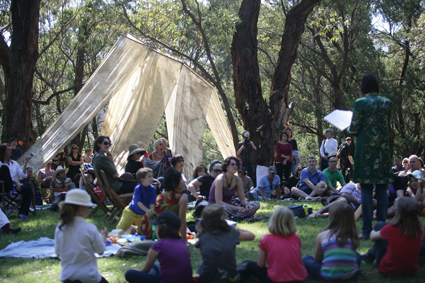
Picnic Among Friends, Victoria Spence
photo Mayu Kanamori
Picnic Among Friends, Victoria Spence
When I started to make performance, it was in the non-narrative, image-based culture of experimental practice where the emphasis was on the process of making the work as much as the performance itself.
As a maker and audience member, I most often watched the transitions between elements in the work as well as the ways performers made their entrances and exits. Watching them segue, be abrupt, juxtapose, overlap, collide or simply dovetail excited me most. It seemed to me that transitions did much to shape the meaning and affect of the work. It was the spaces, the liminal, still forming places, in between one thing and another, that held me and in which as a performer I felt most at home.
I’ve always been interested in storytelling and in intensity and the experience of authentic presence in real and performative spaces: in what produces the context and capacity for listening and speaking to others; in what has to be present for everyone to opt in, to move beyond the roles of performer and audience.
So when my practice moved beyond the frame of the arts, I was well equipped to pay attention to transitions and to other people’s stories. My Life Rites ceremonial practice honours and celebrates all the significant events of our lives with particular attention to how we complete them. And for those whose lives continue in the wake of the death of someone they love, it takes account of how we make meanings of that life in the processes and choices that we have in the experience of a dying, a death and in organising a funeral.
As a celebrant, I begin with time: initiating conversations about what happens after death, before a death has occurred. By taking more time at the deathbed it’s possible to support people in the transition from their role as carer to significant other (son, daughter, mother, lover). More time can be opened up between the death and the funeral, giving people valuable breathing space. You can expand the time taken within the civil funeral ceremony itself by offering a ‘double booking’ if you are working at a Crematorium. The usual 35-45 minute service that often feels formulaic, rushed and compressed, with the next booking lining up out the front, is the one experience most people know they don’t want.
I collaborate with families to create the context for the death and hence the role and function of the funeral ceremony. This gives the chosen elements more potency, activating them by drawing attention to the reason they are present. By allowing more breath in the experience for those who are still living to find their place and their own rhythm with spoken word, images and music, a deeply felt and meaningful experience is created and with real health outcomes.
These days I work in longer trajectories and time frames with even more moments of transition: at the time of diagnosis of a life-changing illness; at the transition between ‘active’ treatment and palliative care; to being able to have an after-death home vigil or, in the case of sudden and unexpected death, before the family calls a funeral director.
It is in these liminal spaces where another set of values can be articulated to re-frame or even create context and understanding of how to be at this time. To be able to modulate the quality of people’s experience when they are beset by shock and in a place of shared uncertainty has been for me an inherently creative process.
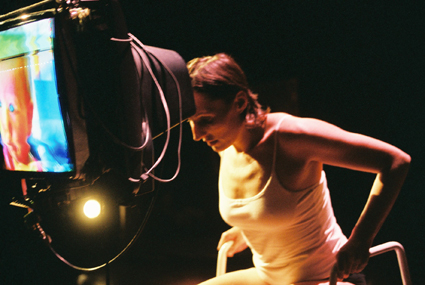
communication/failure (2005), Victoria Spence,
photo Heidrun Löhr
communication/failure (2005), Victoria Spence,
Over this last decade I re-trained initially as a civil celebrant, then as a bereavement counsellor and finally as a Death Literacy Consultant with a post-graduate qualification through a Social Work in Death, Dying and Palliative Care course at Sydney University. This move into the social sciences, into evidence-based paradigms has been interesting and necessary for me to fully understand the context in which I am now working. It has also been important for my colleagues to recognise my prior knowledge and information base that was founded in innovative, creative and humanities-based knowledge systems. On the floor in performance-making, living as an independent, freelance artist and multi-skilled collaborator, I was working among richly diverse cultures and communities.
I have clothed my practice, in part, in terms of the medical model and the funeral industry to make it recognisable to them and to foster meeting places for new collaborations and innovations. The uncertainties of the rehearsal room I now negotiate in hospital and living rooms at times of great duress, with concrete strategies, appropriate language and practices to support everyone involved. Walking into people’s lives at times of great loss and stress is profoundly improvisational—sensitising and connecting people back to the present moment in their bodies, through their breath and leading and following them in equal measure as they come to understand what meanings are resonant for them in the dying, after the death and through the funeral processes.
Exploring the relationship between beauty and the sacred within the everyday, in making new meanings and understandings of visceral, embodied experiences, such as the death of someone we love, is part of my reason for founding the Living with our Dead platform of site-specific ceremonial events. The Picnic Among Friends, now in its fourth year, invites people to bring their own idiosyncratic creativity and aesthetics to live with and remember their dead. Creating community memorials, individual assemblages made on picnic rugs, a ceremony and shared lunch in the park, surrounded by simple, tactile artworks, all foster a sense of participation and a telling of personal and shared stories. These narrative trajectories and links have a real function in the terrains of our significant life events.
The many aspects of my practice all rely on the ability to ground people in the experience they are having and to make from that the meanings they will need. I learned this in collaborative creative practice. I work always with a sense of the power of poetics, of personal and idiosyncratic aesthetics and personally authorised participatory making of meaning.
Before becoming a Life Rites Celebrant, Victoria Spence worked in various roles in contemporary performance, creating solo works and performing with Deborah Pollard, The Sydney Front, Sidetrack Performance Group, Legs on the Wall, DeQuincey/Lynch, Guillermo Gomez Pena & La Pocha Nostra and Blast Theory. Her curatorial and performance works include Performance Positive, works charting the impact of HIV and AIDS on communities (1996-97); Solstice Supper, installation performance events with Gay Bilson and Sydney chefs (1995, 1998); and Queer Cabaret events cLUB bENT, Love Child and Taboo Parlour (1996-99). An Asialink residency took her to the Darpana Academy, Ahmedabad, India and a Media Arts residency to Banff, Alberta, Canada in 2005. In 2010 she was a recipient of the Australia Council for the Arts’ Connections Residency, undertaking research in the Funeral Industry and establishing the Living with Our Dead platform. www.livingwithourdead.com
http://www.victoriaspencecelebrant.com
www.liferites.com.au.
RealTime issue #117 Oct-Nov 2013 pg. 8
© RealTime ; for permission to reproduce apply to realtime@realtimearts.net

Participants in the field with their bike loop antennas during the Haines & Hinterding Fields of Frequency workshop, Wired Lab, July 2011,
photo Sofie Muceniekas, Shoot at Everyone Imaging
Participants in the field with their bike loop antennas during the Haines & Hinterding Fields of Frequency workshop, Wired Lab, July 2011,
Situated on a property 30kms from Cootamundra in New South Wales’ Eastern Riverina District, Wired Lab is a space for interdisciplinary sound and art explorations. It’s also a functioning farm and familial home of the founder Sarah Last and her partner David Burraston.
Last was a member of the Wagga Space Program Collective, producer of the unsound festivals (2000-2006). She took over the reins in 2003, curating ambitious site-specific events such as Mutable Landscapes (2004), a residency program bringing national and local artists together to work on site-based artworks, and Locomotivus (2006), a performative train journey (a format Last has continued to explore). The Wired Lab can be seen as the logical extension of these activities. Last and Burraston met during Locomotivus; the year after he made the move to the country. Originally from the UK, Burraston is an artist, scientist and composer with extensive knowledge in generative systems and what he terms “creativity and complexity.”
On-site and wired up
Last started Wired Lab in 2008 with one of the inaugural ArtLab grants from the Australia Council. To bring a curatorial focus to the early projects the lab focused on the creation of long wire instruments pioneered by West Australian artist Alan Lamb, also involving guest artists such as David Burraston, Oren Ambarchi, Robin Fox and Garry Bradbury. Last explains, “the seed funding was oriented around the wire instruments and a desire to construct some of those and work with a team of artists to investigate them. That area of work was really connecting with what I’d already been doing in terms of landscape-scale practice and working outside of institutional constructs in the open field. While a lot of the early work was aligned around wire instruments, the project itself is broader than that, exploring old and new media and interdisciplinary experimentations…Essentially I want Wired Lab to be a platform of activity for contemporary art research and practice in a regional context. I’m also interested in exploring different models of operation for artist-run collectives.”
A particular focus of the Wired Lab is on skills and development. Across the year, it offers intensive masterclasses and workshops for both local and national artists in various areas of sound creation and arts production. Often these are led by visiting international artists undertaking residencies at the lab, such as renowned field recordists Chris Watson (UK), Jez Riley-French (UK) and Douglas Quinn (US). Last explains, “In terms of the artists we work with there’s got to be a reciprocal interest—and the conversation really goes from there. For skills development it’s about providing access to the best possible teachers that we can get. That’s not to say that those skill sets aren’t in Australia but it’s important to hear and learn from people who are working and practising in an international context. From a regional perspective, it has often historically been the case that we’d get pretty second rate programs offered to us. It’s been one of my long-term commitments to prove that from a regional basis you can provide access to and generate high quality activities.”

Sheep Muster, Southern Encounter, Wired Lab
photo Chris Herzfeld
Sheep Muster, Southern Encounter, Wired Lab
Off-site and on the rails
While Wired Lab offers an ongoing environment for site-specific explorations, Last is also interested in activities beyond their premises, particularly in other regional sites around the country. One of these projects was Southern Encounter, commissioned for Kumuwuki (Big Wave), the National Regional Arts Conference and Festival held in Goolwa, South Australia last year. (Southern Encounter recently won in the categories of Excellence in a Regional Area and Excellence in Experimental Music at the 2013 Art Music Awards.) Building on her earlier rail-based projects, Locomotivus (RT76) and Rolling Stock (2011, RT101), Southern Encounter involved a four-hour rail journey between Victor Harbor and Strathalbyn with six “happenings” along the way created by Tristan Louth-Robins, Luke Harrald, Matthew Timmis, Public Assembly (Lynda Roberts, Ceri Hann) with Jesse Cox and Eddie Roberts. (The project was then “storified” by Fee Plumley.)
Last and Burraston contributed two of these performances. In Sheep Muster, the train pulled up in a paddock so the audience could watch the sheep being herded, the sounds of which were captured via microphones around the paddock, mixed live and broadcast throughout the train. In the second performance, Piano Drag, Last and Burraston secured a piano to the back of the train and amplified its glorious demise. “We got a hell of a lot of feedback and white noise which was great…We had a video feed going through the carriages as well so people could watch that deterioration happen. It was distressing as well as enthralling. A number of the audience weren’t particularly enamoured with the feedback coming through the speakers but you’d be pretty worried about your work if everyone liked it. You need to have that tension and polarity in the experience.” The clamour of the piano’s disintegration contrasted with a performance by the Ngarrindjeri Rritjarukar Choir singing in language. It drew attention to their physical and sociological presence in the landscape and how that landscape has changed. This was also reflected in the course the rail journey took both through pristine bush, coastal developments and cultivated agricultural land.

Piano Drag, Southern Encounter, Wired Lab
photo Chris Herzfeld
Piano Drag, Southern Encounter, Wired Lab
Recording country
Focusing specifically on this interrelation of Indigenous peoples and the landscape is the Box Gum Grassy Woodlands Acoustic Ecology project, currently in early development. It will be a multi-year activity focusing on the local habitat native to the region around Wired Lab. While it’s an acoustic ecology field recording project, the Lab will also work with members of the Wiradjuri community, the Indigenous peoples of the area, assisting in their language rejuvenation programs. Last explains, “The thing that’s really important to any language or cultural rejuvenation is connecting it to land. So we’re currently in the process of developing a project that will ultimately have a number of creative outcomes. One will be the training of Indigenous people in audiovisual documentation, which is important in the preserving of histories. Other outcomes will be a website that will connect the oral language and country element with other creative outcomes like a touring exhibition imagining what a pre-colonial rendition of this landscape might have sounded like.”
Future connections
Five years in and Sarah Last is pleased with the way the Wired Lab activities have expanded and the directions in which it’s heading. In particular she’s interested in exploring and experimenting with connections between disciplines: “pushing creative practice into arenas where perhaps it’s not been fully developed or recognised by people, for example, working in science, environmental science, agriculture and linguistics.” This year Wired Lab received seed funding from Innovation Australia to be a regional hub for Science Week activities: “it seemed an ideal fit in terms of what we were already doing. What I really liked about this regional science hub element is that it’s very focused on the area that you live in, making science accessible and relevant to the everyday.”
The next major event will be the Wired Open Day in which the public is invited to take in the site and experience a range of activities and performances across an afternoon and evening along with the (G)local Frequencies Project still in development. After several of these events contending with wilful spring weather and the harvest season, Last has moved this activity to Autumn (May 2014). So stay tuned to the wires early next year to find out more about it.
Wired Lab, Cootamundra, NSW, http://wiredlab.org/
RealTime issue #117 Oct-Nov 2013 pg. 19
© Gail Priest; for permission to reproduce apply to realtime@realtimearts.net
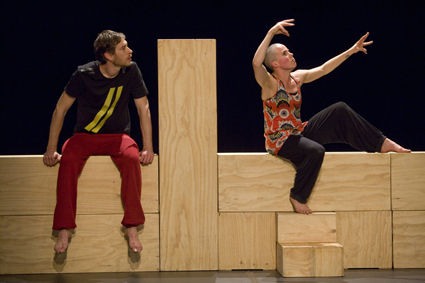
Lee Serle, Kirstie McCracken, Double Think, Force Majeure
photo Ponch Hawkes
Lee Serle, Kirstie McCracken, Double Think, Force Majeure
There are three star performers in Double Think (the major work in a double bill with the short work Gogglebox): Kirstie McCracken, Lee Serle and Ben Cobham/Bluebottle’s gorgeously golden wooden sculpture that dances as surely as the dancers do. Glowing with the grains and patterns of timber tissue, this tetrus wall will support, sway, hold and heave as it becomes frame, surface, screen, seat, bed, pedestal and presence.
Perhaps there is a fourth star: the lighting which dulls, darts, smashes and gleams its way through and across this performance, establishing atmospheres and episodes as clearly as the shape of the wall and the tone of the choreography.
The opening sequence is an assault. Sharp lights, sometimes controlled by the performers, are aimed directly at me, flashing on and off to a noisy, rhythmic grind, leaving smears and traces across my retinas, as snaps of the dismantling wall leave me grieving for its unity. The virtual traces of burnt light create shapes floating in the dense black nothingness where I know there is something; white to black, dark to light, something to nothing, full to empty, seen and unseen.
After the final snap, the light bleeds into a dully lit McCracken solo while Serle, thankfully, re-assembles the wall. This solo is full of paddled hands and lengthened arms atop turned out hips generating circular changes in direction on legs that bend and straighten, travelling and propping. A contemporary dance solo.
But the next dance makes the dance of the wall simply surprising. Blocks smoothly protrude and recede, blocking light, contorting geometrics and making shadows that swing back and forth darkly across the wooden skin. This relation of ephemerality and solidity embodies choreographer Byron Perry’s central notion of the “illusion of opposition.” Two apparently antithetical states or substances exist not in actual opposition but in the continuum of flux. While Perry’s program notes focus on the “imperfect sense” of a tall man (Serle) and a relatively short woman (McCracken) dueting, it is also found in the very substance of the timber tetrus: solid yet flexible, impenetrable and open, coherent and devolving, reflective and dense, dead and alive.
After the wall stops dancing, the tall man and the short woman emerge through gaps, like cockroaches. In a sequence where only the upper bodies are visible, lovely little rhythmic phrases disappear in the onward thrust of choreography that rushes toward crescendo. Quirky, intricate, slippery unison that slips into canon is broken by one luscious moment where she strokes the wood, the contact of two skins. At this moment the choreography hushes in a brief adoration. They scuttle back into darkness.
Later, the dancers are dimly framed by the re-arranged wall, separated but the same. They have become distant dreams in individual pools of soft light that fades them into oblivion, only to bring them back again in a slow, imperceptible sweep. Their quickly moving flesh becomes swipes of action in near-blackness, almost unreal, yet heightening their aliveness through the silky texture of skin. Created at a distance these dancers become chimeras, ghosts, cartoons, virtual realities, fading photographs and dying swans.
Force Majeure, Gogglebox and Double Think, director, choreographer Byron Perry, performers Kirstie McCracken, Lee Serle, set construction Ben Cobham/Bluebottle, lighting Benjamin Cisterne, sound composition Luke Smiles, costumes Natasha Fagg; The Reginald, Seymour Centre, Sydney, 21-24 Aug
RealTime issue #117 Oct-Nov 2013 pg. 20
© Pauline Manley; for permission to reproduce apply to realtime@realtimearts.net
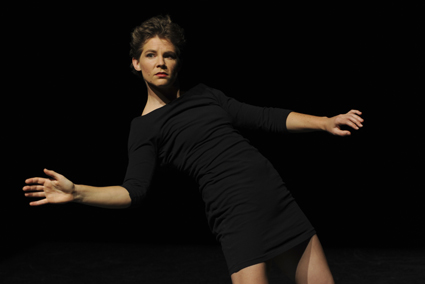
Miranda Wheen, Quest from Little Black Dress Suite
photo Heidrun Löhr
Miranda Wheen, Quest from Little Black Dress Suite
This suite of dances takes the little black dress as its unifying concept and further asks the question “what happens when you remove an iconic piece of clothing widely associated with feminine elegance and cocktail party glamour from its familiar fashion context?” (program). Running with the choreographer’s premise, I wondered how as an audience we might assess the performance on those terms?
T-dress, V-dress, vintage bandeau, slimline, full-skirted, reverse wrap, Audrey style, whatever, I know that the trick with the LBD is simply to wear it well. Here Martin del Amo is the tailor and each of the dancers adds her/his own personality to the outfit to bring off the elegant display.
In QUEST, Miranda Wheen’s boat-necked, scoop-backed, stretchy number suggests nakedness beneath. The dress slips in response to her movement and we note the changing ratio of cloth to skin. As she moves outside the light, the space she’s tentatively exploring envelops her in its own dark materials. Wheen’s dance is all weight shifts and balances as she slowly negotiates a path at first vertical, then horizontal. With the body at full stretch, the fabric moves as the dancer tests her limbs. Working in tandem with Alex Pozniak’s edgy score, her initial expression of someone driven also suggests a struggle with the elements. Only momentarily ungainly without her shoes, Wheen remains able-bodied, the garment largely compliant. Only when she returns to the place she began, equilibrium restored, do we notice the trickle of sweat running down the back of her dress.
Martin del Amo in What Good Is Sitting Alone In Your Room chooses for himself a no fuss, short, sleeveless black shirt-waist and soft lace-up boots. He’s simply dressed for action confidently expressed in the form of smoothly articulated arms, legs, hips, spins and Bob Fosse-style poses sideways and front-on. Who needs black hats and high kicks? His appearance is showy enough with no evidence of sweat to dispel the stylish impression. Gail Priest’s chiming minimalism from her album Presentiments from the Spider Garden weaves its own spell here.
In Tomorrow never comes Kristina Chan, elegant in a sleeveless A-line shift, black pumps, earrings, nails polished pink, might be exploring the same abstract territory as Miranda Wheen but within a much tighter frame. Again, arms reach outwards and balance on air. Not a hair out of place, her body appears to float, leaning close to off-balance until once more regaining its perfect poise while the sublime voice of Kiri Te Kanawa soars in unison.
In A Certain Slant of Light, Sue Healey in dramatic cowl neckline, patterned stockings, serious boots and with Arvo Part for company, feels her way through the space, breaking into sweeping moves and turns, deft spins and enclosing gestures. Like each of the dancers, Healey expresses a high level of concentration—there’s a sense that every move is being internally analysed as it’s being executed, an element of showing and simultaneously meditating on the movement.
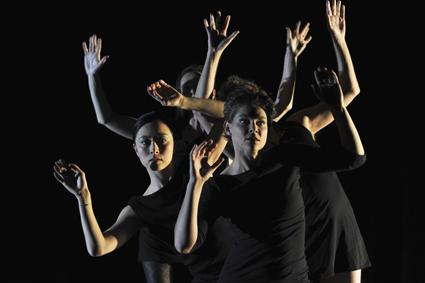
Little Black Dress Suite
photo Heidrun Löhr
Little Black Dress Suite
Finally all four dancers join in a careful pattern of slow, weaving movements in and around each other in a narrow horizontal plane to the aptly haunting song “Like An Angel Passing Through My Room.” In the end, like the iconic dress, it’s all about line and grace and these dancers, each in their own idiosyncratic way, appear to have that sewn up, carrying off the choreographer’s premise with aplomb.
FORM Dance Projects and Riverside: Little Black Dress Suite, choreographer-director Martin del Amo, performers Miranda Wheen, Kristina Chan, Sue Healey, Martin del Amo; Lennox Theatre, Riverside Theatres, Parramatta, 15-17 August, 2013
See our also our In Profile feature on Miranda Wheen
RealTime issue #117 Oct-Nov 2013 pg. 20
© Virginia Baxter; for permission to reproduce apply to realtime@realtimearts.net
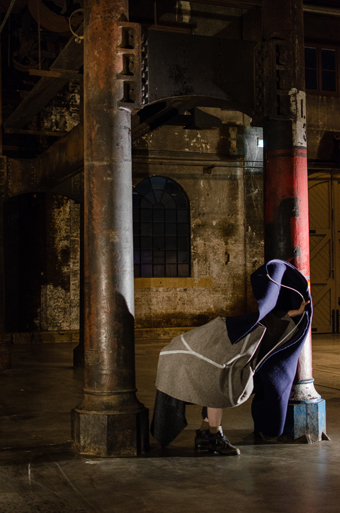
Box of Birds, De Quincey Co
photo Lucy Parakhina
Box of Birds, De Quincey Co
Across 30 years Performance Space has mutated in the hands of visionary artistic directors, each with their own agenda, but each sustaining commitment to the “obdurately ephemeral,” as an early manifesto put it, to providing a home for innovative performance and visual arts and their hybrids.
Leafing through the pages of RealTime from 1994, our first year, Performance Space’s history seems too vast to contemplate. It had already been operating since 1980 and Virginia Baxter and I had been performing there as Open City since 1987. What Performance Space offered beyond its vision was an enduring sense of community and continuity embodied in special events, conferences, workshops and parties (not least the celebrations for exiting artistic directors). In this community individuals collaborated on projects and some moved productively between performance companies associated with Performance Space or beyond, to Sidetrack Performance Group, Stalker, Marrugeku and others.
The standout shows across the years were often big works: Angharad Wynne-Jones’ unforgettable action-packed yet contemplative Sydney Harbour event Hydrofictions; Performance Space conferences with international guests, not least the one focused on food, Progressive Dinner; visiting artists Guillermo Gomez Pena and Robert Pacitti’s creations of large-scale works in collaboration with local performers; the queer-driven, sometimes hilariously shocking cLUB bENT (anus-baring dance; urine-spraying trapeze work); the Antistatic festivals pushing at the boundaries of dance; LiveWorks’ early embrace of the burgeoning Live Art scene; and Tess de Quincey’s and Joey van Ruigrok’s transformations of Carriageworks’ vast interiors. Or big in a different way—Nigel Kellaway’s This Most Wicked Body, a 240-hour durational work at the old Cleveland Street Performance Space with restaurateur Gay Bilson feeding Kellaway and one audience member a night with a fine meal.
Each year has had a host of works of small to medium scale representative of and vital to the Performance Space ethos: performances, creations and curations by many individuals—Deborah Pollard, Barbara Campbell, Derek Kreckler, Penny Thwaite, Julie Anne Long, Rakini Devi, Kate Champion, Victoria Spence, Nikki Heywood, Julianne Pierce, Denis Beaubois, Tess De Quincey, Rosalind Crisp, Alan Schacher (Gravity Research Institute), Vicki Van Hout, Jeff Stein and many more. Then there have been several generations of performance groups: All Out Ensemble, One Extra, The Sydney Front, Russell Dumas’ Dance Exchange, Entr’Acte, Open City, Frumpus, Legs on the Wall, Gravity Feed, Post Arrivalists, De Quincey Co, version 1.0, Branch Nebula, The Fondue Set, My Darling Patricia, Matt Prest & Clare Britton and Team MESS. There was also a wealth of visiting artists, including among many others, Nico Lathouris, Margaret Cameron, Jenny Kemp and Canberra’s Splinters Theatre of Spectacle. Performance Space has also been a key player in the national hybrid arts laboratories Time_Place_Space and Indigilab, which has become Indigispace, yielding productions from Aboriginal artists in 2014, at a time when PS will have its own Indigenous producer.
When I meet them, Bec Dean and Jeff Khan, current directors of Performance Space, are in a state of high excitement—great bundles of the printed program for the organisation’s 30th birthday, You’re History, to be celebrated in November, fill their admin office in Carriageworks, where the company resides as a major tenant. We slip into the bulging archive room to talk about the pair’s inheritance of Performance Space tradition and as shapers of its future.
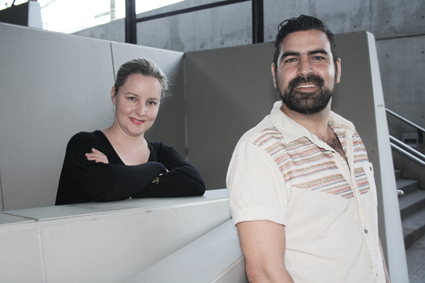
Bec Dean, Jeff Khan
photo Nic Dorward
Bec Dean, Jeff Khan
Legacy
Dean points out that both she and Khan had come from Perth, “which had a strong connection with Performance Space through Alan Vizents [initiator of Media Space in Perth] who subsequently became the director of Performance Space. I became aware of his practice through Sarah Miller who came from running Performance Space 1989-93 to be director of PICA in 1993.” Both worked at PICA, Dean as a curator and Khan at the front desk. “Through Sarah, Jeff and I had an arm’s length understanding of Performance Space.” Khan moved to Melbourne, becoming artistic director of two very successful Next Wave festivals, 2008 and 2010. He recalls, “the evidence of the national reach of Performance Space was clear. As soon as I started at Next Wave we had a big focus on site-specific and interdisciplinary work and in non-traditional venues, so Performance Space was an obvious partner in Fiona Winning’s time as director (1999-2008).” Dean became a curator at the Australian Centre for Photography in Sydney, “hung out at PS as a punter,” and was then employed by Fiona Winning as Associate Director at Performance Space and continued to work with the subsequent director Daniel Brine (2008-2011) in whose time Jeff Khan was to program performance.
Continuity & community
I ask the two how palpable is a sense of continuity with the Performance Space of the 80s and 90s. “There are artists from that time who are still associated with the space,” says Dean, “although the relationship might be different, while the field has diversified and a lot of new artists have come into the frame.” Both feel that there is a persistent sense that “the community is still strongly around us. They also point to intergenerational connections forged by Clare Grant [ex-Sydney Front] at UNSW and Sarah Miller and Chris Ryan [ex-Sydney Front; version 1.0] at the University of Wollongong from which Team MESS and Appelspiel have emerged.
Rosalind Crisp, Tess de Quincey and Nigel Kellaway, who feature prominently in the 30th birthday celebrations, have performed at Performance Space across two to three decades. From 1987 to 1994 Kellaway was with The Sydney Front and in 1997 formed The opera Project. De Quincey worked with Stuart Lynch in the 90s before moving on to solo performances and the formation of De Quincey Co. Rosalind Crisp’s early works were premiered at Performance Space where she also initiated the Antistatic dance event and later relocated to France to successfully develop her d a n s e methodology, still appearing from time to time at Performance Space ever since. These artists are exemplars (among many others) of a commitment to craft and exploration identified with Performance Space.
Performance Space seasons have led, says Dean, to a closer relationship between artists and a much larger audience than the old Performance Space had. The seasons have become intensive mini-festivals with a great sense of occasion, each with a broad thematic focus and much discussion enabled by Daniel Brine’s addition of the Club House concept to programming. Dean says that the interdisciplinarity of Performance Space and the seasons allows “conversations between performers and visual artists to happen within one frame.” “Audiences cross over too, which nuances the program,” adds Khan.
Commitment
I ask Dean and Khan what drives their directorship. Dean refers to Performance Space founder Mike Mullins’ (1980-85, see RT95, p38) focus on “new forms and new ways, and a commitment to looking outside the frames of reference that you know. We totally take this forward into the future.” Khan agrees: “It’s been Performance Space’s great strength across 30 years and it gives us a very clear vision as to what it can be in the future—that it’s a process that’s led by artists.” Under their own directorship, says Khan, “that means we’ve been focusing a lot of our programming energy on site-specific work and the dramatic increase in the number of artists wanting to work in that context. Nationally there isn’t another institution that champions that kind of work on an ongoing basis.”
As well, Dean feels that Performance Space “has continued to be socially aware and politically engaged although it might not be as forthright as it was when Mike started because he had to fight to establish Performance Space.” However, as well as mounting the highly successful SEXES program this year, in 2012 it reaffirmed its long-term commitment to queer practice by activating the Stephen Cummings Bequest as a residency-mentorship program for performance practitioners. Khan notes that as part of the birthday celebrations, choreographer and dancer Dean Walsh “will be looking back at the transformation he experienced as a performer in cLUB bENT, through queer language and drawing parallels with his current investigation which is all about marine life.”
An embodying birthday
What, I ask, are you celebrating above all? Dean says, “We want people to feel they embody Performance Space. It’s a celebration of us that is also of them.” Khan says, “We’re looking to the next 30 years so we want to emphasise that ours is a living history. People from the 80s and 90s are still our colleagues. This is not a dusty archive.”
The ambitious birthday program has an impressive line-up of talent that reaches across the space’s 30 years including The Directors’ Cuts, presentations (a night each) by the former Performance Space directors plus one for the late Alan Vizents (with Barbara Campbell, Derek Kreckler, Annette Tessoriero and Amanda Stewart presenting the late artist’s performance texts) and a screening of footage of Post Arrivalists’ infamous 1994 work Lock Up. 30 Ways with Time and Space features free performance scattered through Carriageworks and the 12 days of You’re History has performances from Paul Capsis, Apelspiel, Vicki Van Hout, Mike Parr, Jon Rose & Lucas Abela, Rakini Devi, Aunty Rhoda Dixon Grovenor & Nadeena Dixon, Lauren Brincat & Bree Van Reyk, and Matt Prest & Clare Britton.
Brown Council will present their ongoing tribute to a mythical Australian feminist performance artist “who disappeared in 1981.” Alex White and Emma Ramsay will celebrate the passing of analog television broadcasting, featuring a large cast of artists including Lara Thoms, Joel Stern, Pia van Gelder and Wrong Solo (Agatha Gothe-Snape & Brian Fuata). The opera Project’s Brief Synopsis is a creation by Nigel Kellaway, Heidrun Löhr and Katia Molino—“sumptuous music with the cool allure of France’s filmic Nouvelle Vague.” De Quincey Co’s Box of Birds, taking audiences deep into Carriageworks, will doubtless reconfigure our sense of the building. Rosalind Crisp’s danse (3)—sans spectacle, performed with European associates Celine Debyser and Max Fossati, will refuse to be categorised in its unpredictable unfolding.
There’ll be much reflection on Performance Space’s past over the 12 days of You’re History, but true to the organisation’s vision, the works are all new, sitting side by side with the memories that will be lovingly and deservedly conjured by some of the Director’s Cuts, although Nick Tsoutas (1984-86) promises not “a night of memories, but a night to remember,” Angharad Wynne-Jones (1994-97) will create A Parliament of Animals “realigning ourselves to our planet and ecosystem” and Daniel Brine will present 30 one-minute clips of artists in a toast to the next 30 years.
The ironic titling of the 30th birthday celebration as “You’re History” is therefore apt. Collectively, as artists and audiences, we constitute a living Performance Space archive; but if we only live out its past, the art it nurtures will truly be history.
Performance Space, 30th Birthday, You’re History, Carriageworks, Sydney 20 Nov-1 Dec; http://www.performancespace.com.au/
RealTime issue #117 Oct-Nov 2013 pg. 24-26
© Keith Gallasch; for permission to reproduce apply to realtime@realtimearts.net
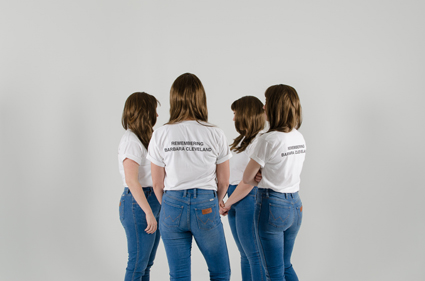
This is Barbara Cleveland, Brown Council
photo Lucy Parakhina
This is Barbara Cleveland, Brown Council
When there’s heavy lifting to be done in the area of female empowerment, Brown Council are the go-to girls. Their work is multi-dimensional taking in everything from explorations in contemporary performance via video art to joke marathons.
As part of Performance Space’s Halls for Hire project last year, Brown Council celebrated the 90-year history of the Country Women’s Association by taking up the self-imposed challenge over four sleepless days of baking all 137 cakes from the CWA’s Jam Drops and Marble Cake recipe book. This is the dedication they now bring to bear on the task of reinstating a potentially forgotten female artist to her place in history. I caught up with the team in the midst of their four-month long international pilgrimage researching the life of the mysterious Barbara Cleveland “travelling to the cities where she lived and worked, exhuming her memory in an attempt to reinsert her into the history of performance art history.”
I came to Sydney in 1986 and missed Barbara Cleveland altogether. What sort of performance works did she create and what has attracted Brown Council to them?
Cleveland was one of the first Australian artists to integrate performance art practice and feminist thought. She was a hugely influential, mythological figure working from the mid-late 1970s up until her death in 1981. However what’s interesting is that there is no documentation of her performances in photographic or video form and almost nothing written about her. ?
Performance art, like many other conceptual practices of the 1960s and 1970s, developed within a particular socio-historic context that stressed, among other things, the ‘dematerialisation’ of the art object, so performances often weren’t documented in order to reflect this critique. ?We wondered whether this was due to the nature of the work—because performance is an ephemeral act which has historically resisted documentation or because of the lack of institutional interest in women’s work. ?So the fact that she was anti-documentation means she has been largely left out of the ‘canon’ of performance art in Australia?. She became important to us as an early example of feminist thought in Australian culture and creative practice, almost as a test case as to how that’s been remembered or not remembered.
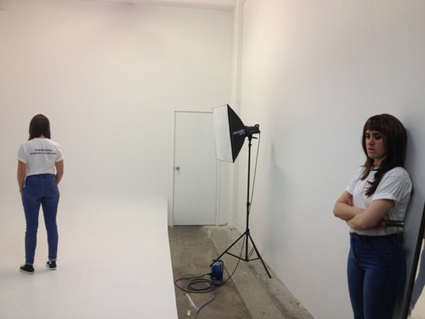
This is Barbara Cleveland, Brown Council
photo Lucy Parakhina
This is Barbara Cleveland, Brown Council
You’ll be re-performing some of Barbara’s lectures as part of the Performance Space celebrations. Are they straight lectures or do they fit more into the lecture-performance format so popular in the 1980s that unleashed the creative talents of so many academics?
Cleveland’s performance lectures and instructional performances were discovered in an archive box in mid-2011, which is how we found out about her. The performance lectures focus on how we experience and understand time, memory and history and their relationship to the experience of performance. We couldn’t tell if they’d ever been performed or if they were just text based instructional performances. This is, of course, a problem as well—without documentation the work and the artist are forgotten and left out of the history books—like Cleveland.
Barbara Cleveland’s text raises so many of the key issues surrounding performance art now and whether it can be understood after the event through subsequent documentation and whether it can be reinterpreted, re-enacted or re-performed. It was really the discovery of these lectures and performances that spurred on the entire Barbara Cleveland project and the desire to insert her work and memory back into history. As Brown Council we re-perform these performance lectures to camera as a way of documenting her work and memorialising her words and so in effect we all become Barbara Cleveland.
Though I can’t find anything about Barbara in any of the important publications on performance art at the time you say her work outside Australia was also seminal. Where has retracing her steps taken you?
Like many Australian artists, Barbara Cleveland traveled overseas in the 1970s to engage with the European and American scenes. At present we are interested in her time spent in the UK and in particular the galleries and spaces where she performed in London, such as Gallery House, Whitechapel and ICA. Her performances throughout this time were not documented so little is known about the work she undertook. Retracing Barbara’s steps has led us to London, the Forest Fringe in Edinburgh and The Junction in Cambridge where we have been developing gestures of remembrance to her. One of these has been handing out T-shirts with the statement “REMEMBERING BARBARA CLEVELAND” printed on the back. The T-shirts enable people to enact their own form of remembrance and spread the name of Barbara Cleveland.
Performance Space, You’re History: Brown Council, This is Barbara Cleveland, Bay 19, Carriageworks, Sydney, 20 Nov-1 Dec, 10am-9pm
RealTime issue #117 Oct-Nov 2013 pg. 26
© Virginia Baxter; for permission to reproduce apply to realtime@realtimearts.net
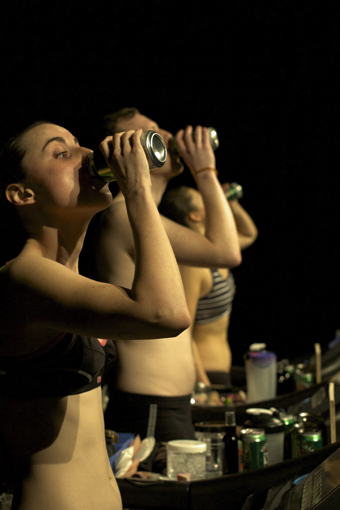
Run Girl Run, Grit Theatre
courtesy the artists
Run Girl Run, Grit Theatre
Live art has by now established itself in Australia, if not firmly, then at least recognisably. While it’s a loose mode that draws on a wide range of formal influences, one of the most compelling pieces of evidence of its growing importance lies in the way those influences and forms themselves are finding inspiration in return. Two recent works to appear in Melbourne offer testimony—both clearly acts of theatre, with scripts, dialogue, actors, yet somehow equally situated within the frame of live art. Each renders the division of style and content impossible, and in a sense neither exists outside of the performative moment itself.
The Confidence Man
Side Pony Production’s The Confidence Man is both text-based theatre and its opposite. There’s a story: a familiar crime caper in which the domestic ennui of a middle-class family is intruded upon by an only partly welcome face from the past, who is soon followed by a pair of violent, gun-toting crims hunting a lost bag of cash. There’s double-crossing and drug snorting and death dealing, all adding up to a suburban Australian thriller with some genuinely well-written moments.
But this isn’t the Confidence Man as experienced by its audience. Upon arrival, six willing members of the crowd are suited up in freakishly large puppet heads equipped with internal audio feed. The playing space is an expansive, deconstructed home and nearby park with white taped floors to indicate walls and barriers. Each actor/audience member plays out the actions of one of the drama’s characters, following instructions from their headset, which also offers the internal thoughts and spoken words of said role.
The rest of the audience, meanwhile, observes from one of the rows of seats lining three sides of the space. They, too, are equipped with headsets, but also a mixer with each character’s dialogue and thoughts set to a different channel. The actions of each role are played out simultaneously, and it is left to the viewer to decide who they wish to follow at any one point.
The result is both wickedly fun and surprisingly coherent. It quickly becomes evident that tracking the narrative as a whole is impossible, and while focusing on one exchange you’re very aware that something equally—perhaps more—intriguing is happening in another room. This fracturing of story could well have been a case of a conceit overriding itself, but as the work progresses the partial threads you follow do add up to a satisfyingly full experience. Not complete, but that’s part of the point. The Confidence Man gently but effectively highlights the work any art audience must perform in order to construct a narrative, but doesn’t shun its own role in the process either. It’s as if the piece offers its viewers a kind of building kit with instructions, and then lets them try making some theatre from it.
Director Zoe Pepper has kept a wise rein on the potential anarchy the project could have delivered, without limiting its sense of openness. The masks by designer Rebecca Baumann are key to its success: striking on a purely aesthetic level but also affording the ‘performers’ the ability to see everything around them while remaining completely anonymous to onlookers. This anonymity avoids the pitfalls of most audience participation—the masks allow these untrained actors to lose any inhibitions and the constant instructions relieve them of any responsibility for their actions. It’s rewarding to see the level of faith this work musters among its audiences, moreso given that its very title suggests someone not to be trusted.
Run Girl Run
Grit Theatre’s Run Girl Run calls for trust of another sort. As it reaches the zenith of its hour-long duration, you’re pretty sure someone’s going to break an ankle, at this performance or another. Over the past several years the company has produced a number of works that suggest great integrity and commitment to ideas and their execution, but you wonder when that might go too far.
Three performers (Tom Browne, Laura Hughes, Clare Phillips) step onto a stage in only their underwear before lacing up heavy work boots and boarding exercise treadmills. They walk at a slow pace for a time, until something halfway between a conversation and a stage command is uttered: “Shouldn’t we be having a beer?” The three produce VB cans and begin drinking. Over the next half hour the pace of their striding increases, and to the drinking are added other signifiers of stereotyped masculinity—board shorts, work singlets, talk of cars and hifi systems. All are produced casually, but there is always a sense of ‘should’ to their inclusion; a quiet reminder of the role of the social in constructions of gender.
The sequence culminates in a pounding, sweaty roar of performance that could be a sports match or military training, the screaming actors now pounding the treadmills at a run. And then, in a few moments, we reset—all three return to a walk, now undressed once more but taking on signifiers of femininity as their pace increases. This time it’s tight pink micro-dresses, fake tan and mini-champagne bottles; talk is limited to shoes, bangles, and makeup, again with no shortage of ‘shoulds.’ As they accelerate, perilously high heels are donned and by the climax of this round the three are veritably sprinting in this wildly inappropriate footwear, signs of exhaustion and even pain apparent.
Yet while there’s a fertile seam of gender exploration running through the work, to say that Run Girl Run is ‘about’ this theme would be as reductive as describing The Confidence Man as a play. Both make the act of live performance their own subject, and in Run Girl Run, especially, language is as much a texture as anything else, another skin like the clothing or accoutrements of the three characters (who both are and are not the same person as the actors presenting them).
We could almost see The Confidence Man and Run Girl Run as kinetic sculptures shaped from real bodies. While both gesture towards bleak places—crime and betrayal, or the conformity demanded by cultural expectation—it’s in the execution of each that some giddy kind of freedom makes itself known. Bold, bracing stuff from two companies walking fine lines with an assurance worth commending.
Side Pony Productions, The Confidence Man, director Zoe Pepper, writers: Zoe Pepper, Adriane Daff, composer Ash Gibson Grieg, masks Rebecca Baumann, sound Sam Price, lighting Lucy Birkinshaw, Arts House, North Melbourne Town Hall, 28 Aug-1 Sept; Grit Theatre, Run Girl Run, devisers, performers Tom Browne, Laura Hughes, Clare Phillips, Melbourne Fringe Hub, North Melbourne Town Hall, 20-27 Sept
RealTime issue #117 Oct-Nov 2013 pg. 27
© John Bailey; for permission to reproduce apply to realtime@realtimearts.net
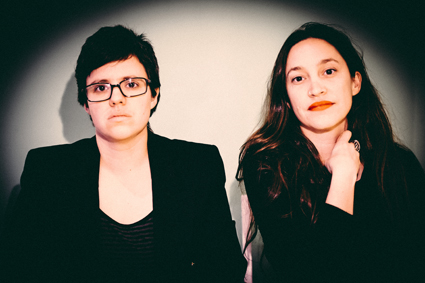
Emma Valente, Kate Davis, The Rabble
photo David Paterson
Emma Valente, Kate Davis, The Rabble
Kate Davis and Emma Valente, artistic directors of The Rabble, have been working as self-funded fringe artists, outside of mainstream funded theatre companies, for nearly 15 years. They both attended Swinburne University of Technology. They formed a company after graduating in 1999 called Self Saucing Pudding and produced about 10 shows under that name; fringe shows that not many people saw. Then Davis moved from Sydney to Melbourne and they decided to form a new company as directors with Sid Brisbane. This company was The Rabble. Valente and Davis responded collectively to my questions.
“We were all directors and we each did something else. Emma did lighting and sound design, Kate designed and Sid acted. It was founded on an idea of collaboration and on helping each other out. We had similar issues and interests. The name came from the idea that we were outside of the centre—this motley crew that didn’t quite fit in anywhere. That has remained true in a lot of ways.
“It was such a great time. We had such ambition to make work and to support each other. We have made eight works in Melbourne and Sydney. Through that time a point of view has developed. We didn’t articulate it at the start but it now seems quite clear. Our work is to do with the representation of gender and the body on stage from a female perspective. We just don’t think gender is a binary construct.”
In The Story of O (MTC, NEON 2013, review RT116) the ringmaster is played by a woman—the stage image is literally carnivalesque with merry-go-round horses and circus costuming. This complicates the power relationships in the piece. The aesthetic is decidedly queer. It occurs to me that the piece is more about carving out a space for difference to be accepted as a fact than it is about women’s liberation. I asked them how they make work.
“We let a lot of source material in during the initial stage—literary texts, academic texts, visual art, graffiti; anything we come across in our world and then we narrow down. We do a lot of preparation before we are in the room. Emma runs the room and talks with Kate about the events of rehearsal outside of the room. It is great to have that reflective process, to be able to talk to each other. A lot of directors work alone but we don’t. We don’t talk ideas much anymore but more through images. We respond to each other abstractly. I think the conversation about ideas has become implicit in how we work and that has been freeing for us. In not starting with a stated idea we don’t feel we have to prove a point or test something. Our conversation is between ourselves initially and primarily, not with the industry or audience.
“We work with a fluid ensemble. Some performers have worked with us for six years now. We choose people from instinct. It’s about getting the mix of personalities right in the room. It’s about someone being right for the process rather than for the part; because the acting can be what they want. They create the role. But they have to improvise into nothing for weeks and weeks before they may know what is going on. Not everyone likes that. You are in the dark for a long time.
“We rarely have philosophical conversations with the performers about the work. [Emma] talks in terms of rhythm and image. It is more like working on a movement piece than a theatre piece for the performers.
“Before Orlando (Malthouse, 2012, RT112) we were insulated from the industry. We were doing our own thing and no one was paying us much attention. We didn’t ever imagine that we would end up at the Malthouse or the MTC. We thought we were carving out a path for someone else. We thought someone would come up behind us and we would have paved a way for them. But it turns out we paved a way for ourselves. But that could easily have not happened. Being at the Malthouse in the Melbourne International Arts Festival in 2012 was the moment we got noticed and found an audience. That was the turning point. We had matured together while no one was noticing. The industry can give people opportunities they are not ready for. We’ve been fortunate that when we got opportunities we were ready. I feel like now we are a part of the industry but our ambition is perhaps slightly different. We really want this to be a company that tours nationally and internationally and to make a living from it.
“We are conscious of the politics and questions provoked by our work. But we come from quite a personal perspective. We know that to do The Story of O is a political act but the reason for doing it was to explore something personal. [Emma] has a problematic relationship with the book. Why is the idea of female sexual submission terrifying? That felt like a question worthy of asking. At a certain point in the process I wondered what O’s story would be at 40 and beyond. She would be put out to pasture. I realised how sad that was. I felt sad that some women want that. It was a sorting out of some crazy demons. It was not about sex but about feeling empty and what people do to try and not feel empty.”
* * *
In two new works The Rabble investigate the cultural legacies of masculinity and its ambiguities. Melbourne International Arts Festival and Theatreworks have commissioned them to create Room of Regret for the 2013 festival. The work is the company’s response to Oscar Wilde’s The Picture of Dorian Gray, “staged in a labyrinthine network of corridors, mirrored passages and disquieting viewing chambers” (press release). In May 2014 in a co-production with Belvoir, The Rabble will present Cain and Abel interpreting “the tale from Genesis and its many iterations—in Milton and Byron, Baudelaire and Baby Jane” (press release).
The Rabble, therabble.com.au. Other works by The Rabble are Special (La Mama Courthouse, 2011), The Bedroom Project (Linden Gallery, 2010), Cageling (45 Downstairs and Carriageworks, 2010), Salome (Carriageworks, 2008; RT85) and Corvus (Carriageworks, 2007).
2013 Melbourne International Arts Festival, The Rabble, Room of Regret, Theatreworks, Melbourne, 22 Oct-3 Nov; Belvoir, The Rabble, Cain and Abel, Sydney, from May 17, 2014
RealTime issue #117 Oct-Nov 2013 pg. 28
© Anne Thompson; for permission to reproduce apply to realtime@realtimearts.net
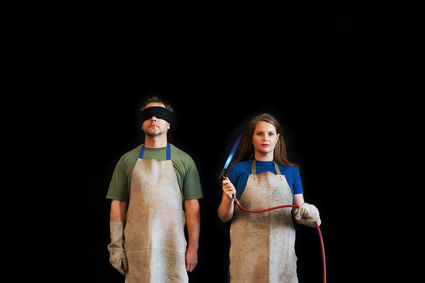
Sarah Elson and audience member, Incendia Lascivio
photo Cameron Etchells
Sarah Elson and audience member, Incendia Lascivio
One-on-one performances have become a key component of the Live Art phenomenon, greeted enthusiastically by audiences eager not to be performed to but to become part of the making of art. The inaugural Proximity Festival in 2012 at Perth’s Blue Room Theatre proved so successful that it is being mounted again this year, inhabiting the known and unknown spaces of PICA in a program curated by Sarah Rowbottam and James Berlyn with Kelli Mccluskey as provocateur.
The curators term the showings “micro-performances,” each running at about 15 minutes. There have been longer, more elaborate one-on-ones performed around the world—perhaps more demanding than short works. But remember, being alone with a stranger in a small space for even a few minutes can be daunting as the phenomenology of presence comes into sudden and sometimes extreme play.
In an email exchange with Rowbottam, RealTime wondered if the appeal of one-on-one was an antidote to the virtual nature of online encounters that so dominate our lives today? One-on-one performance offers surprise, risk and sometimes the engagement of the senses beyond seeing and hearing outside the safe parameters of conventional theatre spaces.
Rowbottam writes, “There is definitely a growing desire for performances that are experiential and activate a live exchange between an artist and audience in the moment. It could be seen as an antidote to our current obsession with negotiating our personal lives electronically…but I feel it can be stripped back to basic human nature—a desire for a sense of intrigue.” She thinks the appeal is to be found in “the play between fiction and reality, honesty and artifice—the risk of being alone in a space with another human being and the unpredictability of what might happen…If you are open and willing, the experience can be quite potent.”
Another virtue of one-on-ones is their sheer diversity, says Rowbottam: “One moment you could be experimenting with plants in a mobile field laboratory with Cat Jones and the next you could be in PICA’s administration office having a consultation with Loren Kronemyer about what you would like to do with your remains.”
A fascinating pre-production dimension to Proximity Festival is the seemingly labour-intensive approach to preparing the artists for their performances. Rowbottam explains that “a key focus is artist development as well as the development and presentation of new work. We curate a cross-section of emerging to established artists from a diverse range of disciplines so there is a great opportunity for artists to learn from each other and experiment with new modes of practice in the creation of intimate participatory exchanges. Performing 96 times to 96 audience members is an exciting, but challenging provocation. Artists need to remain open to a plethora of audience reactions and be prepared to shift and change within the performance parameters they have set. The element of spontaneity keeps things fresh and no performance is ever the same.”
A two-week laboratory prior to the performance season also gives artists the time “to critically explore their work in a supported environment as well as develop their own practice.” Rowbottam writes, “Artist labs are rare in WA, and are so important in creating a sense of collegiality within the artistic community.”
Mindful of tales of one-on-one performances going wrong, does Proximity have a set of protocols for both performers and audiences? Rowbottam responds, “I think there is an inherent fear that as an audience member you will be made to do something you don’t want to do. Although Proximity Festival works are participatory and experiential, they are always by invitation. We warn audience members about potential situations that could be confronting—complete darkness, physical touch, nudity, handling open flames, using fake weaponry etc. It’s a tricky balance between being up-front and not giving everything away.”
Audiences are certainly in for some unusual experiences and subjects rarely approached in the theatre: “In Janet Pettigrew’s work Prior Arrangement audiences can experience a living exploration of their body’s final hours, and in Janet Carter’s Meditation on breath, they are invited to sit face-to-face with the artist and undertake a guided meditation. There needs to be an element of mutual trust and willingness from both audience and performer to partake in the encounter, otherwise it can become muddy.”
Proximity artists are given a set of curatorial guidelines which require having protocols in place for possible audience. Rowbottam is emphatic: “If someone feels at risk or distressed they can stop the performance at any time—this goes for both artist and audience. One of our Symposium panel sessions is centred on what the boundaries of intimacy between audience and performer are, how intimacy is created and how we know when we’ve gone too far. It should make for an interesting discussion.” The Symposium also asks, “how do you program one-on-ones and where is their place in the touring circuit?”
There are also degrees of site-specificity to the 2013 Proximity Festival: “The entire PICA space is dedicated to the program of 12 works, enabling us to explore the entire building as one giant labyrinth. There are numerous hidden or unused spaces in the building which the public don’t usually have entry to or even know exist. Accessing these as performance sites is a real privilege. Holding the event in between PICA exhibitions has “enabled artists to work in-situ, which is a huge benefit for artists like Moya Thomas and Humphrey Bower who are making site-specific and site-responsive works.”
The variety in Proximity’s programming is evident in a brief sampling of the works. Cat Jones and Melissa Hunt’s bizzarely titled The Plantarum: Empathic Limb Clinic is described as “a conversation between the human mind and flora…A sensory experience for those not afraid to experiment with plants. Humphrey Bower’s Asterion is “a blindfolded experience in one of PICA’s most hidden spaces…For those who aren’t afraid of being in complete darkness.” Rachel Arianne Ogle’s Where You End & I Begin, “an intimate dance performance,” asks you to “join the artist in a game of perception, perspective and shifting dynamics. For those who don’t mind being watched or watching another.” In the “instructional performance” Incendia Lascivio by Sarah Elson, you’re invited to “harness the elemental power of fire to rework micro-sculptures of iconic West Australian flora” and in Leon Hendroff and performer Emma Craig’s String Duet, “sit face to face with a puppeteer and bring to life the marionette between you.”
Whether you select from the three programs on offer or bravely undertake a marathon of all 12 performances in the Proximity Festival, you are bound to have encounters that will doubtless tell you something about yourself as well as your relationship with art.
Proximity Festival, co-curator James Berlyn, co-curator, producer Sarah Rowbottam, artists Elise Reitze, Cat Jones, Humphrey Bower, Loren Kronemyer, Rachel Arianne Ogle, Ian Sinclair, Janet Pettigrew, Leon Hendroff, Emma Craig, Sarah Elson, Moya Thomas, Janet Carter, Daniel Nevin; PICA, Perth 23 Oct-2 Nov; http://proximityfestival.com
RealTime issue #117 Oct-Nov 2013 pg. 29
© Keith Gallasch; for permission to reproduce apply to realtime@realtimearts.net
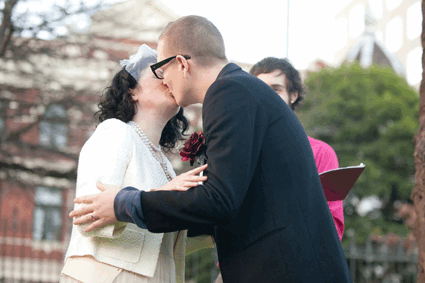
Tahni & Tom, Shotgun Wedding, NO SHOW, Next Wave Festival 2012
Photo Sarah Walker
Tahni & Tom, Shotgun Wedding, NO SHOW, Next Wave Festival 2012
In “The theatre of rehearsing for life” (RT115) playwright Robert Reid reported on a visit to the UK where he researched ‘New Games’ theatre in which audiences become active agents “within constructed narrative environments,” practising “‘ways of being’ in ‘not for real spaces.’” Here he looks at the work of two Melbourne companies who, to varying degrees, directly engage with their audience [Eds].
“I was giddy. It’s the only word for it. I held a manic grin on my face all afternoon. All of these people had come out to celebrate us! There was so much joy in the air, I was wearing a beautiful dress, my nails were freshly painted navy blue to match Naomi’s dress, my make-up was done. I was married! This was my wedding day!” Jane Howard, review, My Shotgun Wedding.
Critic Jane Howard is describing her experience of Melbourne-based company No Show’s work Shotgun Wedding, presented as part of the 2012 Next Wave Festival. Jane reviewed the work in the Real Time E-dition June 26, and, a year later, revisited her experience on her No Plain Jane blog. “I refer to that day, still, as ‘my wedding,’ or ‘the day I got married.’ I go back to Melbourne and am introduced to people who look vaguely familiar: ‘I was at your wedding!’ they tell me.”
Shotgun Wedding can be seen as one of an increasing number of performance works that interrogate, transgress and/or repurpose the relationship between the performer and the observer. Internationally this kind of participatory performance experience is represented by companies and collectives such as Punchdrunk, Coney and Slingshot and locally can be seen in the growth of Live Art and New Games.
With Shotgun Wedding, co-directors Bridget Balodis and Mark Pritchard build a fictional narrative environment out of a familiar social ritual, the wedding, asking their audience to ‘play as if’ the ritual is real. Balodis explains, “A lot of what we worked on with Shotgun Wedding was this idea of ‘You know what to do.’ You know the rules. There’s a lot of assumed knowledge there…When I ask you to come up and read a piece of text you know exactly the kind of tone to give it.”
The ceremony begins with drinks in the church forecourt during which a bride and groom are chosen and taken away for preparation while the rest of us are grouped into guests of the bride or groom. The event moves to a nearby garden where a truncated marriage ceremony is enacted, calling on more participants from the audience to carry out various ceremonial roles (I gave the Bible reading at Jane’s wedding). Once the wedding itself is completed the event moves to the church hall where the audience are presented with everything required to make an instant wedding reception (tables, chairs, drinks, decorations etc) and asked first to set everything up and then, finally, to enjoy the celebration.
No Show creates a narrative space out of which a range of possible stories can emerge. Participants become a playful, but temporary, community and the stories we enact together are shaped by the fictional frame we have agreed to adopt and the relationship structures we pretend to share. Archetypes of character arise and both familiar and surprising narratives emerge out of this space as decisions are made during play. Pritchard explains, “It’s actually about the task…We do tasks that invoke a certain something. With the wedding, we distilled it down to what we felt were some essential tasks or functions or things that happen in weddings across the world.”
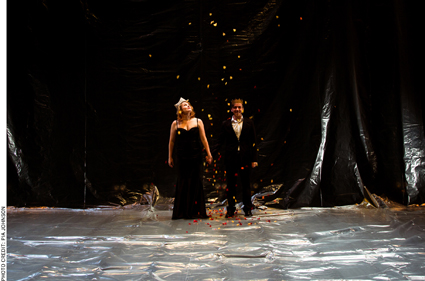
The Hayloft Project, By Their Own Hands, Neon
photo Pia Johnson
The Hayloft Project, By Their Own Hands, Neon
More recently, as part of the MTC’s Neon Festival, The Hayloft Project’s Anne Louise Sarks and Benedict Hardie presented By Their Own Hands, a complex deconstruction of the Oedipus cycle in three acts (see RT116). In the first of these acts Sarks and Hardie invite the audience to join them on stage for a playful storytelling experience which Hardie describes as “a live act of shared imagination.”
Of the three acts, Act One is the only one to take an explicitly playful approach. Sarks and Hardie play the role of storytellers and select individuals from the audience to take the place of key characters in the narrative. In contrast to Shotgun Wedding, this work keeps a much closer hold of the narrative and extends much less agency to its audience (though crucially not to the point of none), instead leading an ‘endowed’ audience (some more endowed than others) through the predetermined narrative.
Hardie explains, “the idea for Act One came from a place of mutual scepticism about ‘audience interaction.’ One of the guiding principles of the framing was to try to make it as non-threatening and non-obligational as possible. People would not be required to do anything. It wasn’t until we started playing with test audiences that we realised how much we would have to deal with those audience members who genuinely wanted to play. The initial focus was on using real people, and all the reality that they bring, as a vessel for communal meaning. It was a step beyond saying ‘Imagine a man’; rather we were saying ‘Here is a man.’”
Once endowed by the storytellers the playing audience members add colour to the characterisations, by their in-the-moment decisions and reactions, which subtly shape the unfolding narrative. Tonight’s Jocasta might slap Oedipus in the face where last night’s might only have stood passively by. Through these individual variations the whole audience’s perception of the narrative is altered.
In Shotgun Wedding each audience member is given relatively free agency within a familiar structure and so makes their own story. By contrast, By Their Own Hands gives its audience strictly limited agency and leads them through an unfamiliar narrative with prompts as to how to react. In both instances participants are given clear instruction on how to contribute meaningfully to the performance event and so are enabled to make offers that guide and shape the narrative.
The inclusion of participants in the progressing performance builds a personal connection, a memory with the power to evoke deeply felt, emotional responses long after. Although experiences of both works are fundamentally manufactured, the feelings provoked and the memories created are genuine and have the emotional impact and lasting recall of the real.
Shotgun Wedding and the first act of By Their Own Hands represent contemporary developments in Australian performing arts practice that reflect an increased interest in the role of the audience as active participant in the shared ritual of performance.
For very different recent examples of audience participation see John Bailey’s review of Side Pony Production’s The Confidence Man in this edition, the preview of Perth’s Proximity Festival and our review of Team MESS’ Bingo Unit (RT116 online).
RealTime issue #117 Oct-Nov 2013 pg.
© Robert Reid; for permission to reproduce apply to realtime@realtimearts.net
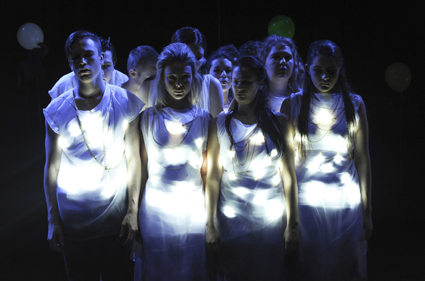
AIM Dramatic Arts, Physical Stages, Lock & Key, 2013
photo Heidrun Löhr
AIM Dramatic Arts, Physical Stages, Lock & Key, 2013
Just across Pitt Street from the RealTime office can be heard sounds of harmony and conflict issuing from the Pilgrim Building (home to the Pilgrim Theatre), where drama students are in training at the Dramatic Arts school. It’s a nice change from screams, curses, car horns and abuse, if sometimes alarming when collective passions are riotously released.
Theatre director Peta Downes, who has performed with Brisbane’s Zen Zen Zo and trained with Anne Bogart, is the new Head of Dramatic Arts (formerly AADA) at the Australian Institute of Music (AIM). She has a vision for greatly enhancing her students’ creativity. “We aim to equip our students with the ability to write a first draft, go to a dramaturg or develop an idea on the floor and get a writer in, as well as being able to work out the finances and use crowd funding. We want them to be employed, and we have a very good track record there, but if not then to create their own work.”
Consequently, Downes sees collaboration as central to actor training. In the concentrated three-years-in-two degree course, teamwork extends to direct engagement with lighting and set design and hands-on backstage experience, with first year students “working on second year productions and learning how to be part of a team.” As well as addressing acting fundamentals, creativity and collaboration, first years engage in scene work and, in the Physical Stages unit, with a physical theatre director.
In the second year “students perform a classic text, construct one of their own in the New Short Works program and work on a ‘given’ text which they produce as well as act in. They will have done Contextual Studies looking at mythology, archetypes and storytelling and will draw on this with the works they’re creating.” A professional director, “probing the world the students are creating,” also works with a student director and dramaturg in each case. Dramaturgy students adapt and correlate material and score physical theatre scripts.
Interestingly none of the current new short works, which have to be imagined, pitched, worked on the floor and scripted with the guidance of director and dramaturg Margaret Davis, is conventional. They are a reworking of the Trials of Azdac in Brecht’s The Caucasian Chalk Circle, and Akio, aimed at a younger audience: “a response to the work of Suzuki Tadashi that also engages with anime as well as with traditional Japanese culture in the form of Kabuki and Noh.” A third short work “responds to Virginia Woolf’s A Room of One’s Own and Orlando as an exploration of the writer’s mind before she decided to end her life.” Downes is emphatic, “Devising is integral to the course.”
Downes describes the two-year Bachelor of Performance course as “vocational, striking a balance between practice and theory and with a practical outcome at the end of each of the six semesters and we seriously address audience development, finances and marketing.”
Many Dramatic Arts graduates have found employment as actors, says Downes, while others have created their own opportunities. She singles out a recent example, Danielle Maas, who with Joseph Kernahan, devised, produced and performed a critically lauded verbatim theatre work, Say Hello First, at Sydney’s Old Fitzroy in July, evidence that the diversity of Dramatic Arts’ approach and its emphasis on building a sense of independence bears fruit.
AIM, Dramatic Arts, http://www.aim.edu.au
RealTime issue #117 Oct-Nov 2013 pg. 31
© Keith Gallasch; for permission to reproduce apply to realtime@realtimearts.net

![1) 7bit Hero; 2) Sha Sarwari, Asylum Seeker; Vidhi Shah and Jeniffer Heng, Flow[er]; 2high Festival](https://www.realtime.org.au/wp-content/uploads/art/70/7091_2high.gif)






![Asiga, [CTRL][P] Objects on Demand](https://www.realtime.org.au/wp-content/uploads/art/70/7096_loop_object.jpg)













































































